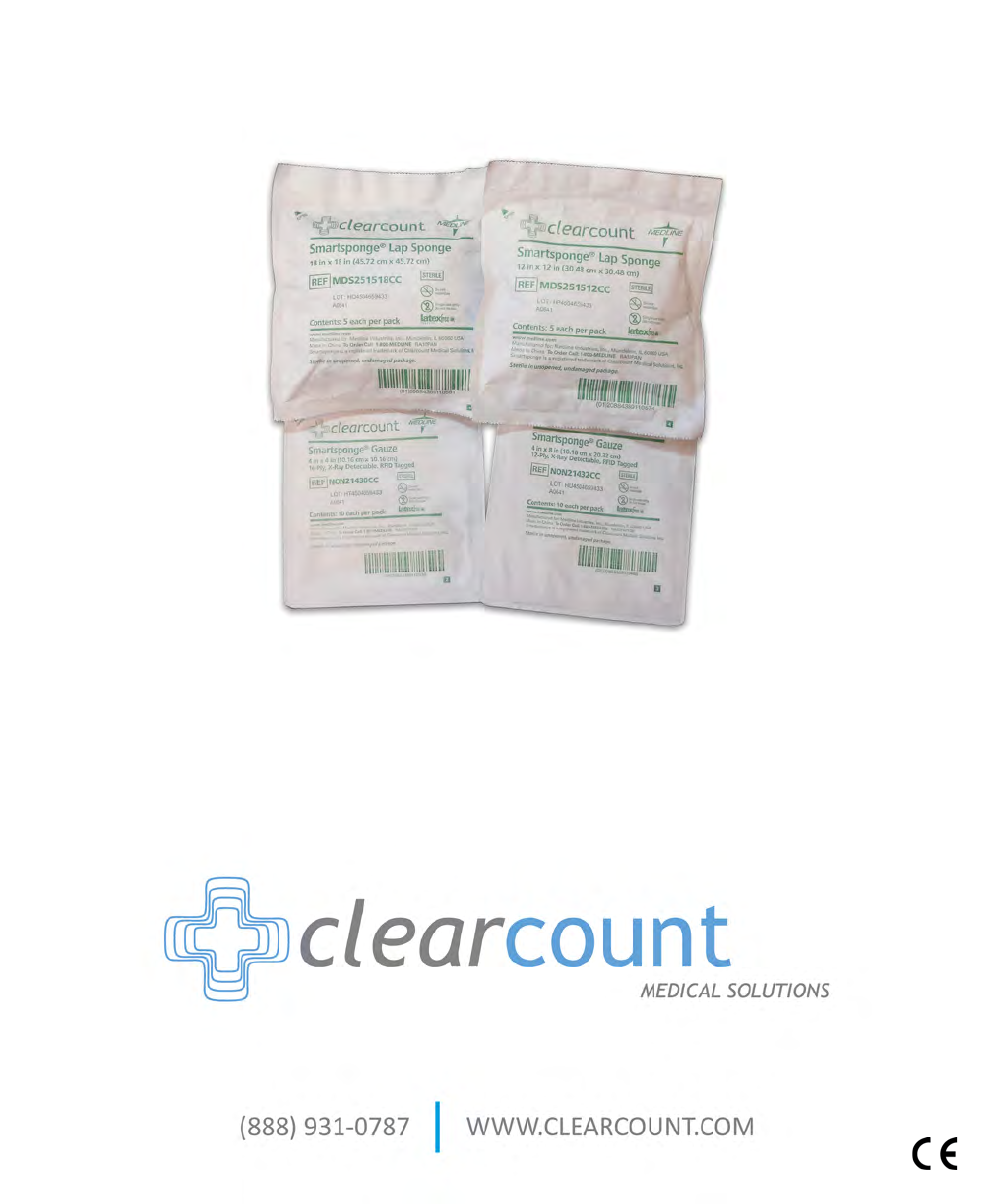ClearCount Medical Solutions CCMS004 SmartSponge Flex Model A04 User Manual LCCD System Manual
ClearCount Medical Solutions Inc. SmartSponge Flex Model A04 LCCD System Manual
User Manual
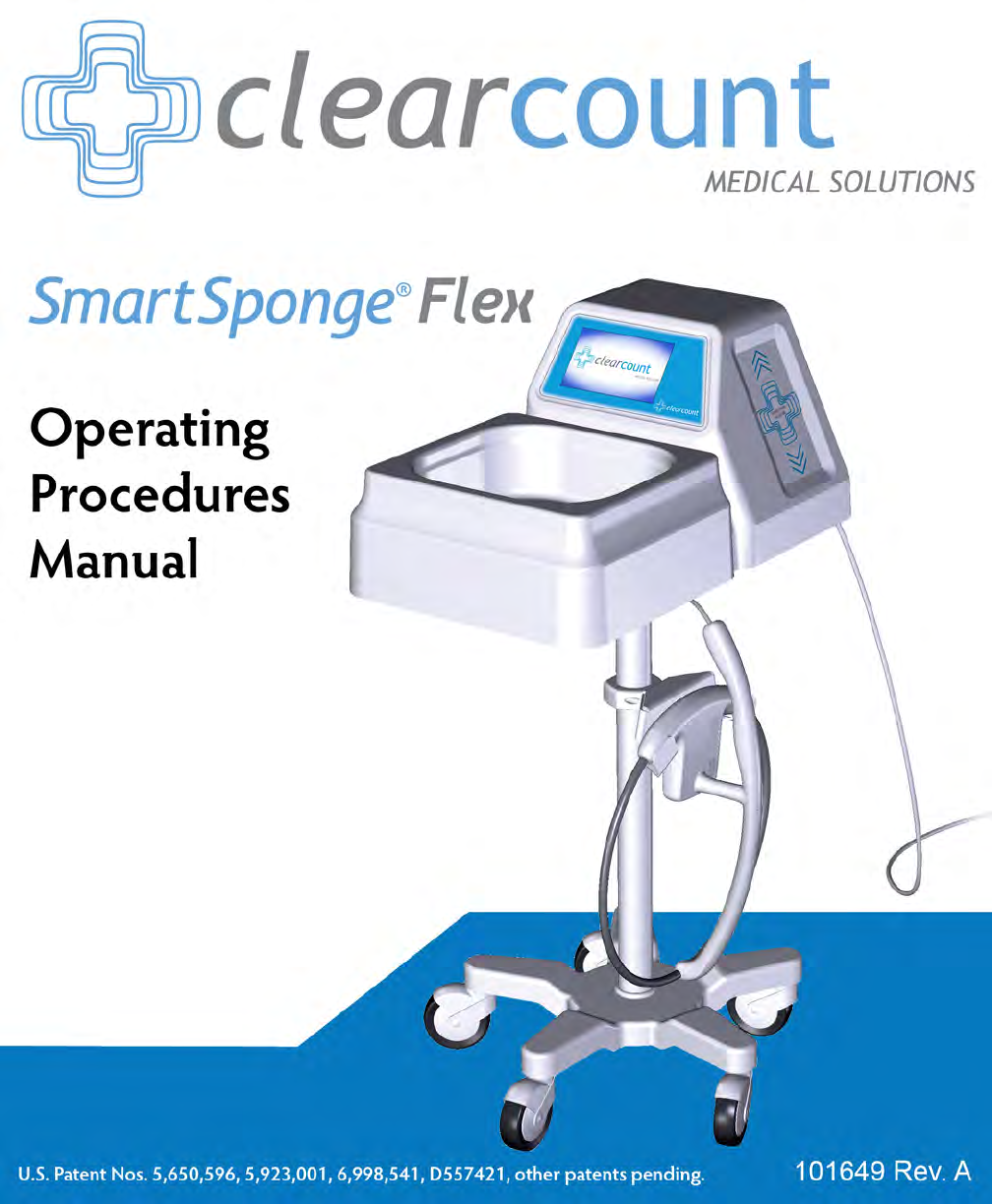

i
•
•
•
•
•
•
• • • • • •
Preface
Indications for Use
The ClearCount Medical Solutions SmartSponge
®
Basin is indicated
for use in counting and
recording the number of RFID-tagged surgical gauze, laparotomy sponges, and towels used
during surgical procedures. It also provides a non-invasive means of locating retained
radio-frequency identification (RFID)-tagged surgical sponges, towels, and other tagged
items within a surgical site.
Warnings
The following list of warnings applies to the SmartSponge Flex:
•
Use only one SmartSponge Flex during a surgical procedure.
•Do not dispose of sponges from a previous surgical case into the Count Out Basin.
Sponge counts may not reconcile properly. Use only sponges from the current surgery.
•
Do not use the system in the presence of a flammable anesthetic mixture with air, or with
oxygen or nitrous oxide.
•
For the system to function, use only ClearCount disposables.
•
Keep the SmartSponge Flex outside of the sterile field, unless it is properly covered.
•
Place only ClearCount disposables in the Count Out Basin.
•
The sterility of disposables is guaranteed only for unopened, undamaged packs.
Disposables are for single use only; do not re-use or re-sterilize disposables.
•
Do not cut or tear ClearCount disposables, as the RFID tags might become separated.
•When scanning items contained in a sterile surgical kit (bundles of items not in their
own sterile packs) into the SmartSponge Flex, cover the system with the sterilized liner
from the surgical kit. This prevents contamination of the items being scanned.
•
Using the wand without a sterile wand cover could contaminate the sterile field.
•Holding items that have been scanned in too close to the Count Out Basin may result
in these items being added to the Out column of the inventory (detected) prior to use
and disposal. Dispose of any items into the Count Out Basin without using them if they
have been counted out prior to use.
•
Disposables should not be left inside the patient's body for more than 24 hours.

ii
•
•
•
•
•
•
•
When using the wand, the system may experience a slight degradation of read range of
RFID tagged items when metal objects are within the scanning field. Small metal objects
like implants and pacemakers will have no impact in most cases. To the extent possible,
remove metal from the scanning site or keep the RFID tags at least ½ an inch from direct
contact with metal objects.
•
Individual sponges or packs of sponges may not correctly count when placed directly on
metal surfaces including back tables, mayo stands, large reusable capacitively-coupled
return electrode pads and metal kick buckets. When using the wand, remove the sponges
from those areas, or provide a separation distance between the metal and the RFID tags so
that the tags can be read.
•
When using a SmartTag in conjunction with a large reusable capactively-coupled return
electrode pad, it is necessary to place the tag lateral to the pad in order for the wand to detect
it. The SmartTag will not be detected if applied directly to the pad because of its metal
interior.
•
While using the wand, interference may appear momentarily on ECG graphs. Users should
be aware that this interference is temporary and will discontinue when the wand is moved
away from ECG equipment or when wand use is discontinued.
•
While using the wand interference may appear on Ultrasound images. Place the device in
Standby while ultrasound imaging is in progress. The device will not lose count when in
Standby.
•
The wand is a tool to assist in the location of tagged items within the body. Use of the wand,
does not guarantee that a tagged item will be detected. Detection depends on proper
technique and a variety of environmental conditions.
•
The orientation of the RFID tags within a body has an effect on the ability to read those tags.
For this reason, proper wand technique should be exercised when searching for tagged
items. Proper technique requires deliberate and thorough scanning through various
orientations. See Chapter 4 of this operators manuals for complete details.
•
Packs of sponges, either partial or complete, may not count when discarded into the Count
Out Basin. If a pack is discarded and fails to read, separate the sponges from each other to
ensure a correct count.
•
Tags may become damaged by surgical lasers. Do not apply a surgical laser directly to a tag.
The loss of tag function may result.
•
Due to possible interference, the system should be separated by at least 1 meter from an
active Electrosurgical Unit (ESU). The system should be checked for normal operation to
ensure there is no interference present.
•
No part of the ClearCount SmartSponge Flex is user serviceable. The system contains no
user replaceable fuses. All Service is to be performed by trained personnel.
•
Cardiac pacers should be set to asynchronous pacing (VOO/DOO) mode prior to patient
scanning with the wand to avoid potential short-term interference.
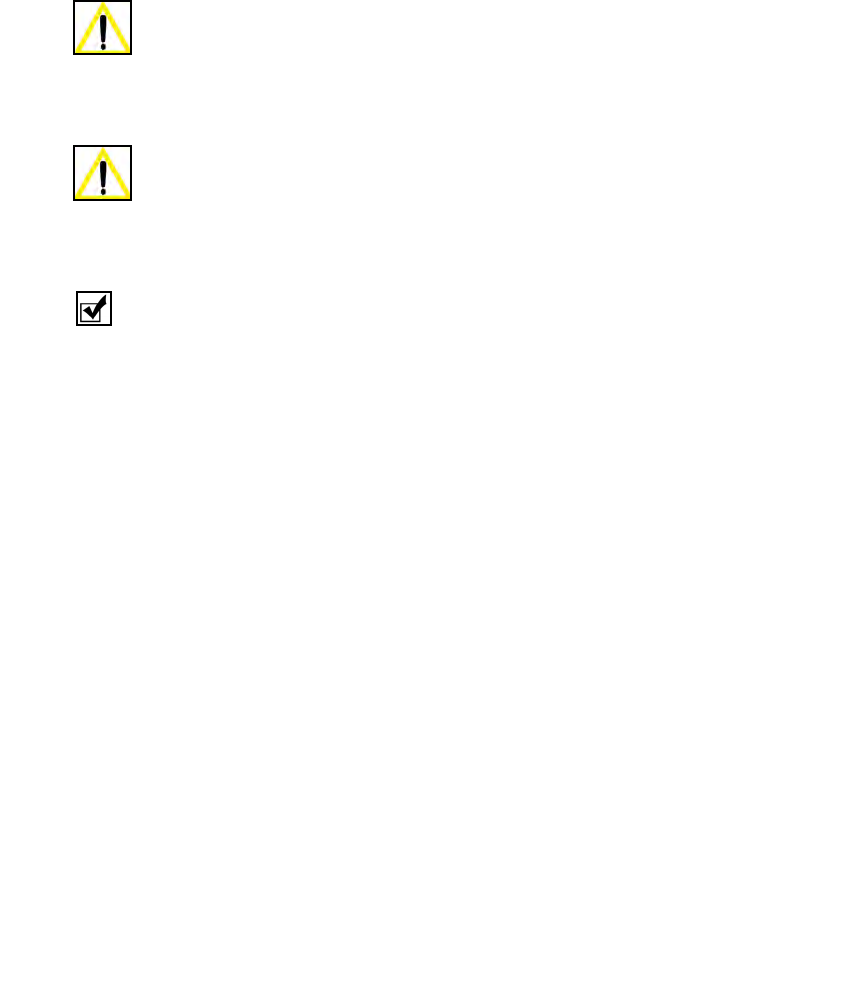
iii
•
•
•
•
•
•
Conventions Used
Warning!
A warning is a statement that identifies conditions or actions that could result in personal
injury or loss of life.
Caution!
A caution is a statement that identifies conditions or actions that could result in damage to
the system.
Notes
A note is an advisory comment or recommendation regarding practices or procedures.

iv
•
•
•
•
•
•

Table of Contents
•
•
•
•
•
•
Preface .............................................................................................................................................................i
Chapter 1: System Description .................................................................................................................. 1-1
Counting System ...................................................................................................................... 1-3
SmartWand .............................................................................................................................. 1-5
Mobile Cart .............................................................................................................................. 1-7
Accessories .............................................................................................................................. 1-9
Chapter 2: System Interface ....................................................................................................................... 2-1
Boot-up Screens ....................................................................................................................... 2-2
Case Selection Screen .............................................................................................................. 2-3
Active-Case Screens ................................................................................................................ 2-5
Chapter 3: Preparing for a New Case ........................................................................................................ 3-1
Powering the SmartSponge® Flex ........................................................................................... 3-2
Placing the SmartTag ............................................................................................................... 3-4
Setting Up for Surgery ............................................................................................................. 3-5
Chapter 4: System Operation ..................................................................................................................... 4-1
Beginning a New Case ............................................................................................................. 4-2
Scanning Items Into Surgery ....................................................................................................4-4
Scanning Items Out of Surgery ................................................................................................ 4-7
Scanning a Patient for Retained Items ................................................................................... 4-17
Ending a Surgical Case .......................................................................................................... 4-24
Restoring Power ..................................................................................................................... 4-30
Chapter 5: System Settings ........................................................................................................................ 5-1
Edit Settings Mode.................................................................................................................... 5-2
Edit Date/Time ......................................................................................................................... 5-3
Adjust Screen Brightness ......................................................................................................... 5-4
Adjust Screen Timeout ............................................................................................................ 5-5
Calibrate Screen ....................................................................................................................... 5-6
Adjust Volume ......................................................................................................................... 5-7
Chapter 6: Review Case Data .................................................................................................................... 6-1
Review Case Data on the System ............................................................................................. 6-2
Chapter 7: Cleaning and Maintenance ....................................................................................................... 7-1
Cleaning Instructions .............................................................................................................. 7-2
Maintenance ............................................................................................................................ 7-3

Table of Contents
•
•
•
•
•
•
Chapter 8: Troubleshooting ....................................................................................................................... 8-1
System Alerts ........................................................................................................................... 8-2
System Warnings ...................................................................................................................... 8-4
System Failure .......................................................................................................................... 8-5
General Troubleshooting .......................................................................................................... 8-6
Appendix A: Technical Specifications ......................................................................................................A-1
SmartSponge® Flex Dimensions ............................................................................................ A-1
Power Requirements .............................................................................................................. A-2
Environmental Conditions .......................................................................................................A-2
ClearCount Sponges and Towels ............................................................................................ A-2
MRI Information .................................................................................................................... A-2
EMC Considerations ............................................................................................................... A-3
Device Label ........................................................................................................................... A-8

1-1
•
•
•
•
•
•
• • • • • •
Chapter 1: System Description
The SmartSponge
®
Flex is used in an operating room to detect and identify tagged surgical items for the
purpose of reconciling surgical counts. It is intended to be used as an adjunct to count policy and procedure
based on AORN Recommended Practices. The system employs radio-frequency identification (RFID)
technology to detect ClearCount SmartSponge surgical gauze, sponges, and towels. The system combines the
benefits of counting and detection of surgical items (gauze, sponges, and towels) used during a surgical case.
It has a user-friendly color touch screen display that provides detailed item counts along with audible
notification. The counts are automatically updated as SmartSponge RFID-tagged sponges and towels are
scanned “in” and counted “out” of the surgical procedure.
This chapter includes a brief overview of the system and a detailed description of its components.
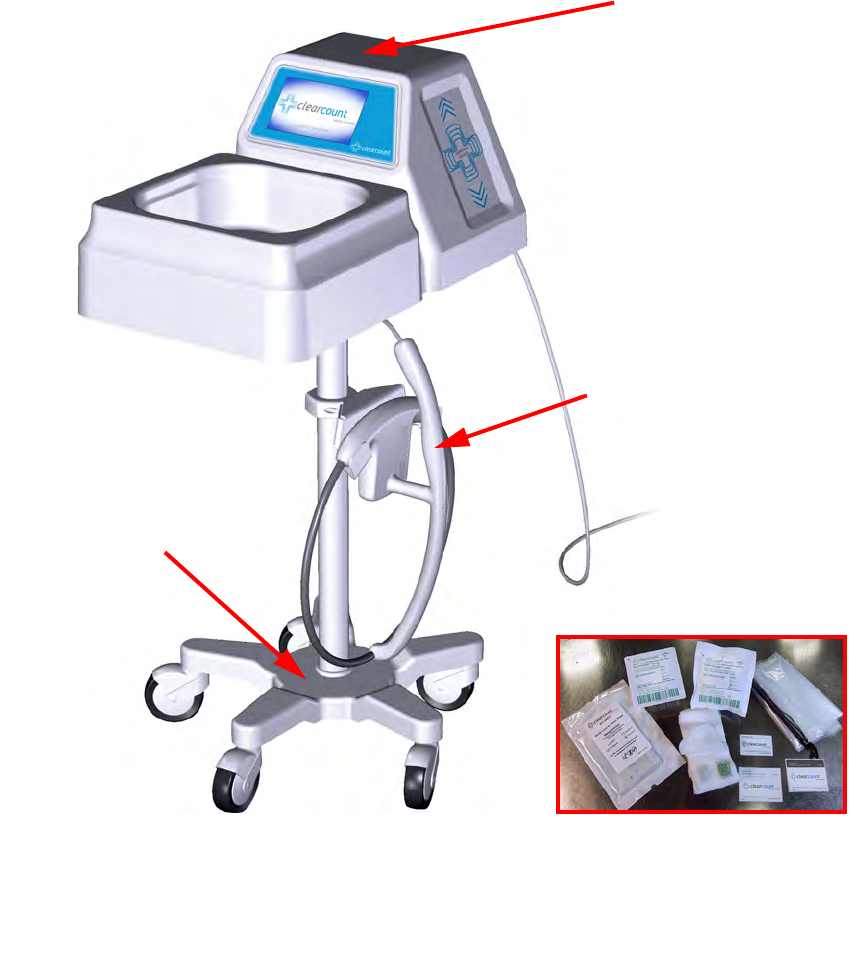
1-2
Chapter 1: System Description
-
•
•
•
•
•
•
SmartSponge Flex System
SmartWand
Counting System
Mobile Cart
Accessories
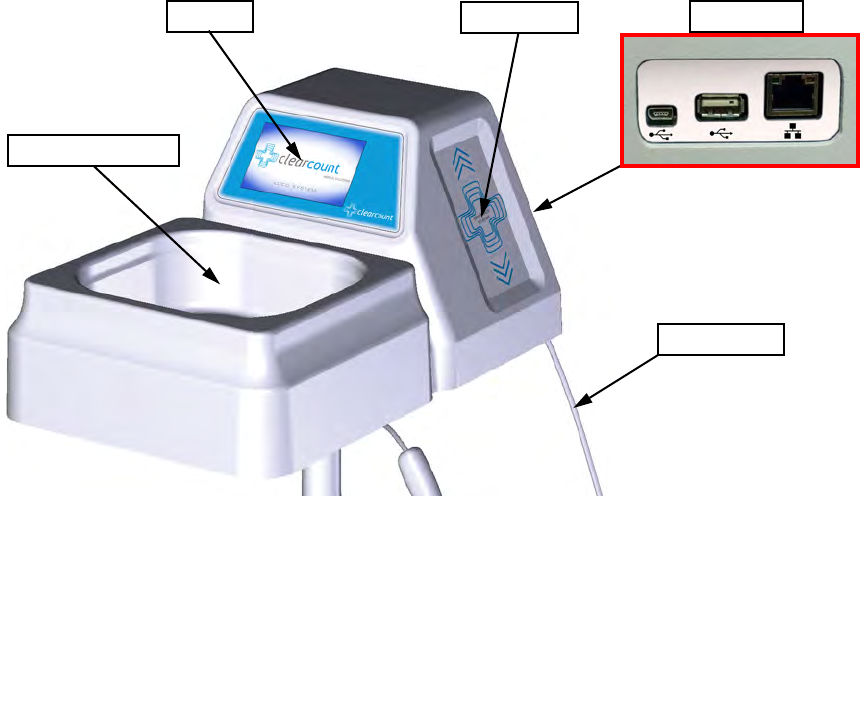
Chapter 1: System Description - Counting System 1-3
•
•
•
•
•
•
Counting System
The SmartSponge Flex utilizes surgical gauze, sponges, and towels that have been “tagged” with an RFID tag.
This RFID tag is about the size of a typical medicine capsule and does not contain a battery. Because each
sponge contains a tag with unique identification, the system can quickly and accurately count and identify each
sponge.
See
Figure 1-1
for the location of the components and
Table 1-1
for the description.
Figure 1-1 Counting System Components
Display
Count Out Basin
In Scanner
Power Cord
Data Ports
ON BACK

1-4
Chapter 1: System Description
-
Counting System
•
•
•
•
•
•
Table 1-1 Counting System Components
Component Description
Display A touch screen that displays information for
the user and provides an interface for
operating the system.
In Scanner The area on which sponge and towel packs
are to be swiped when scanning them into a
surgical case.
Count Out Basin Receptacle to contain the discarded sponges
and towels after their use in surgery that
also counts the items out of the case.
Power Entry and On/Off Switch Connects the system to the power source via
the power cable. The On/Off switch toggles
the power to the system.
Data Ports Used by service personnel to diagnose and
service the system.
Power Cord Supplies power to the system from a wall
outlet.
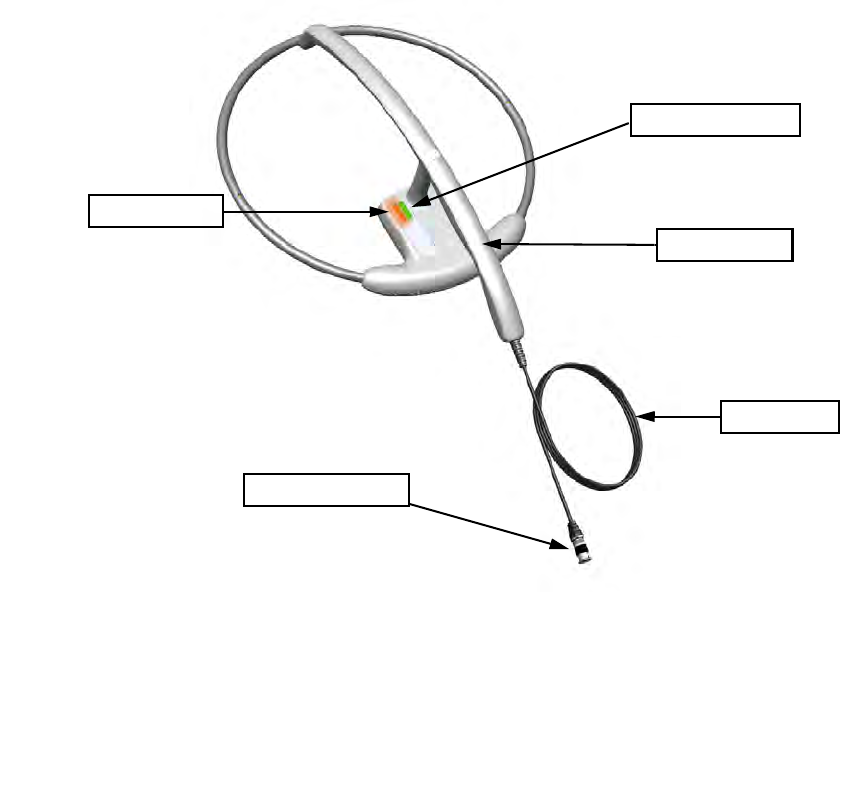
Chapter 1: System Description - SmartWand 1-5
•
•
•
•
•
•
SmartWand
The SmartWand is used for detecting RFID-tagged ClearCount items. The wand can quickly identify tagged
items in and around the patient during a surgical procedure.
See
Figure 1-2
for the location of the components and
Table 1-2
for the description.
Figure 1-2 SmartWand Components
Bi-Color LED
Single Color LED
Wand Handle
Wand Cord
Wand Connector

1-6
Chapter 1: System Description
-
SmartWand
•
•
•
•
•
•
Table 1-2 SmartWand Components
Component Description
Wand Handle Used to hold the SmartWand while the wand
is in use.
Bi-Color LED Changes with the wand’s detection status.
Off - Nothing detected
Solid Blue - SmartTag detected
Solid Amber - SmartSponge being detected
Single-Color LED Changes with the wand’s status.
Solid Green - Wand attached and powered
Off - Wand not attached or not powered
Wand Cord Provides power and communications to the
SmartWand from the SmartSponge Flex.
Wand Connector BNC connector used to connect the wand’s
cord to the SmartSponge Flex.
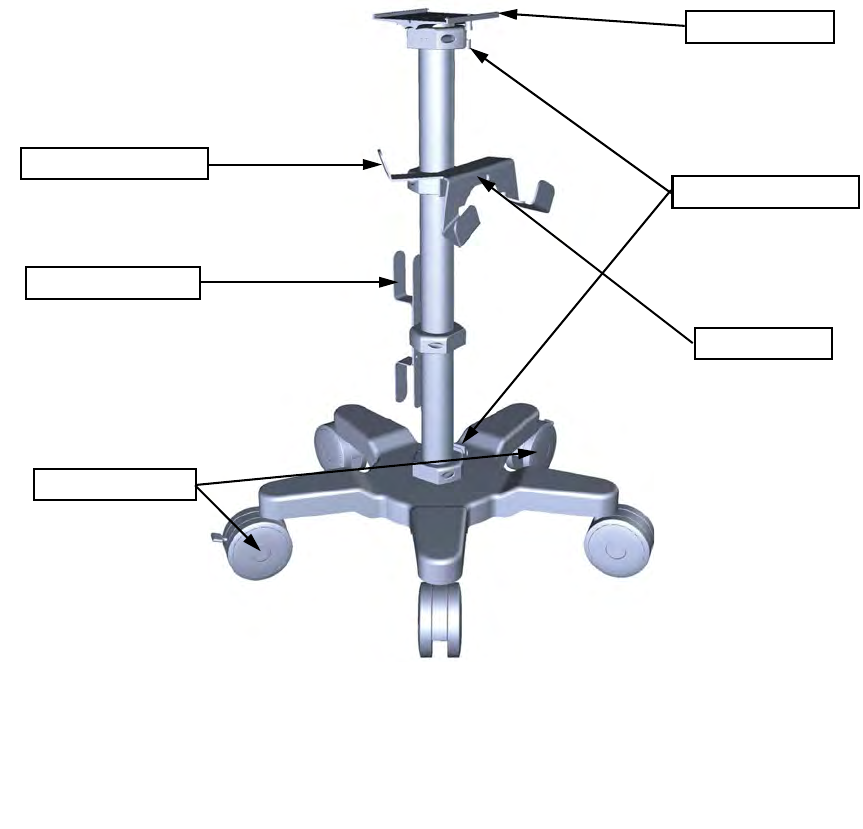
Chapter 1: System Description - Mobile Cart 1-7
•
•
•
•
•
•
Mobile Cart
The Mobile Cart mounts the Counting System and SmartWand. It also manages the system’s power and wand
cables.
See
Figure 1-3
for the location of the components and
Table 1-3
for the description.
Figure 1-3 Mobile Cart Components
Cable Management
System Mount
Locking Casters
Wand Hanger
Power Cord Wrap
Wand Cord Hanger

1-8
Chapter 1: System Description
-
Mobile Cart
•
•
•
•
•
•
Table 1-3 Mobile Cart Components
Component Description
System Mount The plate at the top of the cart used to secure
the SmartSponge Flex to the cart.
Cable Management A series of cable hooks used to route and
secure the power and wand cords.
Wand Cord Hanger Used to retain the wand’s cord while the
wand is being stored on the cart.
Wand Hanger Holds the SmartWand when not in use.
Power Cord Wrap Used to retain any excess power cord while
the system is in use or being transported.
Locking Casters Two of the five casters at the bottom of the
cart have a foot switch to lock them in place.
Used to secure the position of the system.

Chapter 1: System Description - Accessories 1-9
•
•
•
•
•
•
Accessories
Additionally, the SmartSponge Flex relies on several accessories for proper use and patient care. These
accessories are described as follows.
See
Figure 1-4
for an example of the accessories and
Table 1-4
for the description.
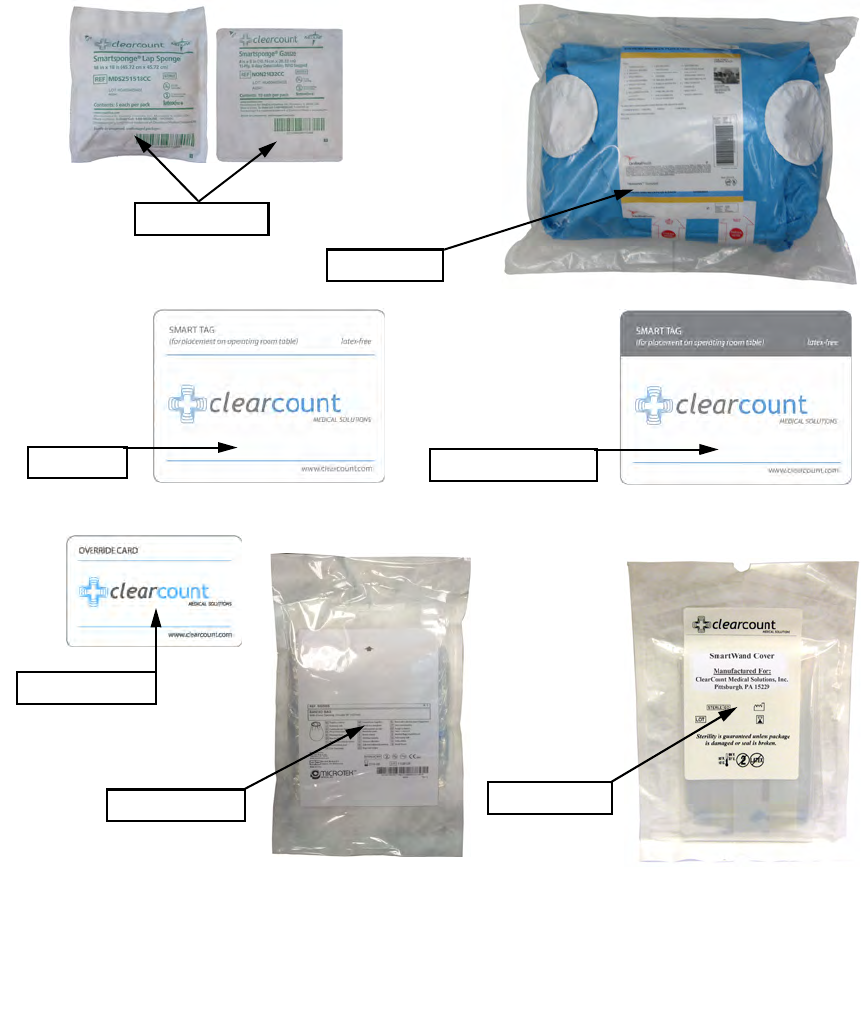
1-10
Chapter 1: System Description
-
Accessories
•
•
•
•
•
•
Figure 1-4 Accessories
Surgical Kit
Sterile Packs
SmartTag SmartTag Special
Override Card
Wand Cover
System Cover

Chapter 1: System Description - Accessories 1-11
•
•
•
•
•
•
Table 1-4 ClearCount Disposables and Accessories
Accessory Description
Sterile Packs Individual sterile packs of surgical sponges tagged
with ClearCount RFID tags.
Surgical Kits A pre-packaged sterile kit of materials and equipment
assembled for a specific surgery. Included are various
banded packs of SmartSponges for use with the
SmartSponge Flex.
SmartTags An adhesive backed RFID tag applied between the
sheets of the OR table prior to surgery, which allows
the user to ensure that the SmartWand is operational.
(SmartTag Special is for use with carbon fiber top OR
tables only)
Override Card A Smart Card used by the authorized staff member to
enable an un-reconciled case to be closed and to
access the system settings menu.
Wand Cover A large, sterile, clear plastic sheath used to protect the
sterile field when using the SmartWand. The sheath
covers the wand and a portion of the wand cord.
System Cover A large plastic bag used to protect the system and
basin from contamination as soiled sponges are
discarded. Sterile when provided in surgical kits.

1-12
Chapter 1: System Description
-
Accessories
•
•
•
•
•
•

2-1
•
•
•
•
•
•
• • • • • •
Chapter 2: System Interface
This chapter presents an overview of the various screens, and navigation features for the SmartSponge Flex.
These include the following:
•
Boot Up Screens
•
Splash Screen
•
Self Diagnostics Screen
•
Case Selection Screen
•
Past Cases
•
New Case
•
Settings Screen
•
Volume Screen
•
Active-Case Screens
•
Standby Screen
•
Count In Screen
•
Count Out Screen
•
Wand Screen
•
Case Summary Screen
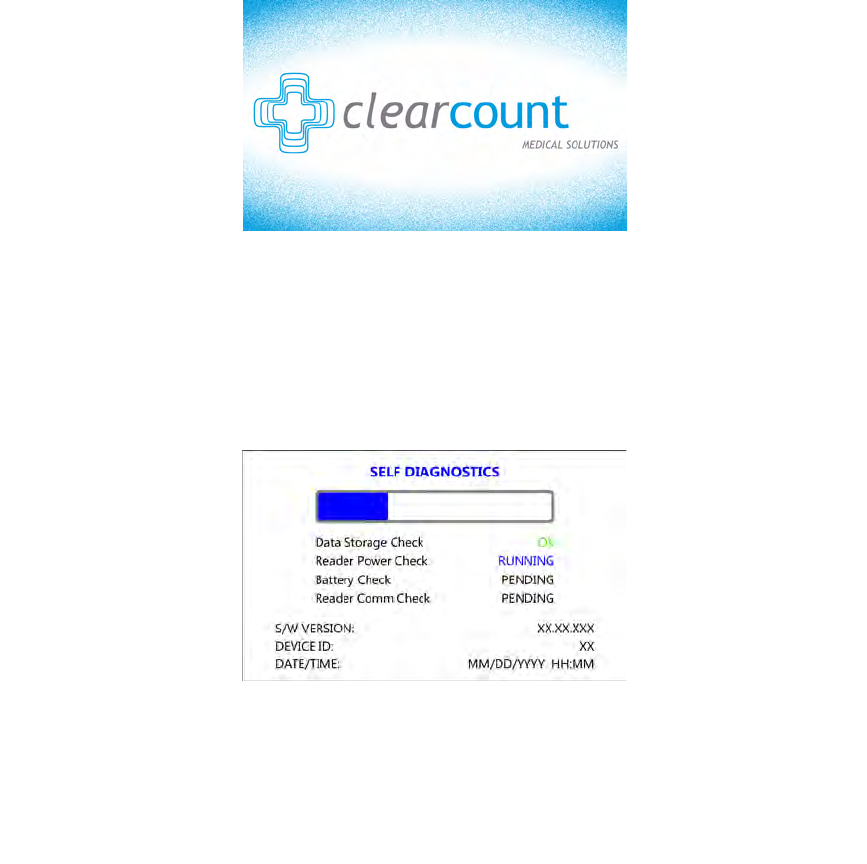
2-2
Chapter 2: System Interface
-
Boot Up Screens
•
•
•
•
•
•
Boot Up Screens
These screens appear for brief periods when the system is powered on.
Splash Screen
The Splash screen is the first thing displayed when the system is powered on. It will appear for a few seconds.
Figure 2-1 Splash Screen
Self Diagnostics Screen
The Self Diagnostics screen follows the Splash screen when the system boots up. The system displays this
screen while key components are checked. Their status is displayed on the screen. The system’s firmware
version and device ID are also displayed on this screen. This screen is displayed for about a minute and the
remaining time is illustrated by the progress bar at the top.
Figure 2-2 Self Diagnostics Screen
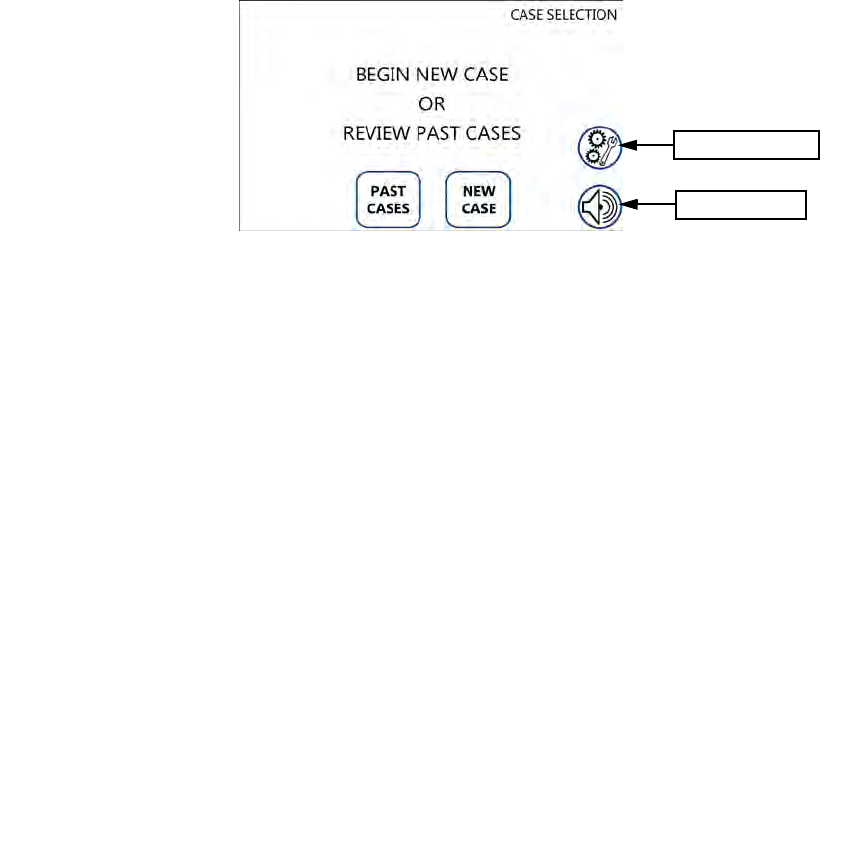
Chapter 2: System Interface - Case Selection Screen 2-3
•
•
•
•
•
•
Case Selection Screen
The Case Selection screen will be displayed after the self diagnostics have finished. From this screen, you have
the option to start a new surgical case, review past case data, edit the system settings, or adjust the system
volume. These features are described below:
Figure 2-3 Case Selection Screen
PAST CASES
Pressing the PAST CASES button from the Case Selection screen will display the Case Review screen. From
this screen you have the option to select from past cases and review the data. Pressing the BACK button returns
to the Case Selection screen.
Refer to Chapter 6 for a description of reviewing case data.
NEW CASE
Pressing the NEW CASE button from the Case Selection screen initiates a new surgical case.
Refer to Chapter 4 for a description of starting a new case.
VOLUME ICON
SETTINGS ICON
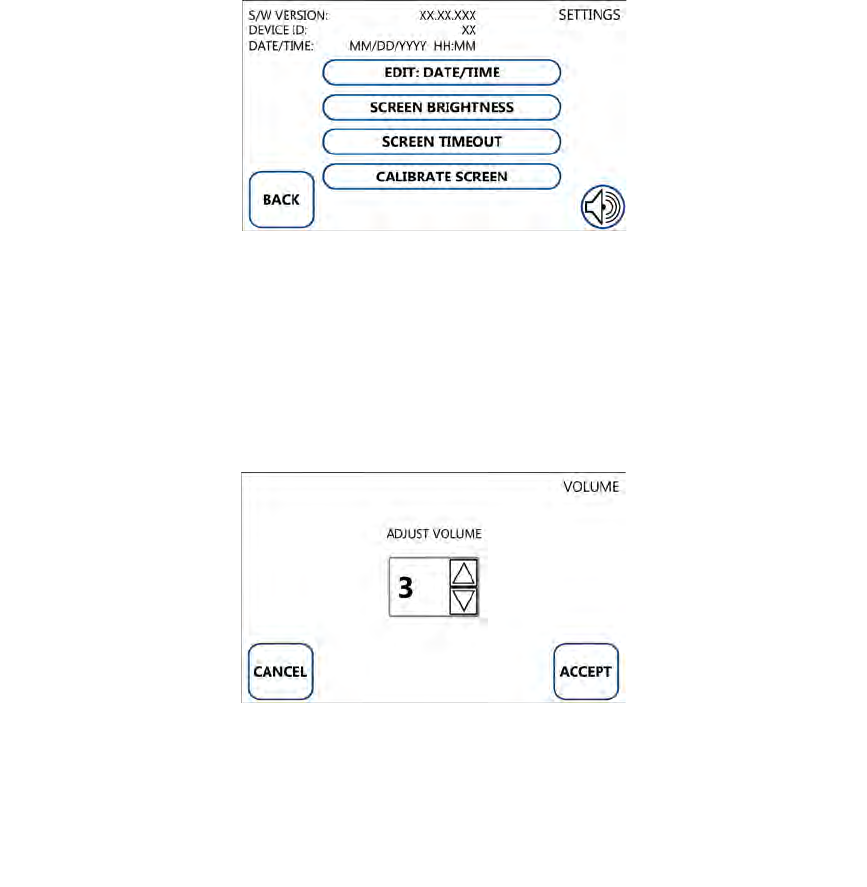
2-4
Chapter 2: System Interface
-
Case Selection Screen
•
•
•
•
•
•
SETTINGS Screen
The Settings screen appears after pressing the settings icon from the Case Selection screen. From this screen,
you have the option to select from a list of adjustable settings. When finished, press the BACK button to return
to the Case Selection screen.
Refer to Chapter 5 for a description of editing the system’s settings.
Figure 2-4 Settings Screen
VOLUME Screen
The Volume screen appears after pressing the volume icon from the Case Selection screen. From this screen,
you have the ability to adjust the system volume. The system volume has a range from 0 (off) to 10 (loudest).
When finished press the BACK button to return to the Case Selection screen.
Refer to Chapter 5 for a description of adjusting the system’s volume.
Figure 2-5 Volume Screen
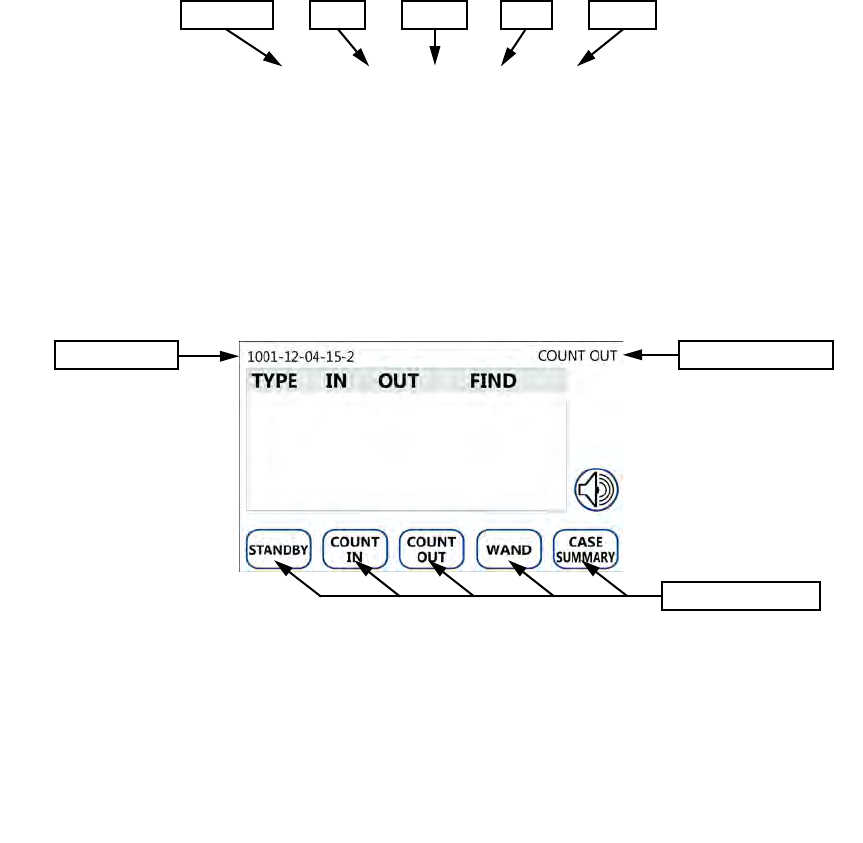
Chapter 2: System Interface - Active-Case Screens 2-5
•
•
•
•
•
•
Active-Case Screens
Active-Case screens are present during a surgical case. They are initiated after pressing the NEW CASE button
from the Case Selection screen.
When in an active surgical case, the current case number is displayed in the upper left corner of the screen and
the current mode is displayed in the upper right corner of the screen.
The
Case Number
follows a format of:
Five navigation buttons are presented at the bottom of the screen that allow you to switch between modes.
These modes are Standby, Count In, Count Out, Wand and Case Summary. Each mode is briefly described
below.
Figure 2-6 Example of an Active Surgical Case Screen
Device ID
XXXX-YY-MM-DD-ZZZ
Year Month Day Case#
Mode of Operation
Case Number
Navigation Buttons
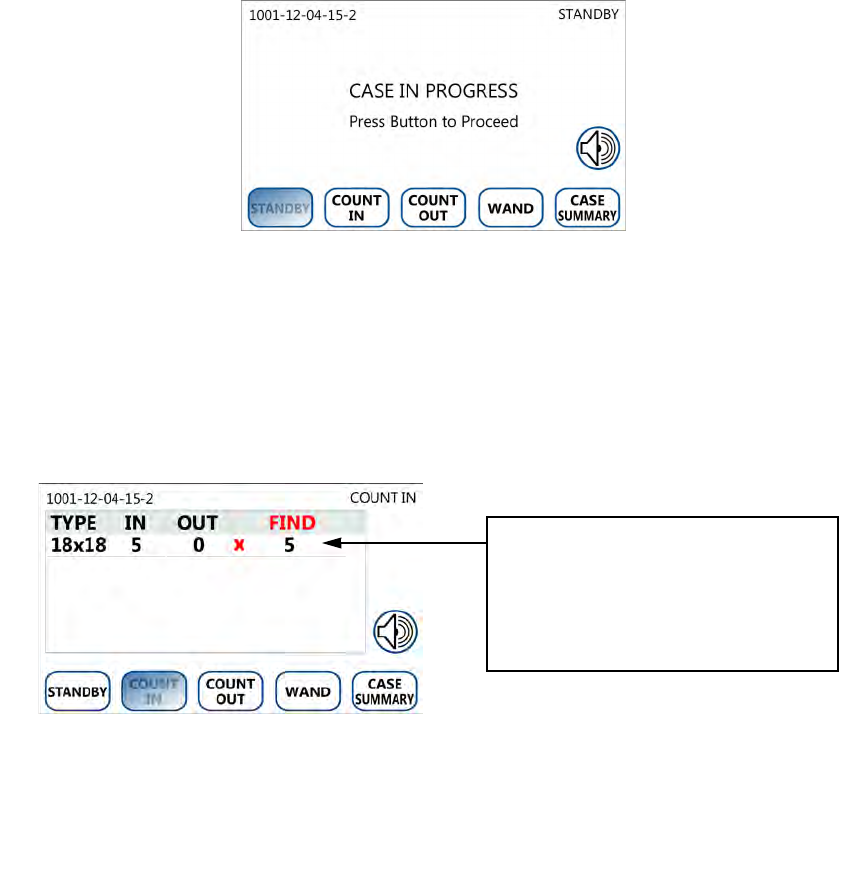
2-6
Chapter 2: System Interface
-
Active-Case Screens
•
•
•
•
•
•
Standby Screen
The system defaults to Standby mode when a new surgical case is started and the Standby screen is displayed.
All antennas are off while in Standby. The system will not count sponges into or out of the surgical case while
in Standby. The purpose of Standby is to allow the system to stay inactive while not in use. You can switch to
any other mode from the Standby screen with the navigation buttons along the bottom of the screen.
Refer to page 4-3 for a description of Standby mode.
Figure 2-7 Standby Screen
Count In Screen
The Count In screen is displayed while in Count In mode. Count In mode is used for scanning packs of sponges
into the surgical case. The In Scanner’s antenna actively looks for sponge packs while in Count In mode.
Sponge packs that are swiped across the In Scanner will be added to the In column of the onscreen sponge
counts. Both the wand and basin antennas are off during Count In mode
Refer to page 4-4 for a description of Count In mode.
Figure 2-8 Count In Screen
In the example to the left, a pack of
5
18x18
lap sponges has been
scanned
in
. This adds
5
sponges to the
IN
and
FIND
columns.
IN
represents the total of
that type and
FIND
represents how
many of that type are still in use.
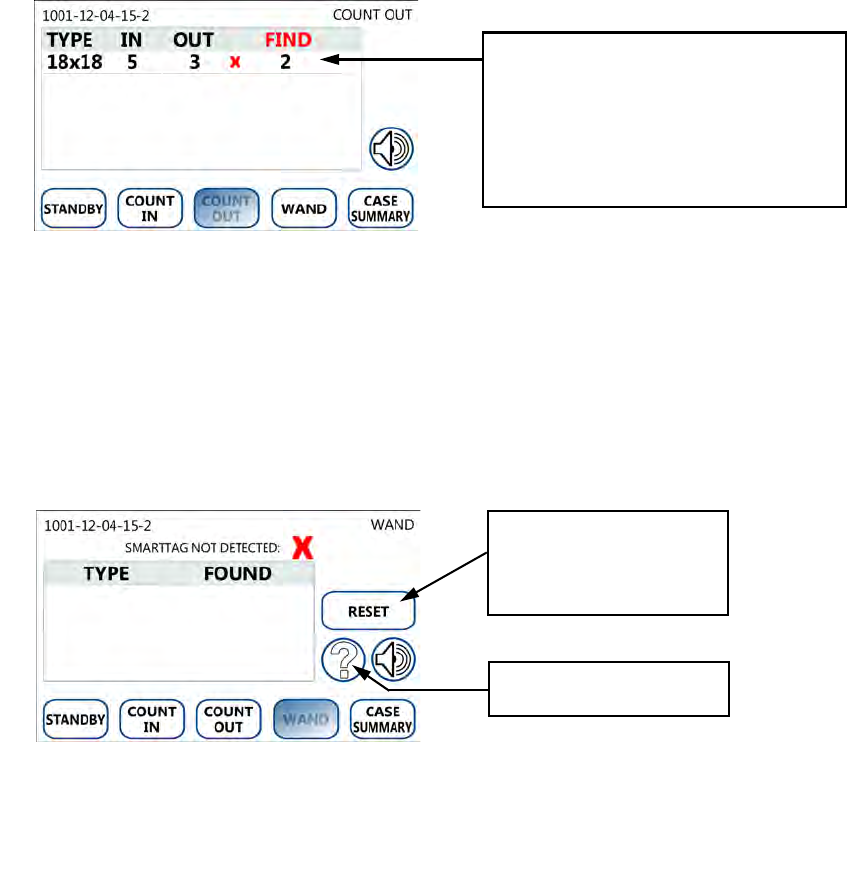
Chapter 2: System Interface - Active-Case Screens 2-7
•
•
•
•
•
•
Count Out Screen
The Count Out screen is displayed while in Count Out mode. Count Out mode is used for scanning sponges
out of the surgical case that are discarded into the Count Out Basin. The Count Out Basin’s antennas are only
active while in Count Out mode. Sponges that are scanned out will increase the Out column of the onscreen
sponge counts and the Find column will subsequently decrease.
Refer to page 4-7 for a description of Count Out mode.
Figure 2-9 Count Out Screen
Wand Screen
The Wand screen is displayed while in Wand mode. Wand mode is used for detecting sponges with the
SmartWand. Detected sponges will be displayed in the “FOUND” column onscreen. These detected sponges
are not counted into or out of the surgical case. The SmartWand is also used to scan a SmartTag if you have
placed one underneath the patient before the surgery. The detection status of the SmartTag is displayed on the
Wand screen. You’re also able to press the HELP icon in the bottom right of the screen for an illustration that
describes the patient scanning procedure.
Refer to page 4-17 for a description of Wand mode.
Figure 2-10 Wand Screen
In the example to the left,
3
18x18
lap
sponges have been
scanned out
by the
Count Out Basin while in Count Out
mode. This adds
3
sponges to the
OUT
column and subtracts
3
from the
FIND
column.
OUT
represents the total of that
type that have been counted out.
The
RESET
button clears
all of the detected items
from the screen (including
the SmartTag).
The
HELP
icon brings up
the Wand Help screen
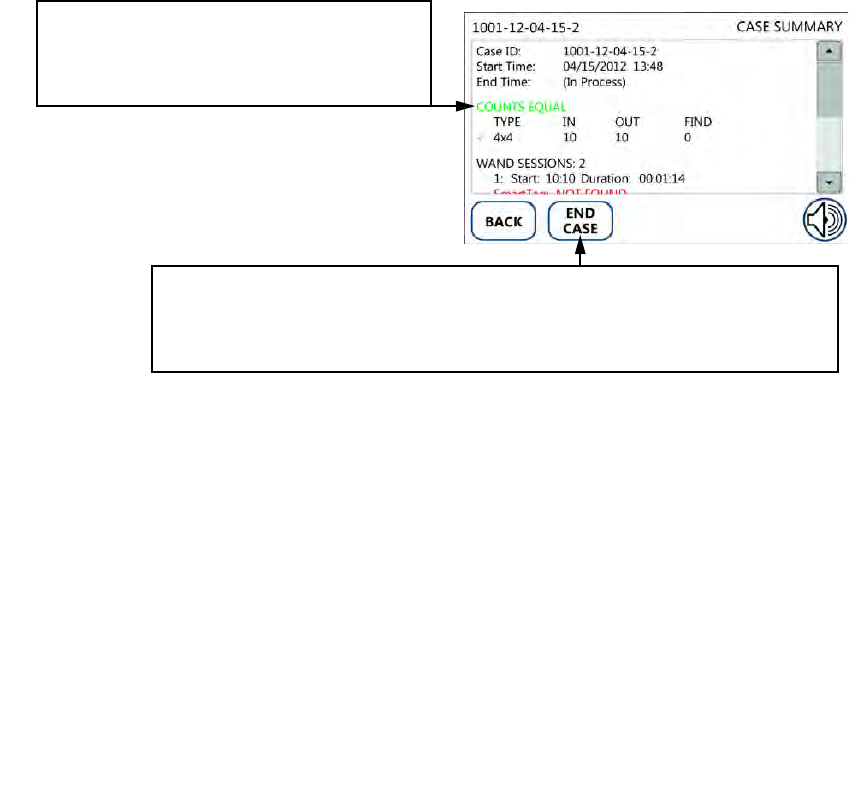
2-8
Chapter 2: System Interface
-
Active-Case Screens
•
•
•
•
•
•
Case Summary Screen
The Case Summary screen is displayed while in Case Summary mode. Case Summary displays information
about the current case and sponge counts at the time Case Summary is entered. Press the CASE SUMMARY
button at the bottom right corner of the screen to enter the Case Summary. From this screen, you can close out
a reconciled case by pressing END CASE or override an unreconciled case with an Override Card by pressing
OVERRIDE. You may also navigate back to the previous mode by pressing the BACK button. All antennas
are off while in the Case Summary.
Refer to page 4-24 for a description of Case Summary.
Figure 2-11 Case Summary Screen
The
END CASE
button will be presented if the sponge counts are reconciled.
Pressing it ends the case. The
OVERRIDE
button will be presented if the counts
are not reconciled. Pressing it brings up the Override screen for scanning an
Override Card and ending a case with unreconciled counts.
The Count Status will display “COUNTS
EQUAL” if all sponges are reconciled. If any
are missing when Case Summary is entered,
“COUNTS NOT EQUAL” will be displayed.

3-1
•
•
•
•
•
•
• • • • • •
Chapter 3: Preparing for a New Case
Chapter 3 describes the initializing the SmartSponge Flex for a new case. This includes the following topics:
•
Powering the SmartSponge Flex
•
Boot-Up Sequence
•
Placing the SmartTag
•
Setting Up for Surgery
•
Using Pre-Packaged Sterile Surgical Kits
•
Using Individual Sterile Sponge Packs
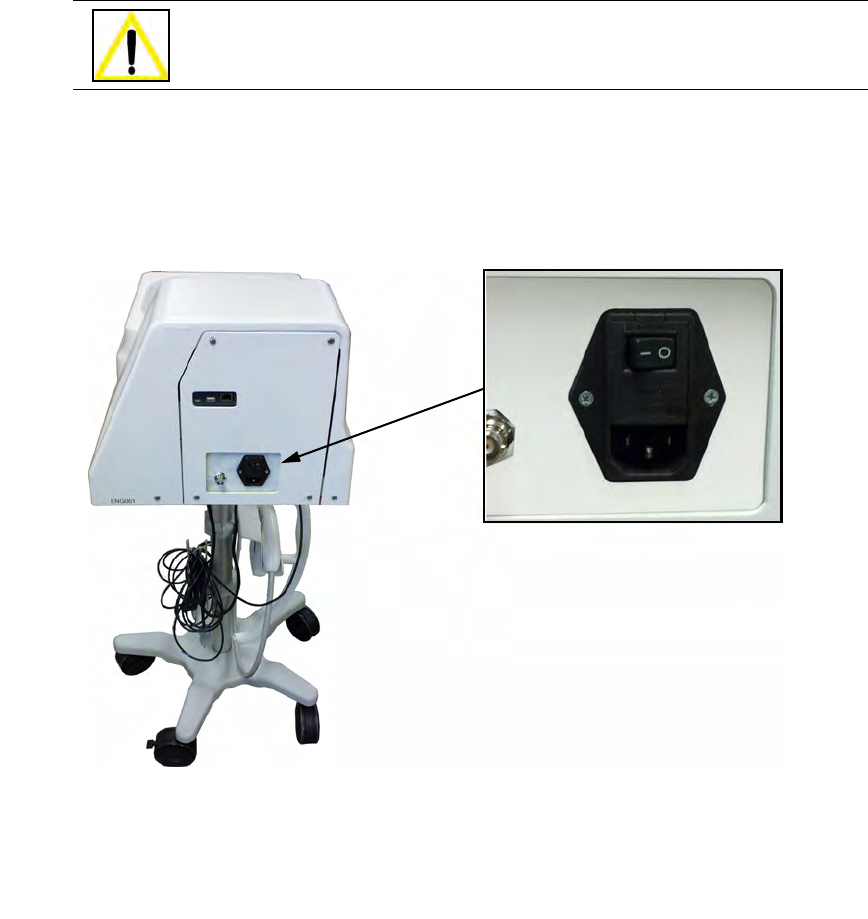
3-2
Chapter 3: Preparing for a New Case
•
•
•
•
•
•
Powering the SmartSponge Flex
The following procedure describes how to set up the SmartSponge Flex before each surgical case.
Place the SmartSponge Flex in the desired position in the Operating Room (OR) and lock the two locking
casters at the base of the cart.
Step 1 Connect the system to a grounded, power outlet using the power cord supplied.
Step 2 Check that the other end of the power cord is securely plugged into the power entry module of
the system.
Step 3 Set the power ( | / O ) switch shown in Figure 3-1 below to the On ( | ) position. There will be
an audible tune and splash screen that briefly appears on the display after the switch is flipped.
Figure 3-1 Location of On/Off Switch
Warning!
Inspect the power cord prior to each use, and replace it if damaged. A frayed or worn
cord presents an electrical shock hazard that may result in personal injury or death.
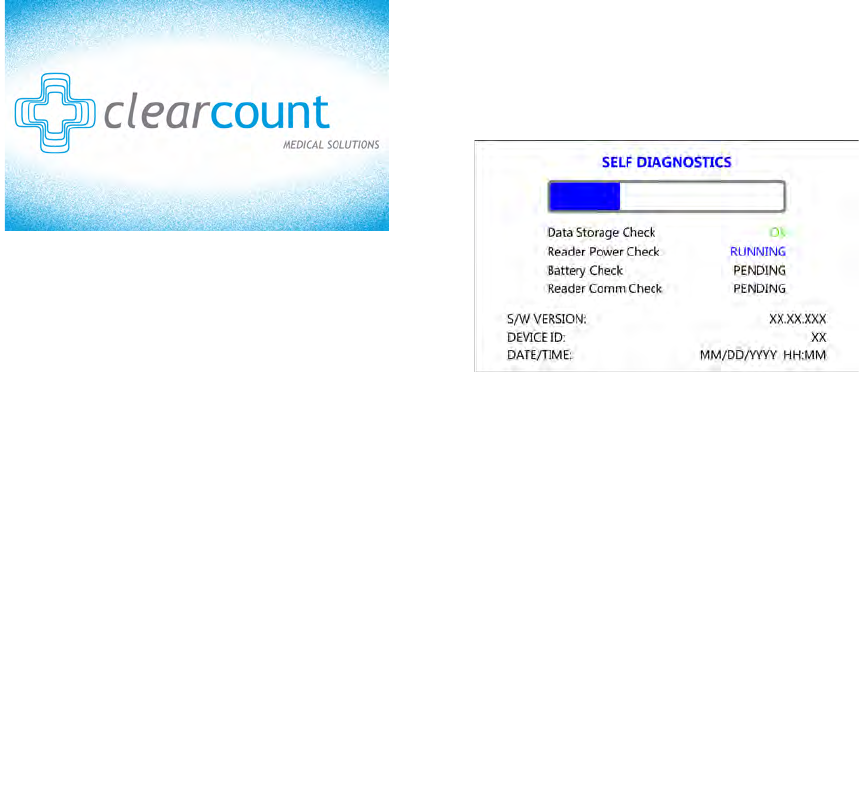
Chapter 3: Preparing for a New Case 3-3
•
•
•
•
•
•
Boot-Up Sequence
The Splash screen, shown at the top left of Figure 3-2, appears on the display first for a few seconds after
the On/Off switch is set to On.
The Self Diagnostic screen, shown at the bottom right of Figure 3-2, is displayed for about a minute
directly after the Splash screen and shows a Progress Bar that fills in from left to right. The screen shows
the versions of system firmware, device ID, and system time. Functional status is also checked during
this self test and the results are displayed. When complete, the system enters the Case Selection screen.
Figure 3-2 Boot-Up Screens
The Case Selection screen is displayed after the system successfully completes the self diagnostic checks.
Press NEW CASE to begin a new surgical case.
Splash Screen
Diagnostic Screen
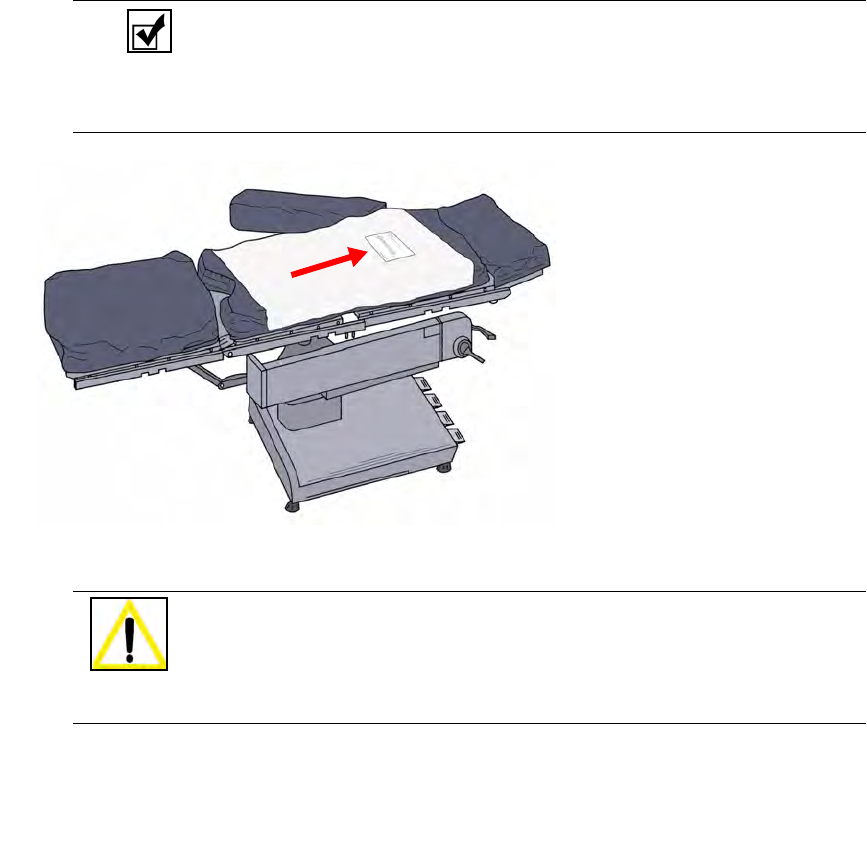
3-4
Chapter 3: Preparing for a New Case
•
•
•
•
•
•
Placing the SmartTag
Before the start of a surgery, place a SmartTag between the surgical sheets under the patient. The standard
SmartTag is to be used on phenolic top OR tables while the SmartTag Special is for use with carbon fiber top
OR tables.
Figure 3-3
shows a SmartTag and its typical placement.
The SmartTag is an adhesive sticker that contains a radio-frequency identification (RFID) tag. This tag
provides feedback to the SmartSponge Flex that the SmartWand is reading through the depth of the patient
when a scan is performed.
During pre-surgery setup, proceed
to place the SmartTag as follows:
Step 1 Peel the backing from the
SmartTag.
Step 2 Position the SmartTag below
the surgical site and apply
between the bottom sheet and
the draw sheet.
Step 3 Place the tag adhesive-side
down.
Figure 3-3 SmartTag Placement
Notes
•
If the wrong SmartTag is used on the wrong type of table, it will perform
improperly.
•
Do not reuse SmartTags after they’ve been applied to the OR table sheets.
SmartTags are a disposable one-time-use item.
Warning!
•
The SmartTag is not approved for application to the patient’s skin.
•
The SmartTag will not be detected if applied directly to a large reusable
capacitively-coupled return electrode pad because of its metal interior. Place the
tag lateral to the pad in order for the wand to detect it.
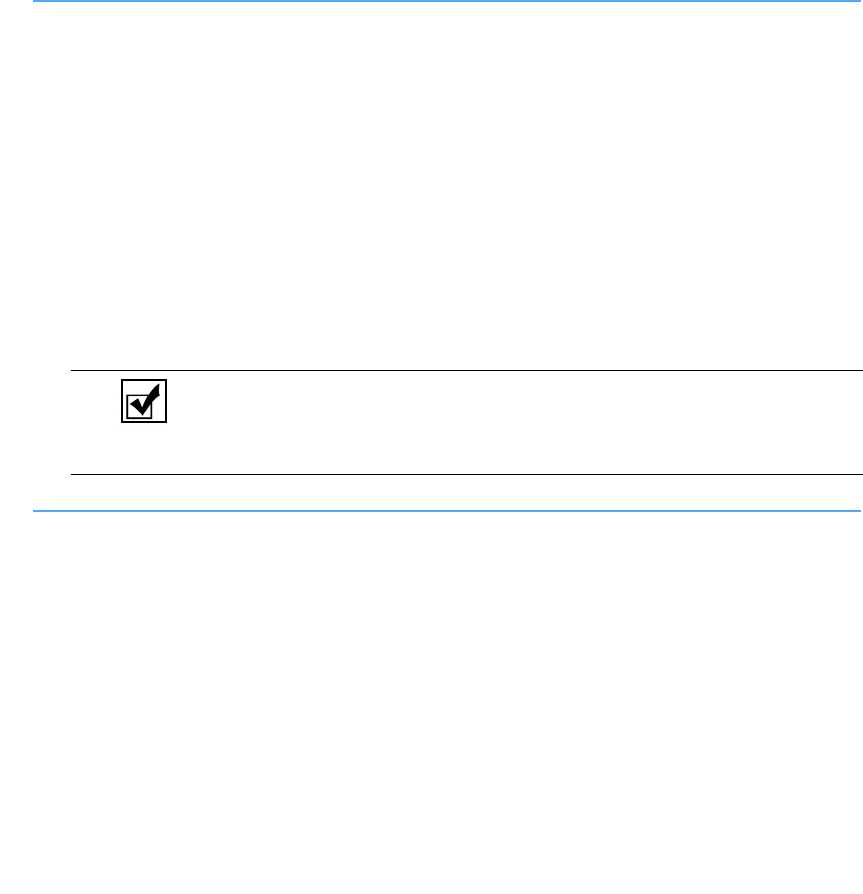
Chapter 3: Preparing for a New Case 3-5
•
•
•
•
•
•
Setting Up for Surgery
With the system in position, and the SmartTag placed between the sheets on the OR table, you are ready to
prepare the sponges and other supplies necessary for surgery. ClearCount sponges must be used with the
SmartSponge Flex. These may either be packs of ClearCount sterile sponges, or ClearCount sponges supplied
in sterile surgical kits. The procedure for using one type versus the other is slightly different, as noted below.
Using Pre-Packaged Sterile Surgical Kits
Step 1 Locate and open the surgical kit. Using sterile technique, locate the following components:
•
System Cover
•
Wand Cover - this should be set aside within the sterile field in case the patient is scanned for
sponges with the SmartWand.
•
Surgical sponges and towels - these will be contained within a paper band. Banded sponges
should be scanned in one bundle at a time. Do not remove the band until the bundle has been
scanned in.
Step 2 Move the system adjacent to the sterile field.
Step 3 Using aseptic technique, cover the entire system with the System Cover. Make sure the entire
system is completely covered. Proceed to scan sponges and towels into the surgical case.
Step 4 After the sponges and towels have been scanned in, the system can be placed in the desired
mode and location for continuing the case.
Using Individual Sterile Sponge Packs
Step 1 Locate the following items:
•
Initial sponges and towels that will be used in the surgical case
•
System Cover
•
Pre-packaged sterile wand cover - this will be used if the patient is scanned with the SmartWand.
Step 2 Drape the System Cover over the SmartSponge Flex.
Step 3 Scan in sponges and towels while still in their sterile packaging.
Step 4 Continue by placing the system in the desired mode for continuing the case.
Notes
•If a bundle of sponges within the surgical kit is damaged or unable to be
scanned into the surgical case, replace that bundle with a pack of sterile
ClearCount sponges.

3-6
Chapter 3: Preparing for a New Case
•
•
•
•
•
•
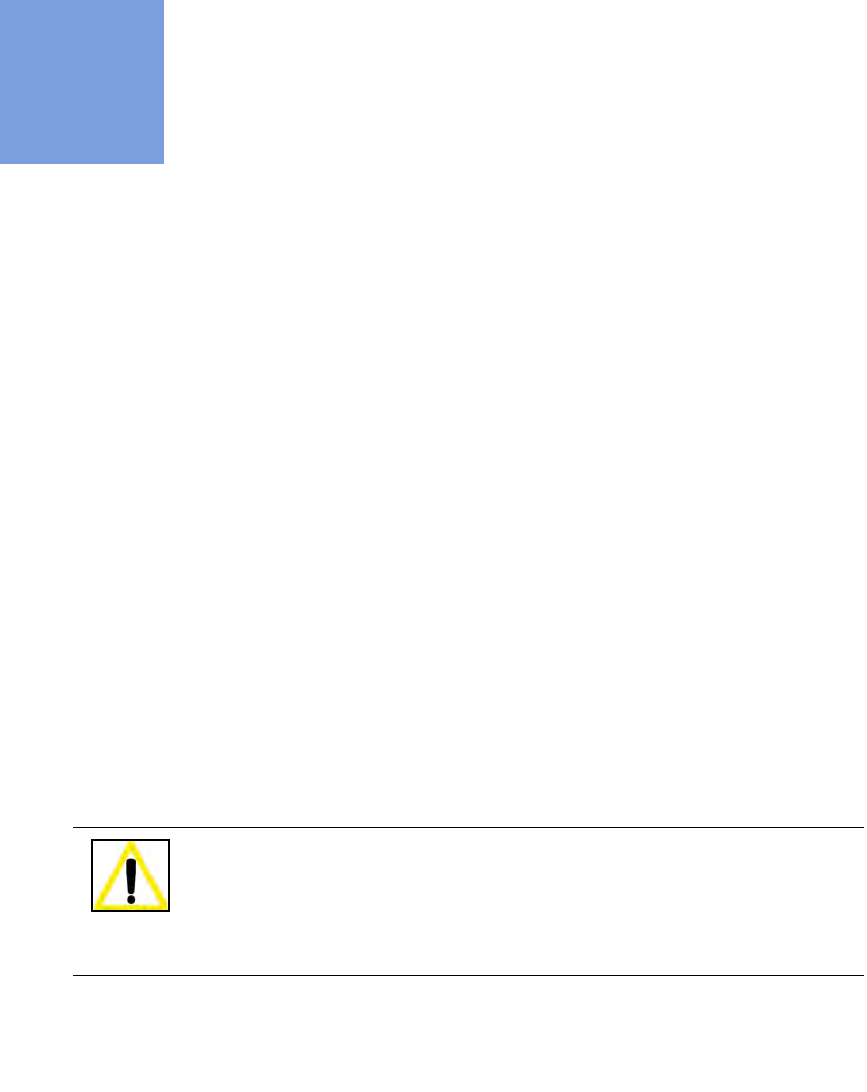
4-1
•
•
•
•
•
•
• • • • • •
Chapter 4: System Operation
Chapter 4 explains operating the SmartSponge Flex by describing the following functions:
•
Beginning a Case
•
Standby Mode
•
Scanning Items Into Surgery
•
Scanning Items Out of Surgery
•
Pausing a Case
•
Scanning a Patient for Retained Items
•
Using the SmartWand
•
Detecting the SmartTag
•
Ending a Surgical Case
•
Counts Equal
•
Counts Not Equal
•
Restoring Power
Warning!
•
For the system to function, use only ClearCount disposables.
•
Do not place sponges from a previous surgical case into the Count Out Basin.
This will cause the sponge counts not to reconcile properly.
•
Do not cut or tear SmartSponge disposables, as this may cause the RFID tags
to become separated from the disposables.
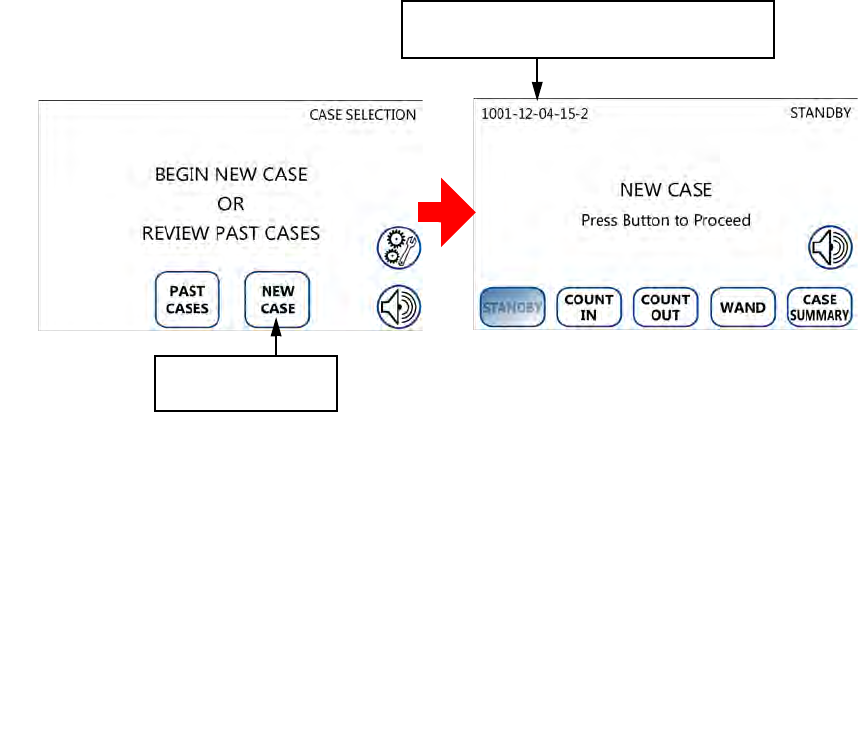
4-2
Chapter 4: System Operation
•
•
•
•
•
•
The SmartSponge Flex is designed to assign a unique number, referred to as a Case ID, to a single session of
counting RFID-tagged disposables that are used in a particular surgical case. This Chapter describes how to
begin a case, proceed through a case, and end a case.
Beginning a Case
The system will perform a series of self checks and display a progress bar when power is applied. The system
will enter the Case Selection mode after the self checks finish.
From the Case Selection screen, select NEW CASE to begin a new case. The system will generate a unique
case number and will display that number in the upper left corner of the screen as the Case ID.
Figure 4-1 Beginning a New Case
Press
NEW
CASE
to start a new case.
A unique
CASE ID
will be generated and
displayed in the upper left for this case.
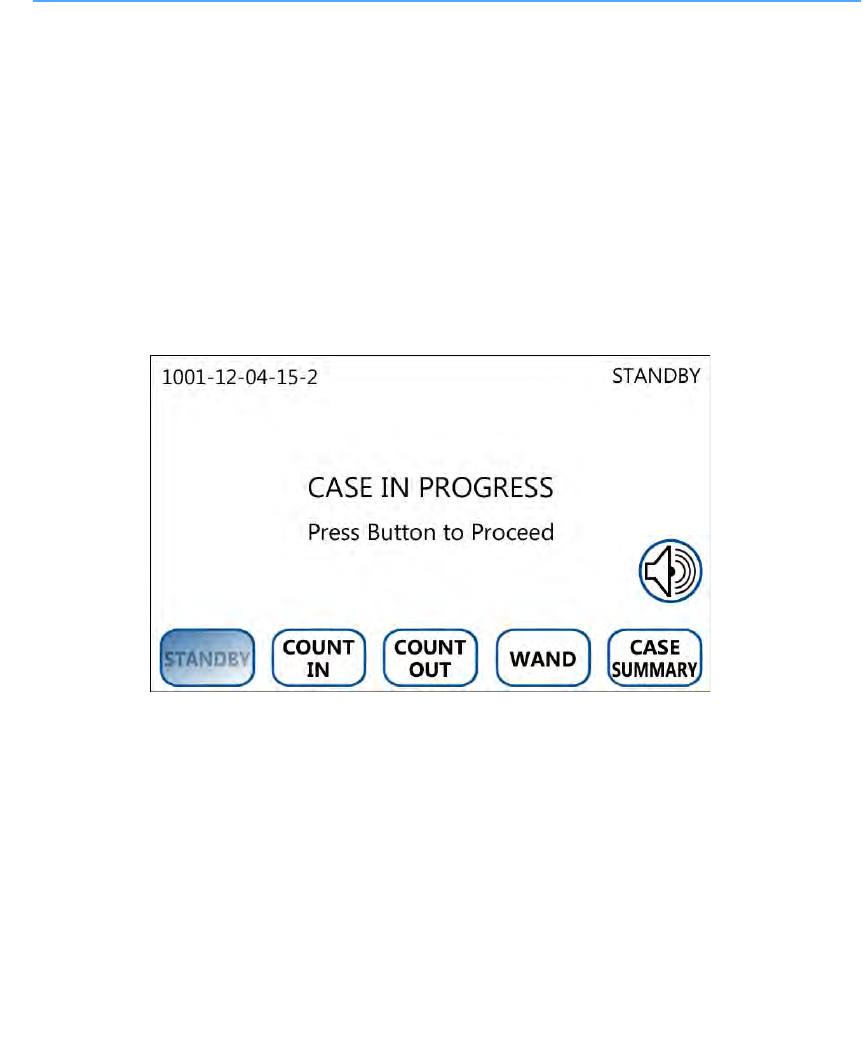
Chapter 4: System Operation 4-3
•
•
•
•
•
•
Standby Mode
The SmartSponge Flex is designed to not perform any scanning function until you specifically select to do so.
Therefore, the system will enter Standby mode when you select to begin a new case. While in Standby mode,
all antennas are off.
The system can remain in Standby mode for as long as necessary while you prepare for surgery. When you are
ready, you can navigate to any of the following modes:
•
Count In - Activates the In Scanner for scanning SmartSponges into the case.
•
Count Out - Activates the Count Out Basin for counting SmartSponges out of the case.
•
Wand - Activates the SmartWand for detecting SmartSponges.
•
Case Summary - Shows the sponge counts and case information for the current surgical case.
Figure 4-2 Standby Mode Screen
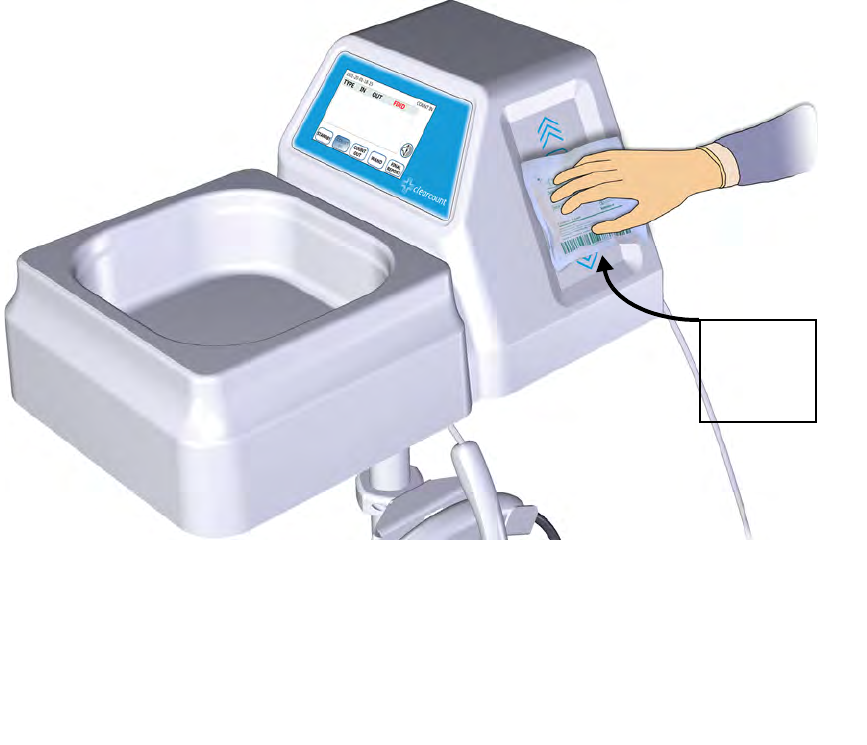
4-4
Chapter 4: System Operation
•
•
•
•
•
•
Scanning Items Into Surgery
Sponges are “scanned in” to a surgical case so that the “In” count can be later reconciled with the “Out” count
at the end of the case. This is possible because the system preserves in memory the unique identity of each
sponge scanned into the case.
Before a pack is scanned in, the system instantly verifies functionality of each individual tag and that the
quantity matches the expected quantity for the pack.
Sponges may be added into the surgical case at any time by entering Count In mode. The Count In mode is
entered by pressing the COUNT IN button at the bottom of any screen where the button is presented. The In
Scanner’s antenna is only active when the system is in Count In mode. Scan in packs of sponges/towels by
swiping them across the In Scanner. Scan packs one at a time. Keep other packs away from the pack you are
currently scanning.
Figure 4-3 Scanning Sponge Packs Into the Surgical Case
Swipe
ONE PACK
across the
In Scanner
.
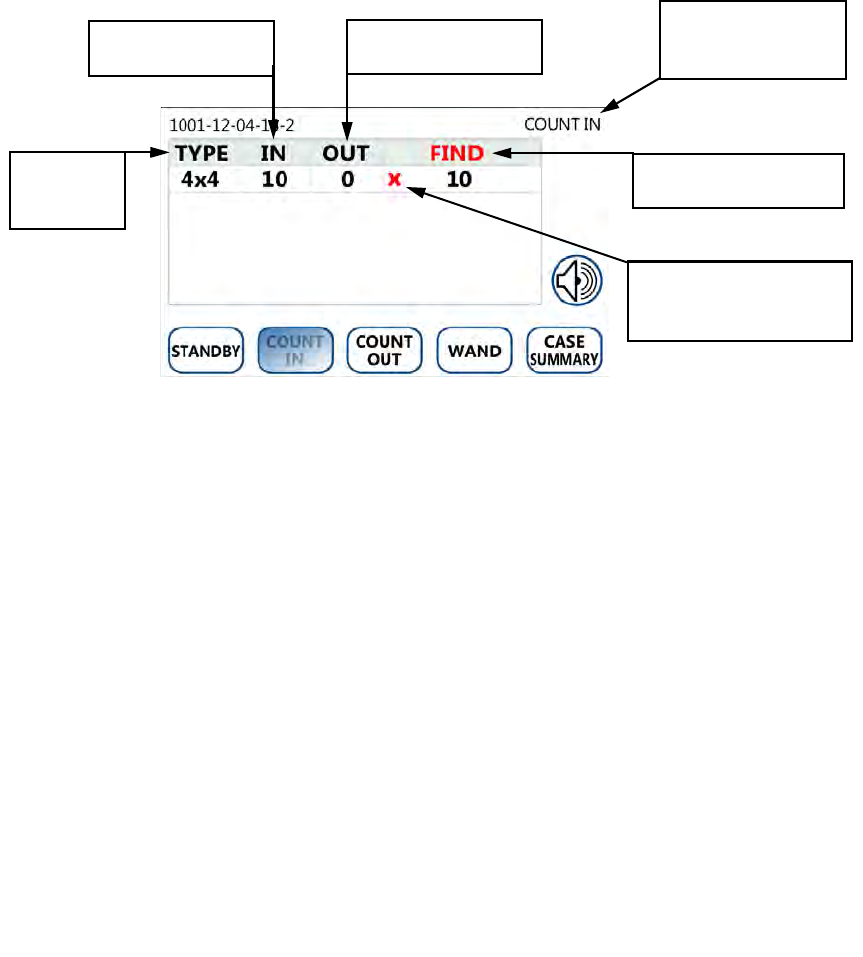
Chapter 4: System Operation 4-5
•
•
•
•
•
•
As packs of sponges are scanned in, they will appear on the Count In screen by type in the order in which they
were presented. The Count In screen contains fields that are populated with data as packs are scanned in. These
fields are illustrated in
Figure 4-4
.
Figure 4-4 Example: 1 Pack of 4x4 Sponges Scanned In
Instructions for Scanning In:
Step 1 Assemble the packs of sponges/towels intended for the surgical case at a location near the
SmartSponge Flex, but not on the device.
Step 2 Press the COUNT IN button to activate the In Scanner; “COUNT IN” will appear in the top
right corner of the screen.
Step 3 Scan ONE pack of SmartSponge surgical sponges or towels at a time into the surgical case by
swiping the pack flat across the In Scanner over the area marked “
SWIPE PACK TO SCAN
”
.
Move the pack back and forth across the In Scanner until an audible tone is heard, and the
system adds the pack contents to the IN (inventory) column. If the system does not accept the
pack, re-orient it and scan again.
Step 4 Set the scanned in pack away from the system in the area where the packs are staged prior to
opening the packs.
Step 5 Repeat Step 3 for each pack of sponges or towels being entered into the surgical case.
Step 6 After sponges are scanned in, they may be opened to the sterile field using standard sterile
technique. ClearCount SmartSponges are to be used in the same manner as generic surgical
sponges.
TYPE:
The
sponge type
scanned in.
IN:
The number of
sponges scanned in.
OUT:
The number of
sponges counted out.
FIND:
The number of
sponges not reconciled.
X:
Represents the
reconciliation status of the
row. (
X
=NO
,
=YES)
MODE: COUNT IN
must be displayed to
scan sponges in.
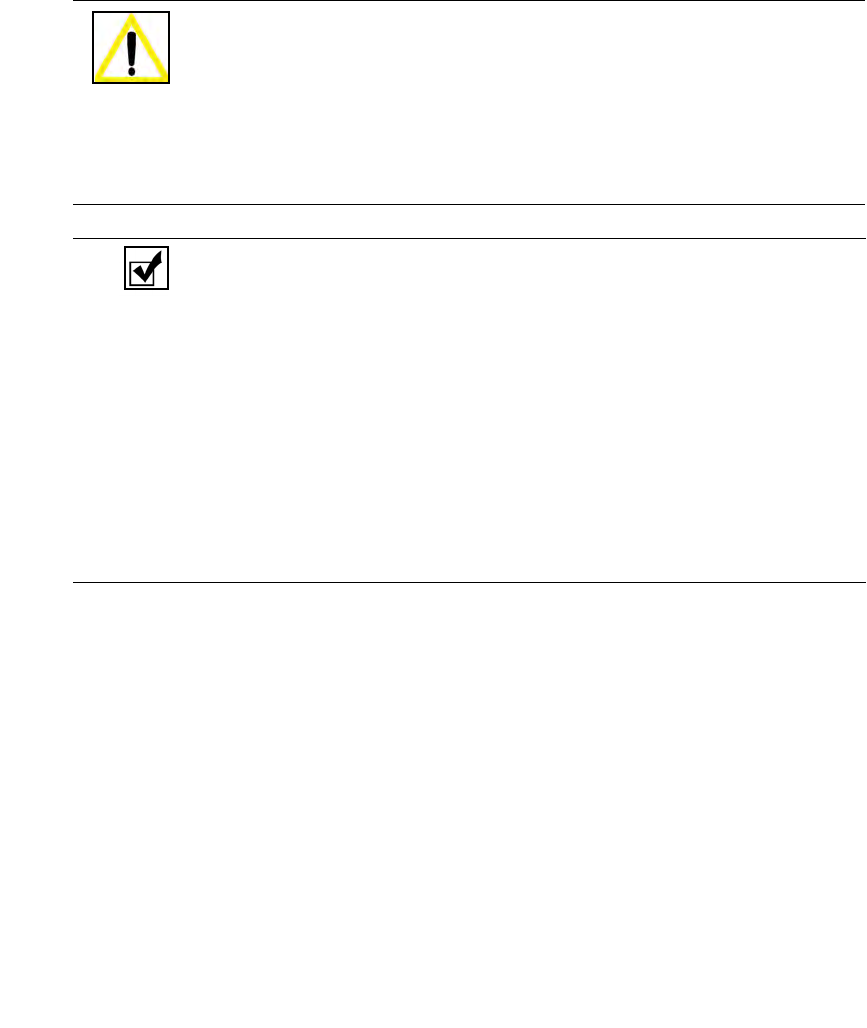
4-6
Chapter 4: System Operation
•
•
•
•
•
•
Warning!
•
Holding items that
have not been
scanned in too close to the Count Out
Basin while in Count Out mode may result in the items unintentionally being
detected prior to use. Follow the on screen prompts and decline acceptance if
the sponges were inadvertently held too close to the Count Out Basin.
•
Holding items that
have already been
scanned in too close to the Count Out
Basin while in Count Out mode may result in the items unintentionally being
counted out prior to use. Dispose any items into the basin that have been
scanned in and then counted out (detected) by the Count Out Basin.
Notes
•Make sure “COUNT IN” is displayed in the upper right of the display
when scanning packs into the surgical case.
•If two or more packs are detected by the In Scanner at the same time the
system will display the “Multiple Packs Detected” alert. Remove the
packs and re-scan one at a time.
•If a pack that has already been scanned in is presented to the In Scanner
to be scanned in again, the message “Pack Already Scanned” will
appear. Open and use pack as per normal operation.
•If the alert “Discard Pack” is displayed, throw out the defective pack
and replace it with a new pack.
•If after a pack is scanned, no tone is heard and zero sponges are added to
the count, throw out the defective pack and replace it with a new pack.
•Do not rest sponge packs or any other items on or near the In Scanner.
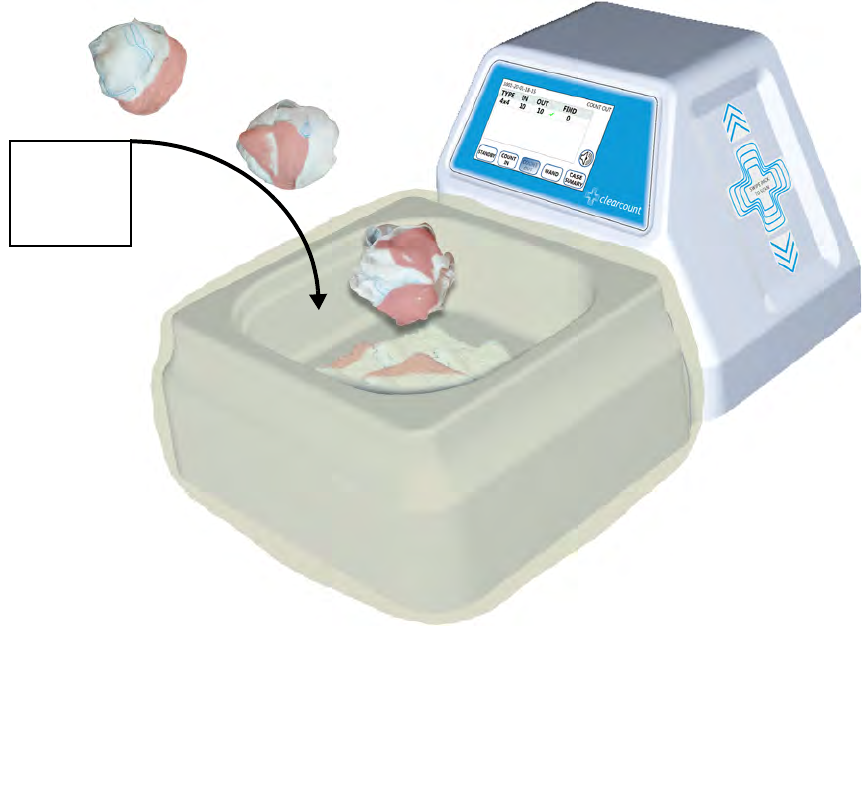
Chapter 4: System Operation 4-7
•
•
•
•
•
•
Scanning Items Out of Surgery
Sponges removed from the surgical field are to be placed into the SmartSponge Flex so they can be scanned
out. The system compares the identity of each sponge scanned out against the sponges that were scanned in
and stored in memory. The system continuously monitors the comparison of the identities of sponges scanned
in to those scanned out to determine if the counts are reconciled. Sponges may be discarded into the Count Out
Basin at any time during the surgical case. The Count Out Basin’s antennas are only active when the system
is placed in Count Out mode. The Count Out mode is entered by pressing the COUNT OUT button at the
bottom of any screen where the button is presented. Up to 20 sponges may be discarded into the Count Out
Basin simultaneously.
Figure 4-5 Scanning Sponge Out of the Surgical Case
Discard
sponges into
the
Count
Out Basin
.
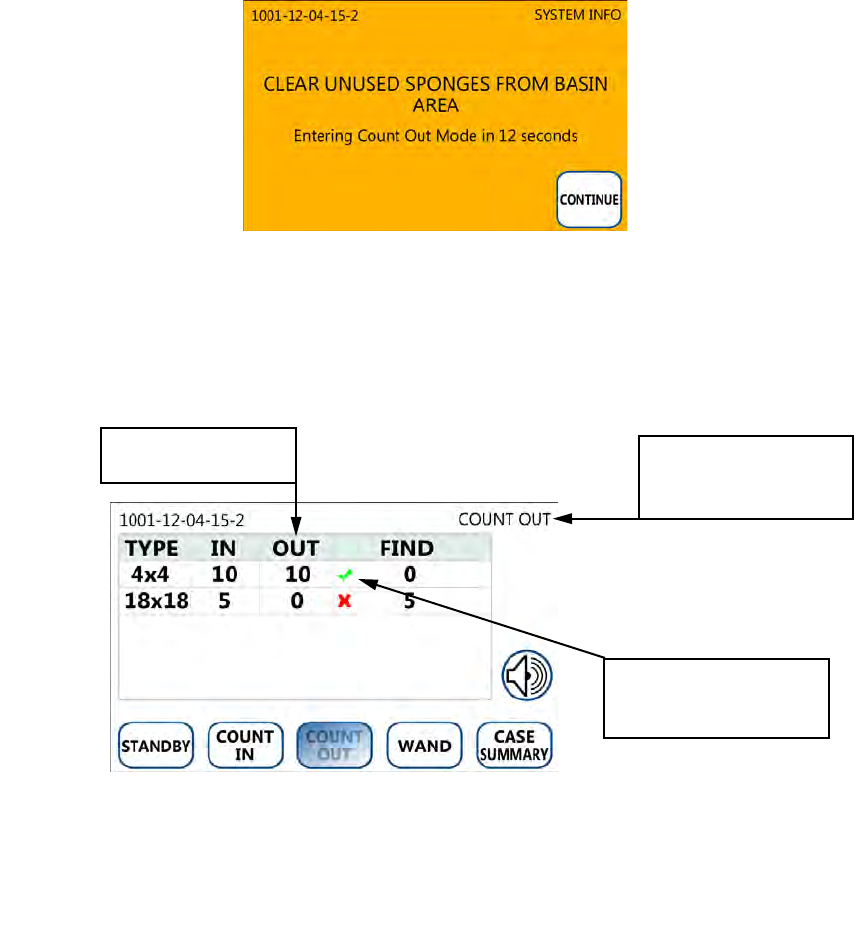
4-8
Chapter 4: System Operation
•
•
•
•
•
•
When switching to Count Out mode, an interim System Info screen will appear for 12 seconds requesting that
all sponges be removed from the vicinity of the Count Out Basin to avoid accidentally being counted out before
they are used. All of the antennas are off during this screen. To bypass the 12 second countdown, press the
CONTINUE button to immediately advance to the Count Out screen.
Figure 4-6 System Info Screen
As sponges are discarded into the Count Out Basin, they will appear in the OUT column for that type of sponge
on the Count Out screen. The Count Out screen contains fields identical to the Count In screen which are
updated as sponges are counted out. The illustration below shows the screen after 10 sponges that were scanned
in have been discarded into the Count Out Basin while in Count Out mode. See
Figure 4-7
.
Figure 4-7 Example: Ten 4x4 Sponges Counted Out
OUT:
The number of
sponges counted out.
:
Represents the
reconciliation status of the
row. (
X
=NO
,
=YES)
MODE: COUNT OUT
must be displayed to
count sponges out.
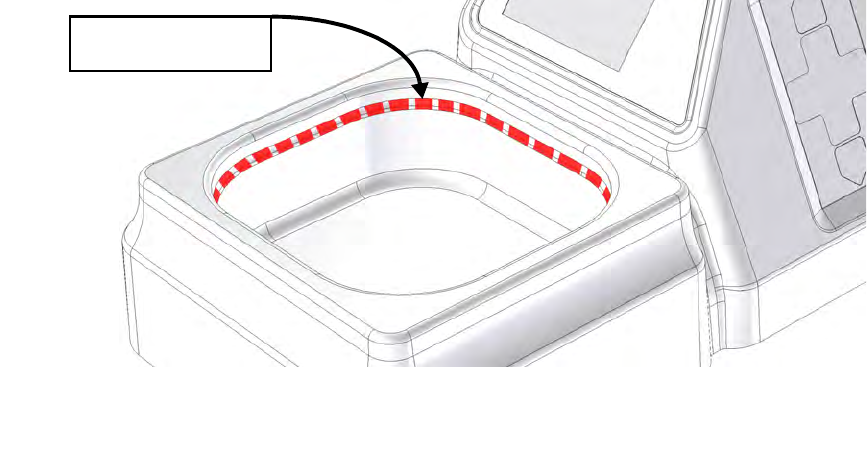
Chapter 4: System Operation 4-9
•
•
•
•
•
•
Instructions for Counting Out:
Step 1 Press the COUNT OUT button to activate the Count Out Basin. “COUNT OUT” will appear
in the top right corner of the screen once the system enters Count Out mode.
Remove unused sponges from the vicinity of the Count Out Basin while waiting 12 seconds for the
System Info screen to pass after pressing COUNT OUT, or press the
CONTINUE
button to advance
to the Count Out screen.
Step 2 Place soiled sponges into the Count Out Basin. Used sponges can be discarded into the Count
Out Basin at any point but will only be detected and counted out while the system is in Count
Out mode.
As the sponges are placed into the Count Out Basin, the
OUT
(inventory) column will increase with
the sponges that are counted out while the
FIND
(inventory) column will decrease simultaneously.
When the
IN
column matches the
OUT
column and the
FIND
column is
0
for that particular type, a
green check mark will appear in that row. If the
IN
and
OUT
do not match and there are sponges still
in the
FIND
column, then a red X will appear in that row. A reconciled case will have a green check
mark in all the rows.
Step 3 When finished with the case or at the point when 20 or more sponges have accumulated in the
Count Out Basin, empty the sponges or discard and replace the System Cover. The sponge
counts will not be affected by removing sponges from the Count Out Basin that have already
been counted out. Discard the used sponges from the Count Out Basin according to your
hospital’s policy.
See “Count Out Basin Capacity Limits” on page 4-14
Do not fill the Count Out Basin with sponges beyond the fill line. Sponges above the line may not be
detected. See
Figure 4-8
below.
Figure 4-8 Count Out Basin Fill Line
Do not stack sponges
above the
Fill Line
.
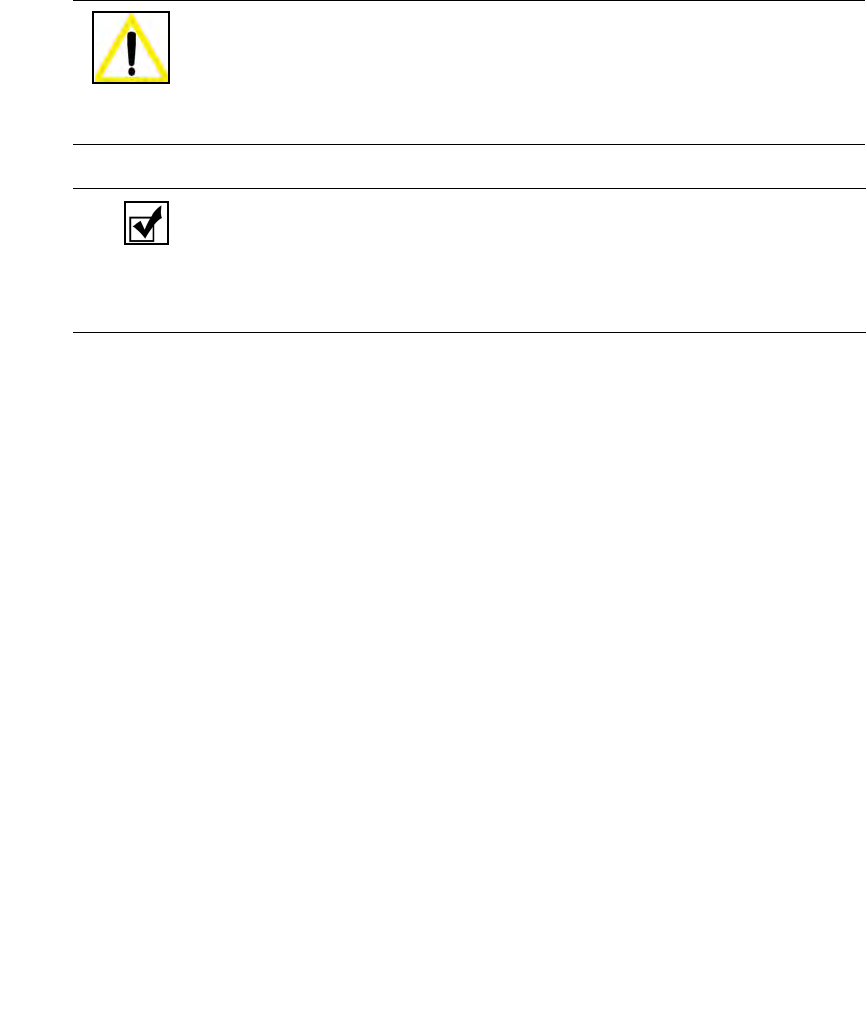
4-10
Chapter 4: System Operation
•
•
•
•
•
•
Warning!
•
Do not fill the Count Out Basin beyond its fill line. Items above the fill line
may not be counted.
•
Packs of sponges, either partial or complete, may not be counted when
discarded into the Count Out Basin. If a pack is discarded and the contents
cannot be read, separate the sponges from each other to ensure a correct count.
Notes
•
The Count Out Basin will not count items while the system is in
COUNT
IN
mode. Likewise, the In Scanner will not scan items in while the system is
in
COUNT OUT
mode.
•
Sponges contained within count bags or pocket-type devices may be
discarded directly into the Count Out Basin.
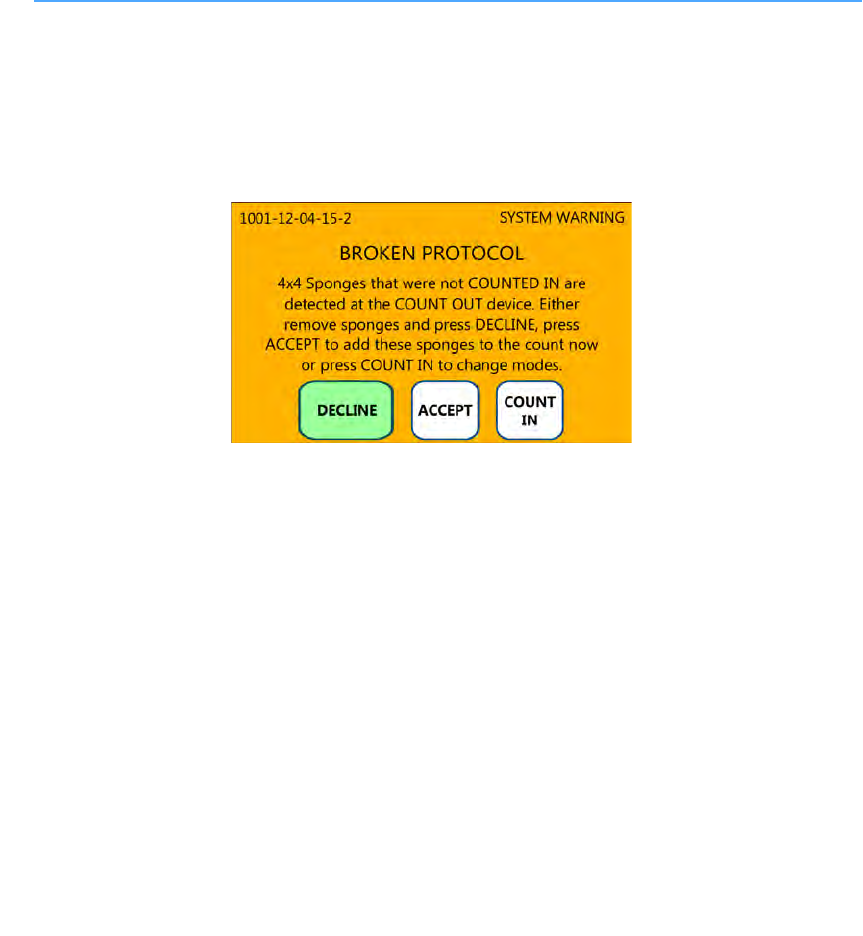
Chapter 4: System Operation 4-11
•
•
•
•
•
•
The SmartSponge Flex is designed on the premise that you will follow a standard practice of counting sponges
prior to use and again after use to then reconcile those counts. It is recognized that there could be instances
where, either intentionally or mistakenly, that sponges that have not been scanned into the case are presented
to the Count Out Basin while in Count Out mode. This is referred to as Broken Protocol.
Broken Protocol
The
Broken Protocol
warning is triggered when a sponge(s) that has not been scanned into the case is detected
by the Count Out Basin. While this may occur for good clinical reasons (i.e. emergency surgery without time
to scan sponges in before use), it is not recommended procedure.
Since the warning may be presented for different reasons, there are options to
Decline
the detected
sponge,
Accept
it into the case, or switch to
COUNT IN
mode. See
Figure 4-9
.
Figure 4-9 Broken Protocol Screen
•
DECLINE
Declining is the course to follow when a sponge(s) was mistakenly held too close to the Count Out
Basin prior to being scanned in.
Press DECLINE and the system will go back to the previous counts and continue. Before pressing
DECLINE, be sure to remove the detected sponge(s) from the vicinity of the Count Out Basin or the
system will continue to trigger the Broken Protocol warning.
•
ACCEPT
Accepting is the proper action when a sponge(s) that was not scanned in was intentionally discarded
into the Count Out Basin. This could be the result of an emergency situation where time did not allow
for the sponges to first be scanned in before they were used.
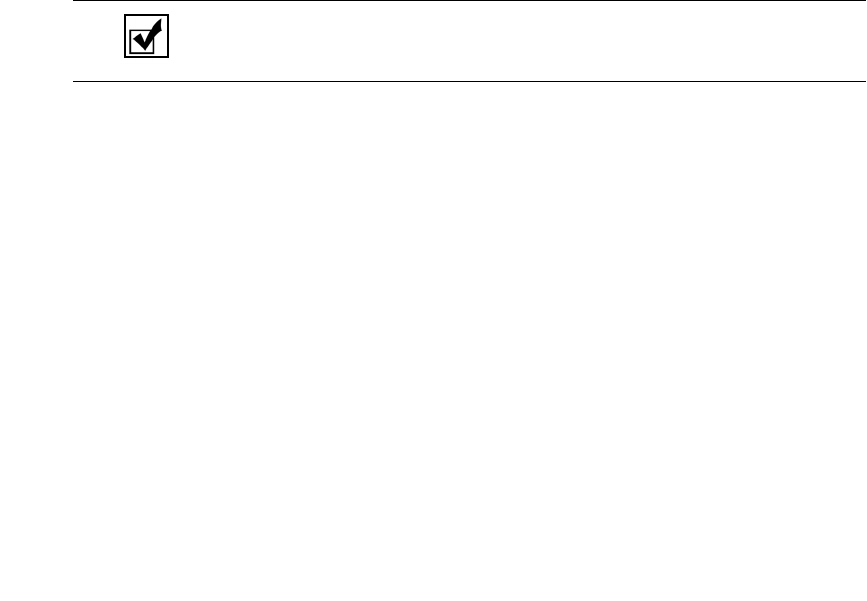
4-12
Chapter 4: System Operation
•
•
•
•
•
•
Press ACCEPT and the system will prompt you to confirm your action to add the detected sponge
(and the rest of the pack’s contents) into the surgical case’s counts and break protocol. Press ACCEPT
again to confirm the action and all absent sponges from the same pack as the accepted sponge
automatically become accepted into the case. The pack contents will be added to the IN column, with
the detected sponge entered into the OUT column. The subsequent sponges from the pack will not
need to be accepted; they will already exist in the FIND column. A message will then be displayed
stating that protocol has been broken (this will not affect system performance or function). See
Figure 4-10
.
•
COUNT IN
It is recognized that additional sponges may need to be added during a surgical case. It is possible
that sponges brought to the SmartSponge Flex for the intention of scanning them into the case could
first be detected by the Count Out Basin if the system is in Count Out mode. This will trigger the
Broken Protocol Warning. In this instance, you should select to go to Count In mode. Pressing the
COUNT IN button transitions the system into COUNT IN mode for scanning sponge packs into the
case.
Continue by following the instructions for Scanning Items Into Surgery. See page 4-4.
Note
•
If you are unsure what to do when Broken Protocol is triggered, press
DECLINE.

Chapter 4: System Operation 4-13
•
•
•
•
•
•
Figure 4-10 Example: Accepting Broken Protocol
Sponges from a pack of 4x4s not scanned
in, is detected by the Count Out Basin.
Confirm the action by pressing
ACCEPT
again
or
BACK
to return to the previous screen.
Broken
Protocol
is now displayed
at the bottom of the screen.
The Row of the sponges that
were accepted will turn red.
Press
ACCEPT
.
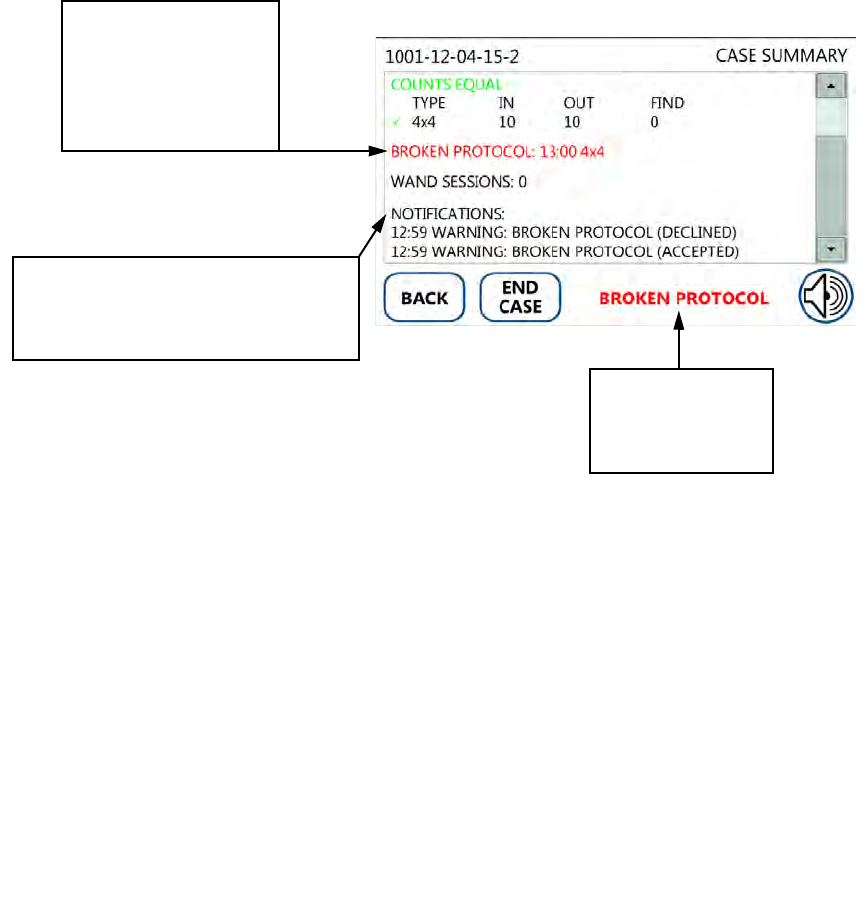
4-14
Chapter 4: System Operation
•
•
•
•
•
•
Figure 4-11 Example of Protocol Broken Note in Case Summary
The TimeStamp for any
Broken Protocols along
with the Type of sponge
triggering it, is displayed
within the top section of
the Case Summary.
Broken
Protocol
is displayed at the
bottom of the CASE
SUMMARY screen.
Listed under the Notifications within the
bottom of the Case Summary is the
user’s selected action to any Broken
Protocol Warnings they received.
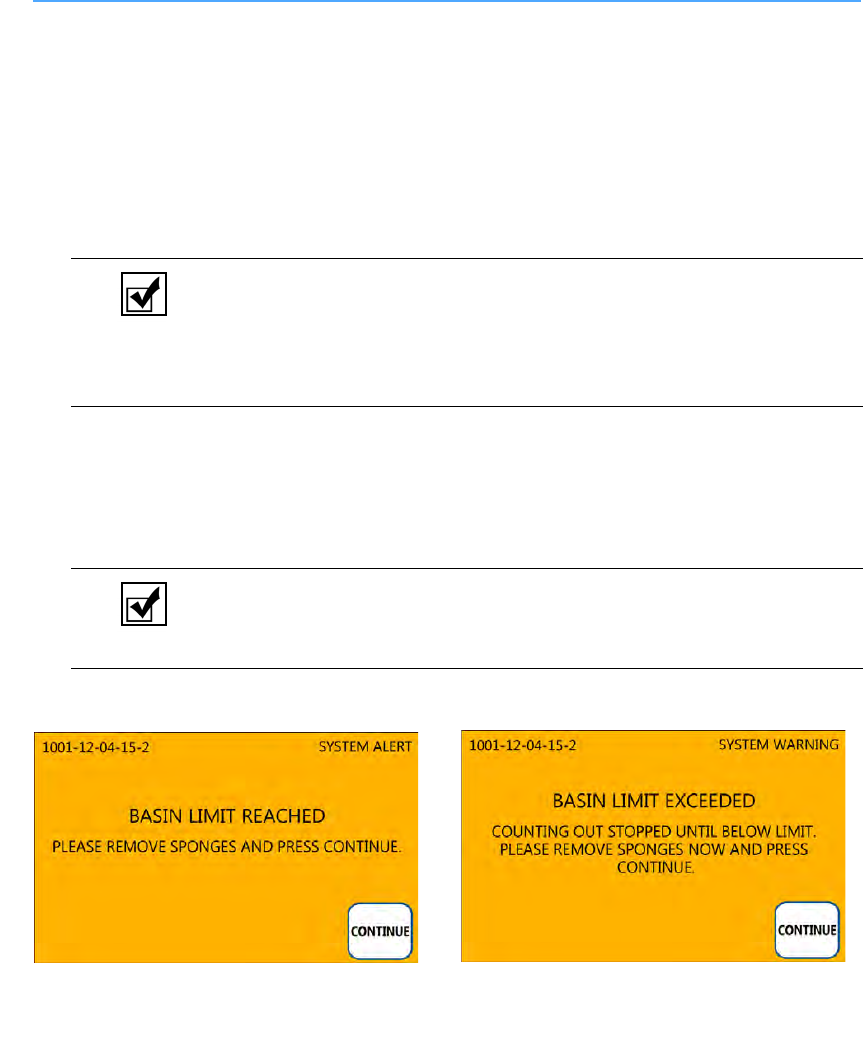
Chapter 4: System Operation 4-15
•
•
•
•
•
•
Count Out Basin Capacity Limits
The capacity of the Count Out Basin is limited to ensure optimal performance when counting out sponges that
are discarded into it. There should never be more than 20 RFID-tagged sponges or towels in the Count Out
Basin at the same time.
•
BASIN LIMIT REACHED
If more than
20
sponges accumulate in the Count Out Basin simultaneously, the System Alert
“
BASIN LIMIT REACHED
” will appear on the display. When this alert occurs, remove the
sponges from the Count Out Basin, replace the System Cover (if necessary), and press CONTINUE
to return to the Count Out screen.
•
BASIN LIMIT EXCEEDED
If the “
BASIN LIMIT REACHED
” screen is ignored and the sponges accumulating in the Count
Out Basin reaches
30
, the System Warning “
BASIN LIMIT EXCEEDED
” will be displayed. The
system will no longer count sponges in the Count Out Basin until less than 20 are present at a time.
Remove the sponges, press CONTINUE to return to Count Out mode, and rescan the sponges from
the Count Out Basin in groups of no more than
20
at a time.
These measures are taken to assure accurate sponge counts. See Chapter 8 for explanations of System
Alerts and Warnings.
Figure 4-12 Basin Limit Alert and Warning Screens
Notes
•
Sponge Counts are not affected by removing already counted out sponges
from the Count Out Basin.
•
The system will continue to count out sponges discarded into the Count Out
Basin while on the System Alert screen.
•
Do not stack sponges in the Count Out Basin beyond the fill line.
Notes
•
The system suspends all counting while on the System Warning screen.
Rescan any sponges in the Count Out Basin in groups of less than 20 after
pressing CONTINUE to ensure all sponges have been reconciled.

4-16
Chapter 4: System Operation
•
•
•
•
•
•
Pausing a Case
There may be reasons you might want to pause the counting and detection functions of the system. The Standby
mode is provided to allow you to pause a case. Placing the system into standby suspends all counting and
detection functions by turning off all power to the system’s antennas. All count information is retained. You
may resume the case by exiting Standby mode and entering the desired mode of operation.
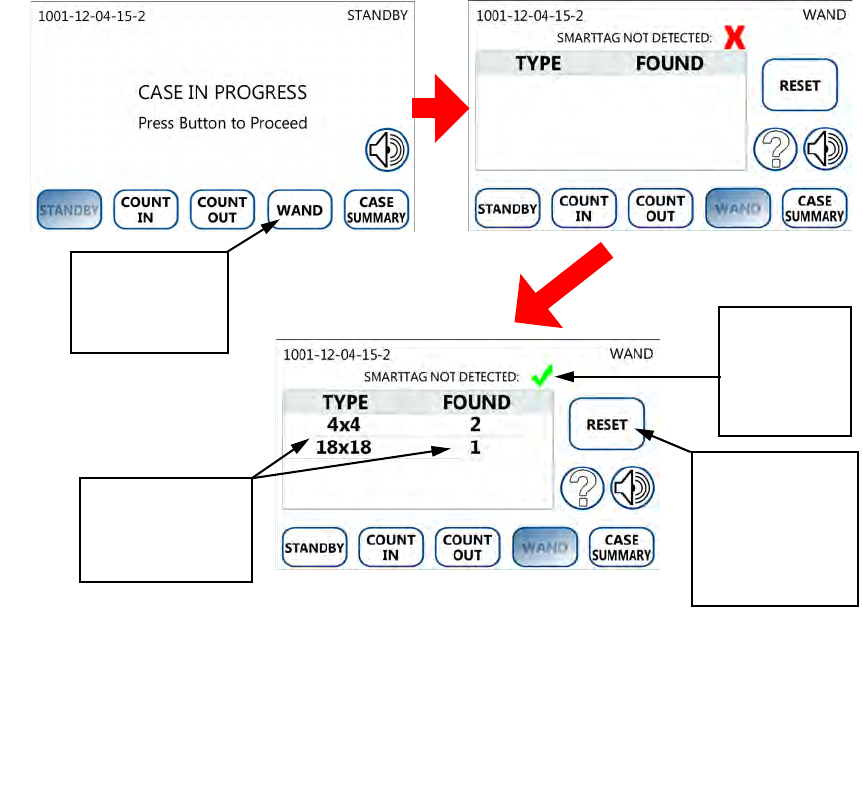
Chapter 4: System Operation 4-17
•
•
•
•
•
•
Scanning a Patient for Retained Items
The SmartWand allows you to scan patients for retained ClearCount sponges and towels at any point during
surgery. Remove wand from holder then press the WAND button to enter Wand mode. It is important to note
that an item found by the wand is not counted out. An item can only be counted out when it is presented to the
Count Out Basin and the system is in Count Out mode. The SmartWand performs best when passed over the
patient in a slow, steady fashion, no faster than 0.2 m/second (approximately 7 inches/second). Maintain a
distance of 1 to 2 inches above the patient. While a tagged item may be found on the first pass of the wand, it
is typical to make several passes at varying inclinations to locate an item within a body. On a typical patient,
each scan pass should take approximately 5 seconds to complete. See
Scanning Procedure
.
Figure 4-13 Wand Mode Screen
To clear the
detected sponges
and SmartTag
detection from the
screen, press the
RESET
button.
Press the
WAND
button from any
mode to enter
Wand Mode.
When sponges are
detected, they will
be displayed by
type and quantity.
When the
SmartTag is
detected, the
green check
mark appears.
SmartTag and 2 4x4 detected
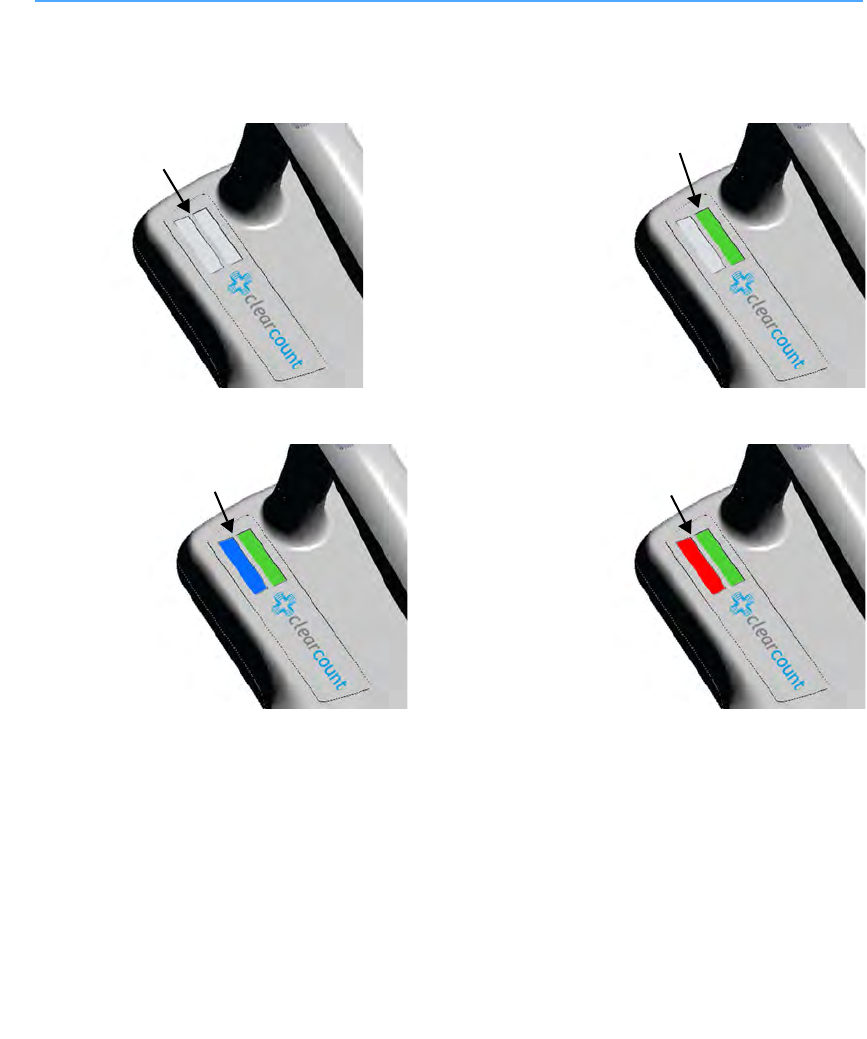
4-18
Chapter 4: System Operation
•
•
•
•
•
•
Wand LED Function
The wand uses two LEDs and three colors to communicate status to the user. The combinations of colors result
in four basic states, which are described below:
Figure 4-14 Wand LED Behavior
Both LEDs Green LED
Amber & Green
Blue & Green
When both
LEDs are
OFF, the
wand is not
active.
(Wand is not
active in any mode
except Wand Mode.)
When Wand Mode is entered
the Green LED illuminates
to show the wand is active.
(If the Green LED is OFF,
the wand is not attached or
not powered. If the Bi-Color
LED is OFF, no items have been
detected; or the RESET button
has been pressed.)
The Green LED
indicates the wand is
active.
The Blue LED will
illuminate and stay
on when a SmartTag
is detected. When first
detected, the system will
produce an audible tone
and change the detected
status on the display to a green check mark.
(The Amber LED will temporarily replace the
Blue LED while a sponge is being detected.
Once the wand no longer detects a sponge, it
will revert back to Blue until the RESET button
is pressed to clear the detected items.)
The Green LED
indicates the wand is
active.
The Amber LED
illuminates when a
sponge is being detected
and an audible tone is
produced. When the sponge
leaves the wand’s detection
field, the Amber LED turns OFF; or reverts back to
Blue if a SmartTag has been detected.
(The Amber LED is synchronized to the audible
tone during sponge detection. This mimics the
feedback of a metal detector passing over metal.
The Amber LED and tone aid in locating sponges.)
1) WAND OFF
OFF
2) WAND ON
ON
3) SMARTTAG DETECTED
LEDs ON LEDs ON
4) TAGGED ITEM DETECTED

Chapter 4: System Operation 4-19
•
•
•
•
•
•
Patient Scanning Procedure
Step 1 Remove the SmartWand from the wand hanger on the mobile cart and free its cable from the
cord wrap.
Step 2 Cover the SmartWand with a sterile cover using sterile technique while passing the wand into
the sterile field.
Step 3 Press the
WAND
button to activate the wand. The green LED on the handle will illuminate when
the wand is activated and the Wand screen shown in Figure 4-13 will also appear.
Step 4 Hold the SmartWand by the handle over the site where the SmartTag has been placed. When
detected, the blue LED on the wand will illuminate and the screen displays a green check mark
next to the “SMARTTAG DETECTED” text. See Figure 4-13. This confirms that the wand is
operational and reading completely through the patient.
Without a SmartTag under the patient, you are unable to verify the wand is scanning completely
through the patient. However, not detecting a SmartTag does not affect the wand’s capability to detect
items within the patient.
Step 5 While in Wand mode, hold the wand by the handle and slowly scan the patient from head to toe
moving at a rate of 0.2 meters a second (7 inches/sec), and keeping the wand 2 to 3 inches above
the patient.
Follow the instructions in
Figure 4-15
for completing the 5 passes over the patient with the wand.
It is important to do all the scans (1-5) in order to most accurately identify potential retained sponges.
Follow the onscreen instructions found in the Wand Help screen by pressing the
icon shown in
Figure 4-16
. The wand will continue to detect sponges while the Wand Help screen is displayed.
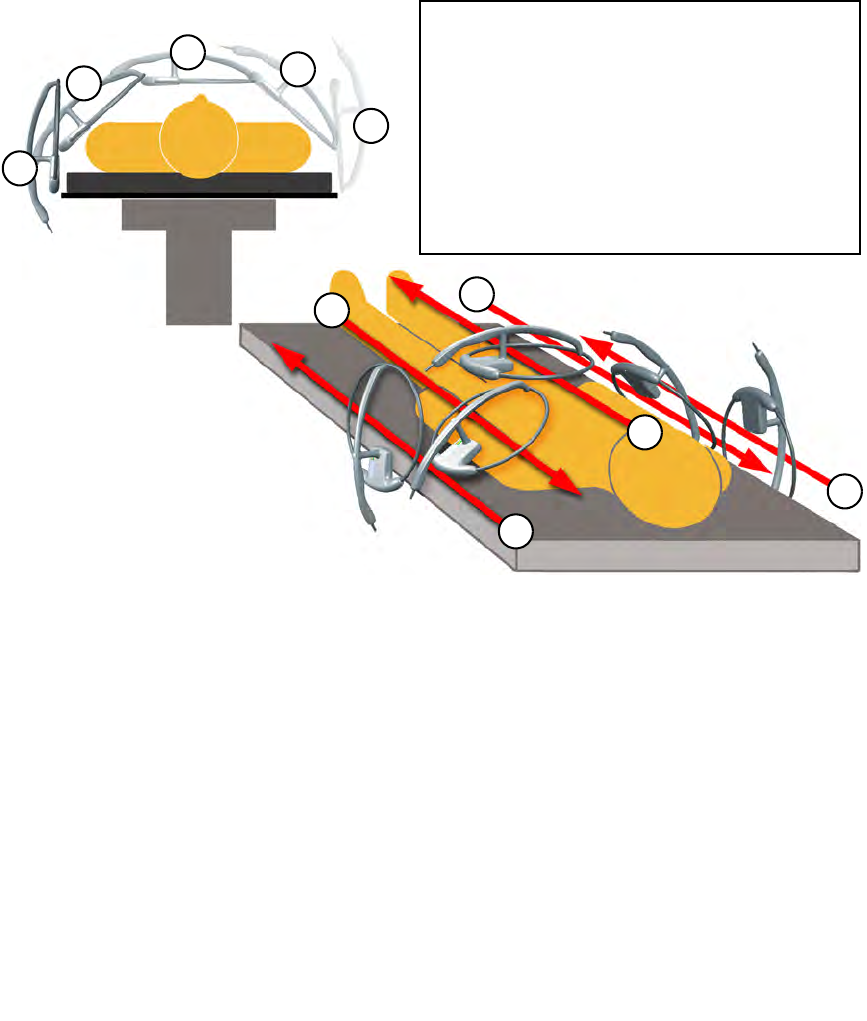
4-20
Chapter 4: System Operation
•
•
•
•
•
•
Figure 4-15 Patient Scan Procedure
Step 6 If the wand detects a sponge retained in a patient, the system produces an audible alert while the
amber LED on the wand illuminates, and the Wand mode screen displays the type and quantity
of the sponges detected.
The Wand’s amber LED and audible tone will react anytime a sponge enters the wand’s
detection field. This will aid in locating retained sponges. (This is similar behavior to that of a
metal detector passing over metal)
Step 7 If the scan yields any retained sponges, place the system into Count Out mode and put the
recovered items into the Count Out Basin to count them out of the case.
1
2
2
5
4
3
3
5
4
1
Hold the wand
1-2
inches above the patient while
scanning at a rate of
7
inches a second for each
pass.
1
.
Starting at
90 degrees
to the patient, scan from
head to toe past the surgical sight.
2
.
Scan at a
45 degree
angle to the patient.
3
.
Scan
Parallel
to the patient.
4
.
Scan opposite of
2
at a
45 degree
angle.
5
.
Scan opposite of
1
at
90 degrees
.
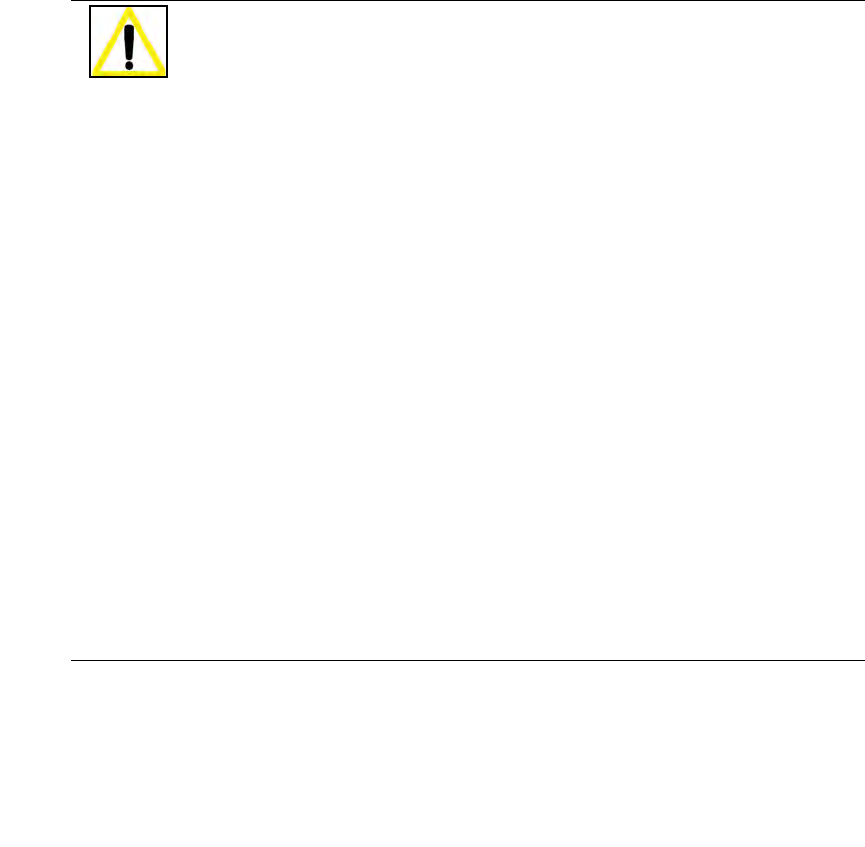
Chapter 4: System Operation 4-21
•
•
•
•
•
•
Step 8 When the patient scan is complete, deactivate the wand by pressing the appropriate navigation
button to leave Wand mode and go to the desired mode. The green LED on the wand will shut
off when deactivated.
Step 9 Remove the SmartWand from the sterile field. Remove the sterile cover and discard it according
to the standard protocol.
Step 10 Return the SmartWand to the wand hanger and the cable to the cord wrap.
Warning!
•
Using the SmartWand without a sterile wand cover may contaminate the sterile
field.
•
When using the wand, the system may experience a slight degradation of read range
of RFID tagged items when metal objects are within the scanning field. Small metal
objects like implants and pacemakers will have no impact in most cases. To the
extent possible, remove metal from the scanning site or keep the RFID tags at least
½ an inch from direct contact with metal objects.
•
Individual sponges or packs of sponges may not correctly count when placed
directly on metal surfaces including back tables, mayo stands, large reusable
capacitively-coupled return electrode pads and metal kick buckets. When using the
wand, remove the sponges from those areas, or provide a separation distance
between the metal and the RFID tags so that the tags can be read.
•
While using the wand, interference may appear momentarily on ECG graphs. Users
should be aware that this interference is temporary and will discontinue when the
wand is moved away from ECG equipment or when wand use is discontinued.
•
While using the wand interference may appear on Ultrasound images. Place the
device in Standby mode while ultrasound imaging is in progress. The device will
not lose count when using Standby mode.
•
The wand is a tool to assist in the location of tagged items within the body. Use of
the wand, does not guarantee that a tagged item will be detected. Detection depends
on proper technique and a variety of environmental conditions.
•
The orientation of the RFID tags within a body has an effect on the ability to read
those tags. For this reason, proper wand technique should be exercised when
searching for tagged items. Proper technique requires deliberate and thorough
scanning through various orientations. Refer to the patient scanning procedure of
this operators manuals for complete details.
•
Cardiac pacers should be set to asynchronous pacing (VOO/DOO) mode prior to
patient scanning with the wand to avoid potential short-term interference.
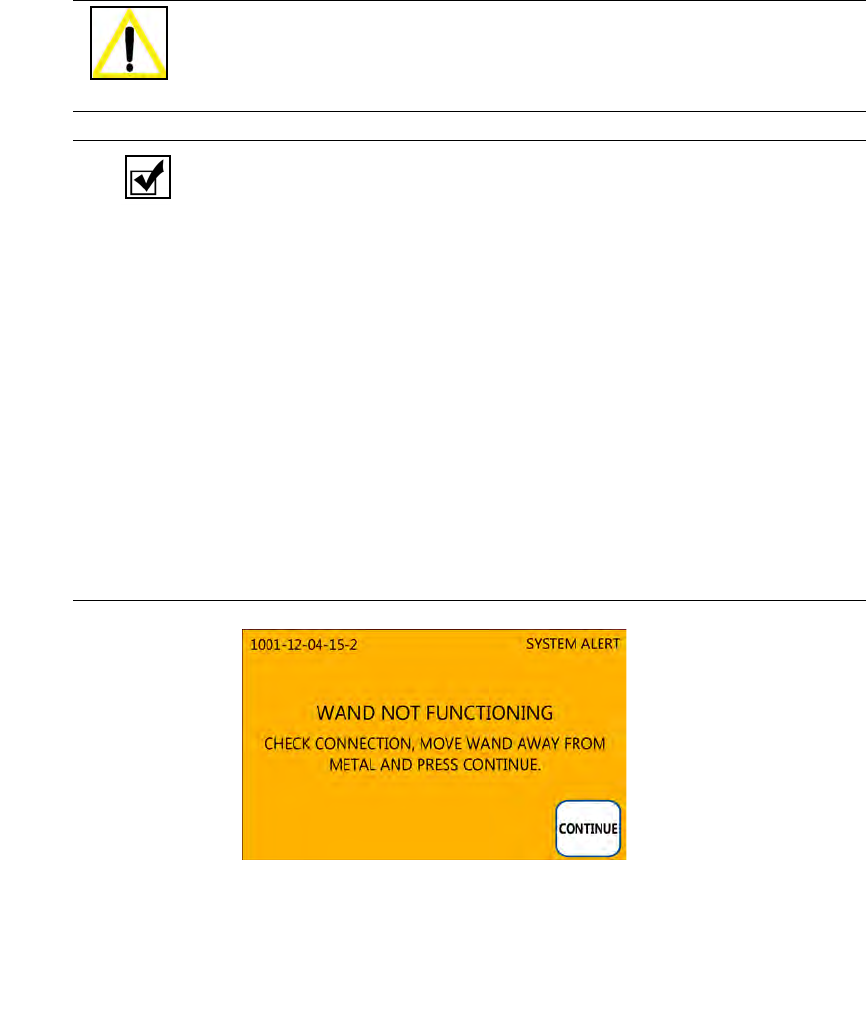
4-22
Chapter 4: System Operation
•
•
•
•
•
•
Figure 4-16 Wand Not Functioning Screen
Caution!
Do not shorten the length of the SmartWand’s cable in order to replace the connector
at either end. Adjusting the cable length will affect the wand’s performance. Replace
the entire cable with a new one if any complications arise.
Notes
•
Remove instruments from the surgical site prior to scanning with the SmartWand.
•
Before removing the SmartWand from the sterile field, the user should leave Wand
mode to reduce the chance of inadvertently detecting items in the path of the
wand.
•
While in Wand mode do not set the wand on large metal surfaces. If this occurs,
remove the wand from the surface and give the system 20 seconds to readjust.
•
Do not attempt to scan trash cans or other metal receptacles for disposable items,
as the wand may not be able to detect them.
•
While in Wand mode do not place the SmartWand on the Count Out Basin or on
the In Scanner: the wand will fail to operate. Removing the wand from these
locations will restore normal functionality.
•
Do not use the wand in conjunction with any large reusable, capacitive-coupled
return electrode systems that are placed under the patient for electosurgical
devices, as the read range of the wand may be significantly reduced.
•
When scanning a patient, hold the SmartWand only by its handle.
•
If Wand mode is entered with the wand still in the hanger, the System Alert shown
in
Figure 4-16
below may appear. Remove the wand from the hanger and press
CONTINUE to resume.
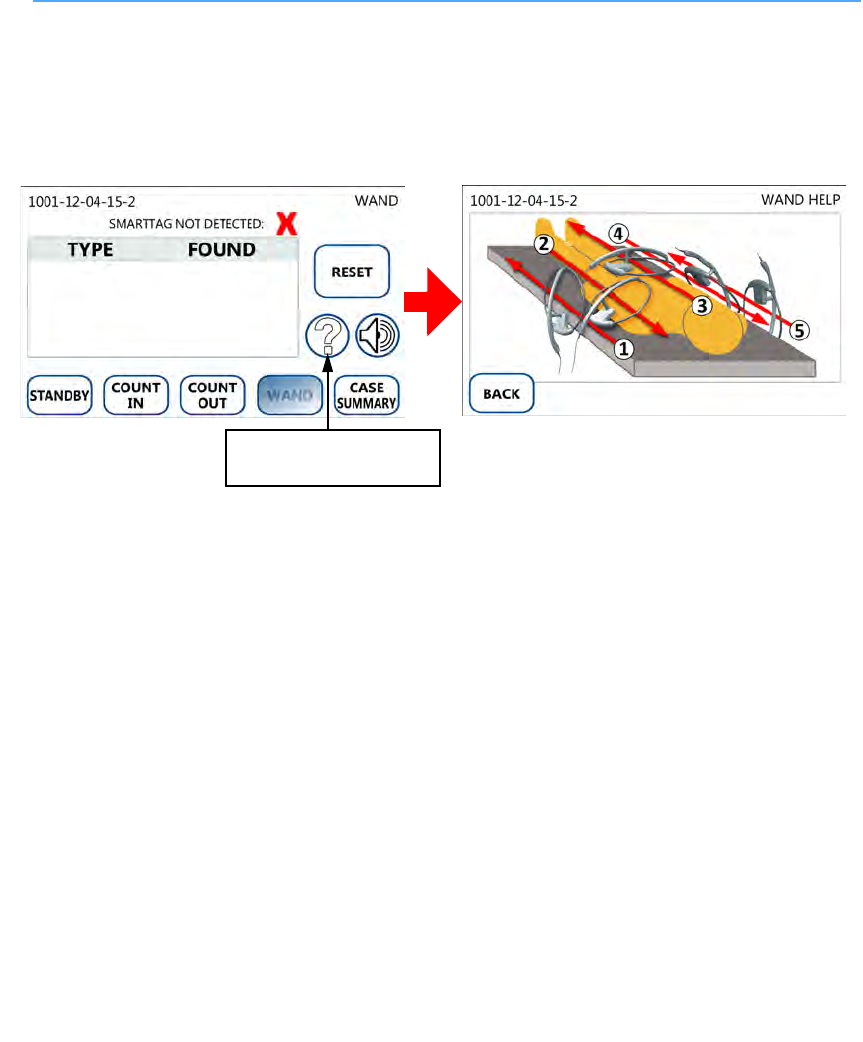
Chapter 4: System Operation 4-23
•
•
•
•
•
•
Wand Help Screen
To enter the Wand Help screen, press the
icon on the right hand side of the Wand mode screen. An
illustration of the patient scanning procedure will be displayed onscreen as a reference. Sponges will continue
to be detected by the wand during this screen. To return to the Wand mode screen, press the BACK button.
Figure 4-17 Wand Help Screen
Press
?
icon to bring up
the Wand Help screen.

4-24
Chapter 4: System Operation
•
•
•
•
•
•
Ending a Surgical Case
When surgery has concluded, pressing the CASE SUMMARY button allows you to review information about
the current case. A complete summary of the critical items related to the case are displayed; including sponge
counts, use of the SmartWand, errors and alerts, etc.
The Case Summary mode may also be entered to review the status of the current case at anytime. To return to
the mode in which Case Summary was entered from, simply press the BACK button.
A description of the information provided by the Case Summary screen is included in
Figure 4-18
.
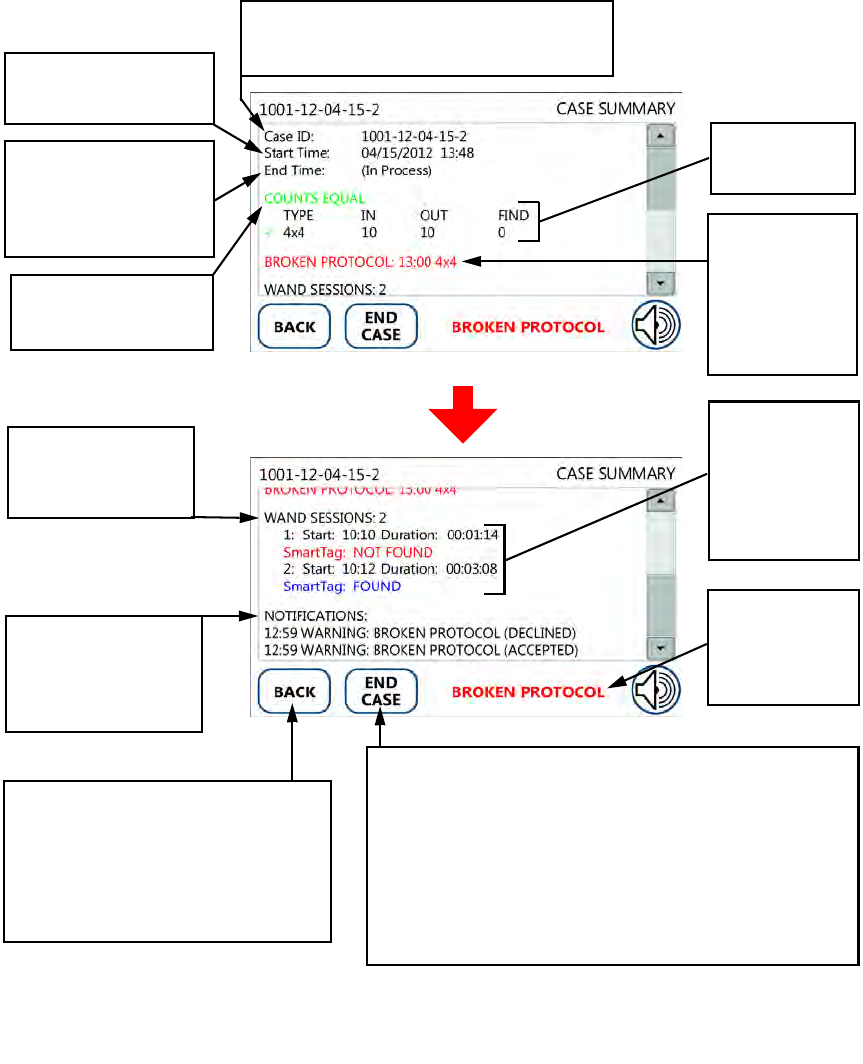
Chapter 4: System Operation 4-25
•
•
•
•
•
•
Figure 4-18 Case Summary Mode Screen
Count Status:
This
displays the Status of the
Sponge Counts.
Broken Protocol
Events:
Lists the
time a Broken
Protocol was
accepted and with
what type of
sponge.
Case ID:
This is the same case number that
appears in the upper left of the screen. Record
this in the patient’s record.
Start Time:
This is the time
that the current case was
started.
End Time:
Will show “In
Process” until the case is
ended. Then will show the
time the case was closed
when reviewing case data.
Sponge Counts:
Lists the sponges
used in the case.
Wand Sessions:
The
number of times Wand
mode was entered or a
session was reset.
Notifications:
Lists any
Alerts or Warnings that
were encountered during
the case and the time
they occurred.
Broken Protocol
Note:
Is displayed
if a Broken
Protocol Warning
was accepted.
BACK button:
Returns the system to the
mode that Case Summary was entered
from. (Example: if the system was in Count
Out mode and the CASE SUMMARY
button was pressed, pressing the BACK
button from the Case Summary mode will
return the system to Count Out mode.)
END CASE or OVERRIDE button:
If the Count Status is
“COUNTS EQUAL” or “VERIFIED BY ADMIN”, then the END
CASE button will be displayed. If the status is “COUNTS NOT
EQUAL” then the OVERRIDE button will be displayed.
Pressing the END CASE button will close the current case, save
the case data, and return the system to Case Selection mode.
Pressing the OVERRIDE button will advance the system to the
OVERRIDE screen where the user is prompted to scan the
Override Card.
Wand Session
Details:
Lists the
time the session
started, how long
it lasted, and if the
SmartTag was
detected.
SCROLL DOWN
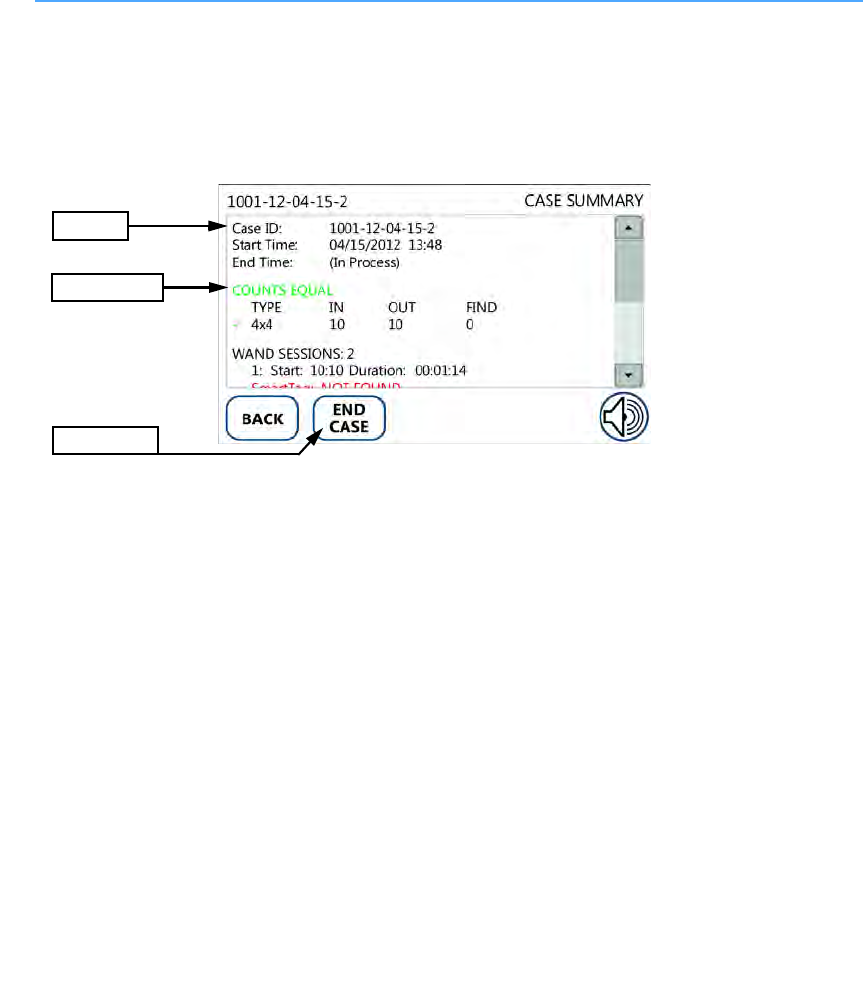
4-26
Chapter 4: System Operation
•
•
•
•
•
•
There are two possible outcomes when ending a case; sponge counts are equal or sponge counts are NOT equal.
Each outcome is described below.
COUNTS EQUAL
When all of the surgical items have been returned and the system has reconciled the sponge count, the Case
Summary screen will indicate a count status of “COUNTS EQUAL” when the CASE SUMMARY button is
pressed. In this situation, the END CASE button will be available at the bottom of the screen. Pressing the END
CASE button will end the case. When ending the case, the system will assign an end time to the case and save
the case data. The system will automatically return to the Case Selection screen in preparation for the next case.
Figure 4-19 Case Summary Screen: COUNTS EQUAL
Ending a case with “COUNTS EQUAL”:
Step 1 Press the
CASE SUMMARY
button located at the bottom of the screen.
Case Summary mode can be entered from any other mode. When the counts are reconciled, the Case
Summary screen displays “
COUNTS EQUAL
”. See
Figure 4-19
.
Step 2 Enter the Case ID into the patient’s record from the top line of the report.
Step 3 Press the
END CASE
button to end the case.
The system will save the case data and return to the Case Selection screen.
Step 4 Remove the System Cover that contains the discarded sponges from the Count Out Basin.
Dispose of the bagged items according to the standard protocol for your hospital.
Step 5 Clean the entire SmartSponge Flex according to the procedure in Chapter 7 before entering it
into the next surgical case.
Count Status
Case ID
END CASE

Chapter 4: System Operation 4-27
•
•
•
•
•
•
COUNTS NOT EQUAL
If any of the surgical items are not accounted for when the CASE SUMMARY button is pressed, the Case
Summary screen will indicate a count status of “COUNTS NOT EQUAL”. You may select the BACK button
to return to the case and search for the missing items.
If you desire to close the case without reconciliation by the system, the OVERRIDE button will need to be
selected. The SmartSponge Flex requires that the user acknowledge the closure of an un-reconciled case. This
is accomplished using the Override Card. Once the Override Card has been presented to the In Scanner, the
system will sound an audible tone and display the count status as “VERIFIED BY ADMIN”. The END CASE
button will now be available at the bottom of the Case Summary screen. When ending the case, the system will
assign an end time to the case and save the case data. The system will automatically return to the Case Selection
screen in preparation for the next case.
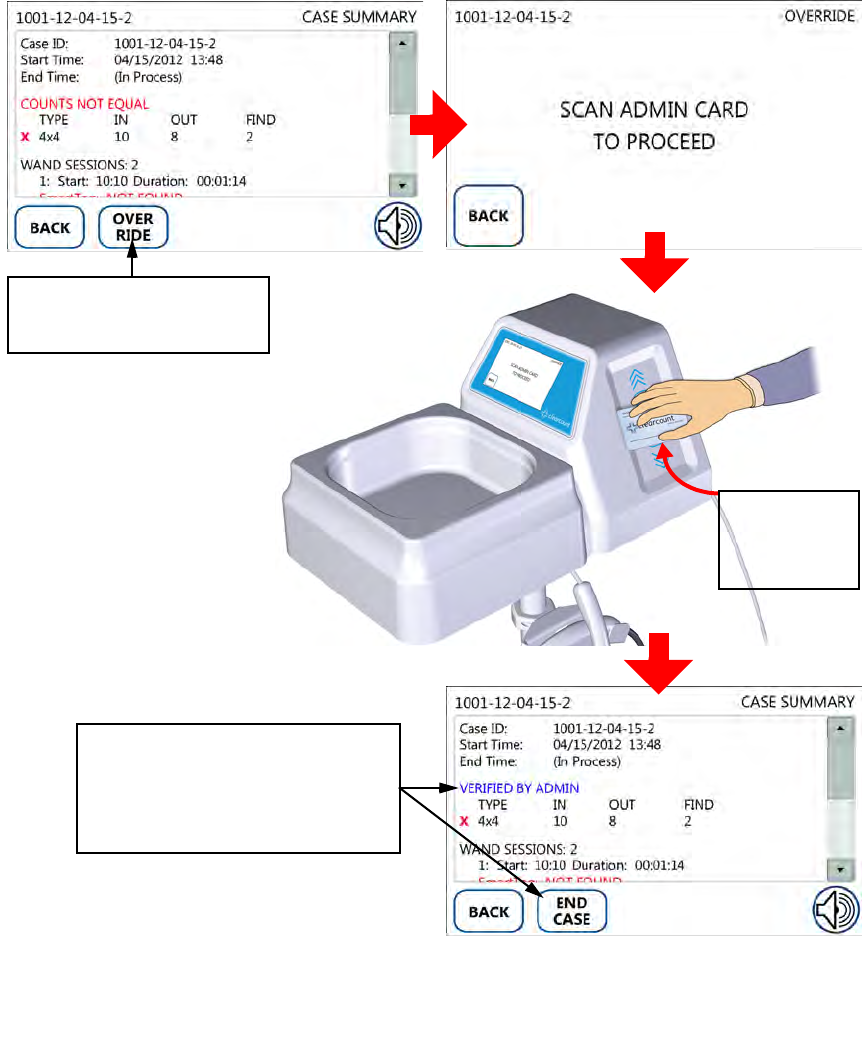
4-28
Chapter 4: System Operation
•
•
•
•
•
•
Figure 4-20 Case Summary Screen: COUNTS NOT EQUAL and VERIFIED BY ADMIN
Press the
OVERRIDE
button
to trigger the
SCAN ADMIN
CARD
screen.
After the Override Card is scanned,
“
VERIFIED BY ADMIN
” will appear
on the Case Summary. The
END
CASE
button will also be available to
close out the surgical case.
Swipe the
Override Card
across the
In Scanner
.

Chapter 4: System Operation 4-29
•
•
•
•
•
•
Ending a case with “COUNTS NOT EQUAL”:
Step 1 Press the
CASE SUMMARY
button located at the bottom of the screen.
Case Summary mode can be entered from any other mode. If the counts are not reconciled, the Case
Summary screen displays “
COUNTS NOT EQUAL
”. See
Figure 4-20
.
Step 2 With “COUNTS NOT EQUAL” displayed at the top of the Case Summary screen, press the
OVER RIDE button located at the bottom of the screen.
The “
SCAN ADMIN CARD TO PROCEED
” message will now be displayed on the OVERRIDE
screen. (Press BACK if you desire to return to the previous screen)
Step 3 The person responsible for the Override Card will need to present the card. Scan the Override
Card by placing it onto the In Scanner and holding it there until an audible alert is heard and the
system returns to the Case Summary screen.
“
VERIFIED BY ADMIN
” will now appear in the count status of the report. See
Figure 4-20
.
Step 4 Enter the Case ID into the patient’s record from the top line of the report.
Sponges may be intentionally withheld from the Count Out Basin for procedural or clinical reasons.
Alert the OR manager, and note this on the patient’s record along with the Case ID.
Step 5 Press the END CASE button to end the case.
The system will save the case data and return to Case Selection mode.
Step 6 Remove the System Cover that contains the discarded sponges from the Count Out Basin.
Dispose of the bagged items according to the standard protocol for your hospital.
Step 7 Clean the SmartSponge Flex according to the procedure in Chapter 7 before entering it into the
next surgical case.

4-30
Chapter 4: System Operation
•
•
•
•
•
•
Restoring Power
In the event of a power failure, move the power cord from a standard wall outlet to a red emergency powered
outlet if available. Ensure the On/Off switch remains in the On
( | )
position. When the system restarts it will
continue with the current case and advance to Standby mode. The screen will notify you that the case is in
progress. Press the appropriate button to enter the desired mode. The system will resume counting exactly
where it left off. Sponge counts are maintained in the event of power loss and are resumed when power returns.
If the power cord is accidentally unplugged during use from either the wall outlet or power entry module,
replace the power cord to the wall outlet and/or the power entry module. The system will automatically resume
back to the Standby screen as long as the On/Off switch is still in the On
( | )
position. Press the appropriate
button to enter the desired mode. All sponge counts are stored in the system’s database whenever there is a loss
of power. Sponge counts are resumed upon the return of power.

5-1
•
•
•
•
•
•
• • • • • •
Chapter 5: System Settings
Chapter 5 describes how to adjust the system’s settings. The settings available for adjustment include:
•
Edit Settings Mode
•
Edit: Date/Time
•
Adjust Screen Brightness
•
Adjust Screen Timeout
•
Calibrate Screen
•
Adjust Volume
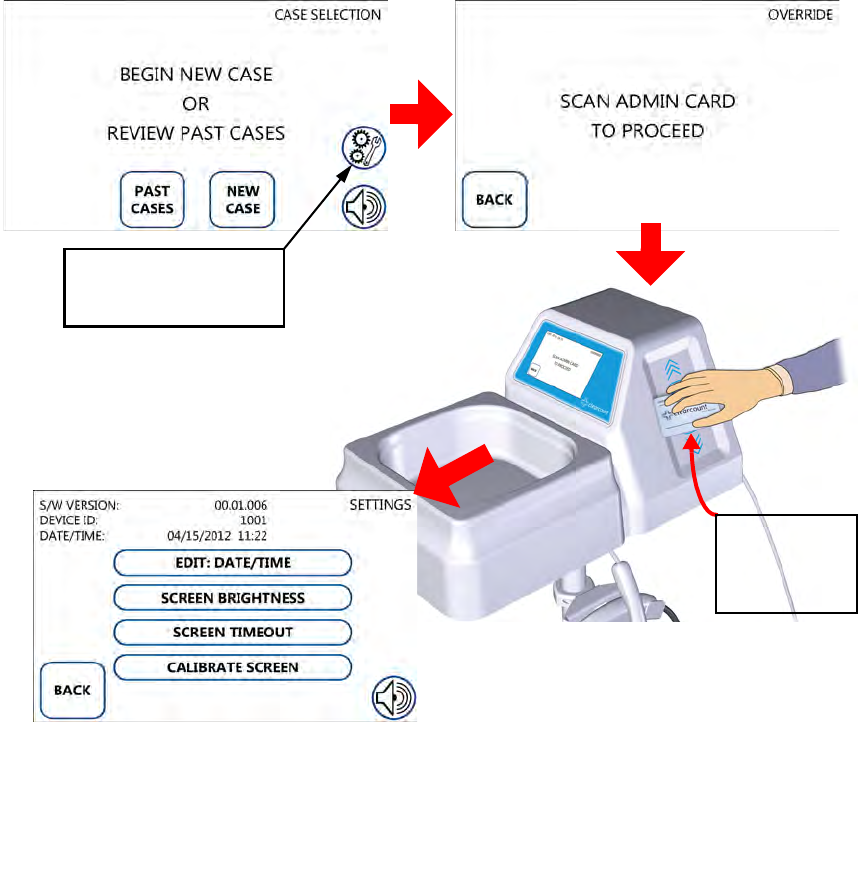
5-2
Chapter 5: System Settings
-
Edit Settings Mode
•
•
•
•
•
•
Edit Settings Mode
The SmartSponge Flex allows you to adjust some system settings and parameters to aid your use of the system.
Press the Edit Settings icon from the Case Selection screen to enter the Edit Settings mode. This will trigger
the Override screen. An Override Card will need to be placed on the In Scanner of the system to proceed to the
Edit Settings mode. The system will enter the Edit Settings mode after the Override Card is scanned.
Figure 5-1 Enter Edit Settings Mode
Swipe the
Override Card
across the
In Scanner
.
Press the
Edit Settings
Icon
to trigger the
OVERRIDE
screen.
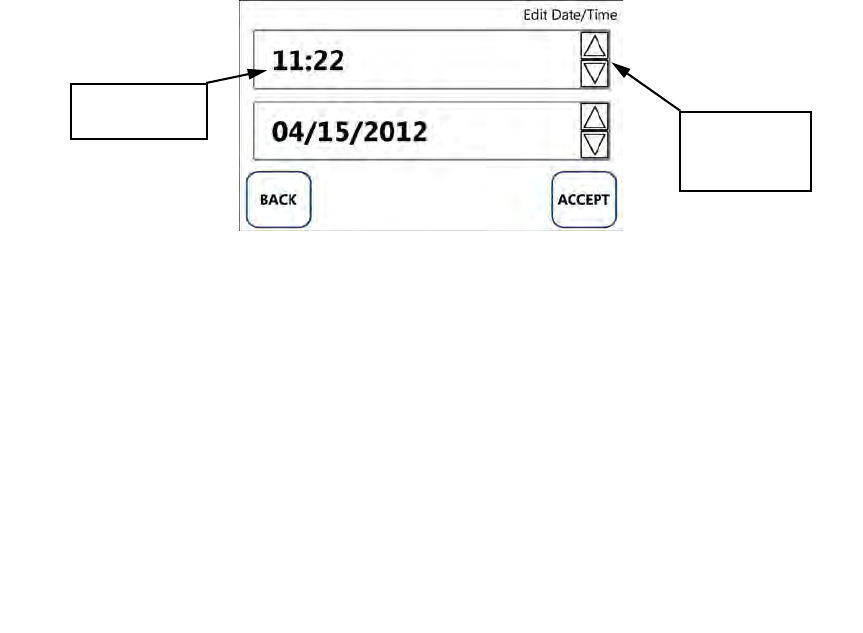
Chapter 5: System Settings - Edit Settings Mode 5-3
•
•
•
•
•
•
There are five adjustable items within the Edit Settings mode. They are described as follows:
Edit: Date/Time
Press “EDIT: DATE/TIME” from the Edit Settings mode screen, to adjust the system’s date and time. The Edit
Date/Time screen will appear where the system’s date and time can be adjusted with up and down arrows for
both the date and the time. Adjust a number within the screen, by pressing that number and then adjust its value
with the up and down arrows. When finished, press the ACCEPT button to save your changes or press the
CANCEL button to abandon the changes.
As a reference, the system’s date and time are displayed in the top middle of the Edit Settings screen, as well
as the Boot Up screen when system is first powered on.
Figure 5-2 Edit: Date/Time Screen
Select number
to change. Change value
with up and
down arrows.
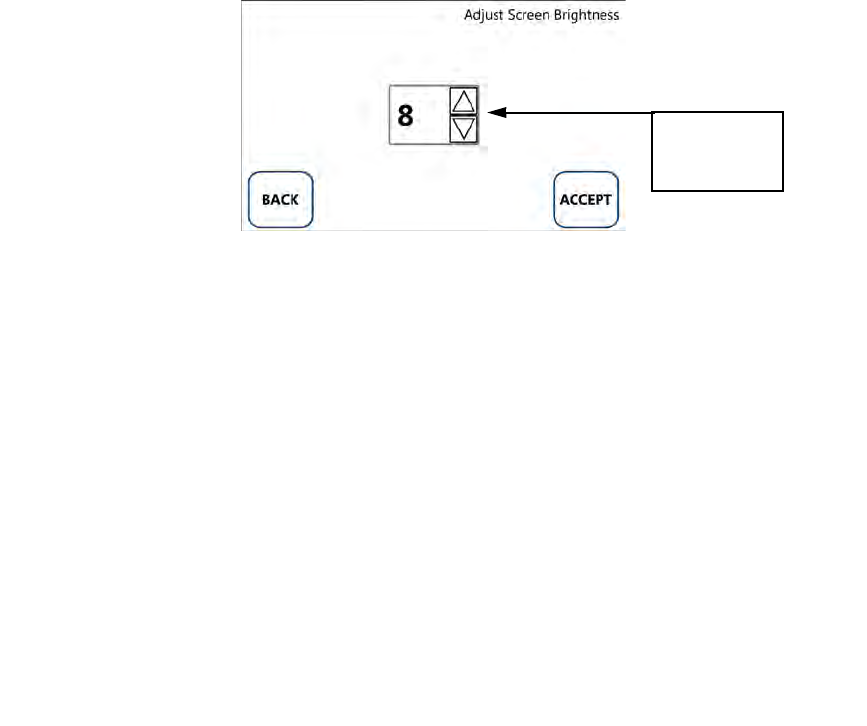
5-4
Chapter 5: System Settings
-
Edit Settings Mode
•
•
•
•
•
•
Adjust Screen Brightness
Press the “SCREEN BRIGHTNESS” button from the Edit Settings mode screen to adjust the brightness of the
display. This will bring up the Adjust Screen Brightness screen where the brightness can be adjusted from 2
(dimmest) to 10 (brightest). Press the up arrow to increase the brightness of the screen and the down arrow to
decrease it. When finished press the ACCEPT button to retain the new brightness or press the CANCEL button
to abandon the change.
By default the screen brightness will be set to the value of 8.
Figure 5-3 Adjust Screen Brightness Screen
Change value
with up and
down arrows.
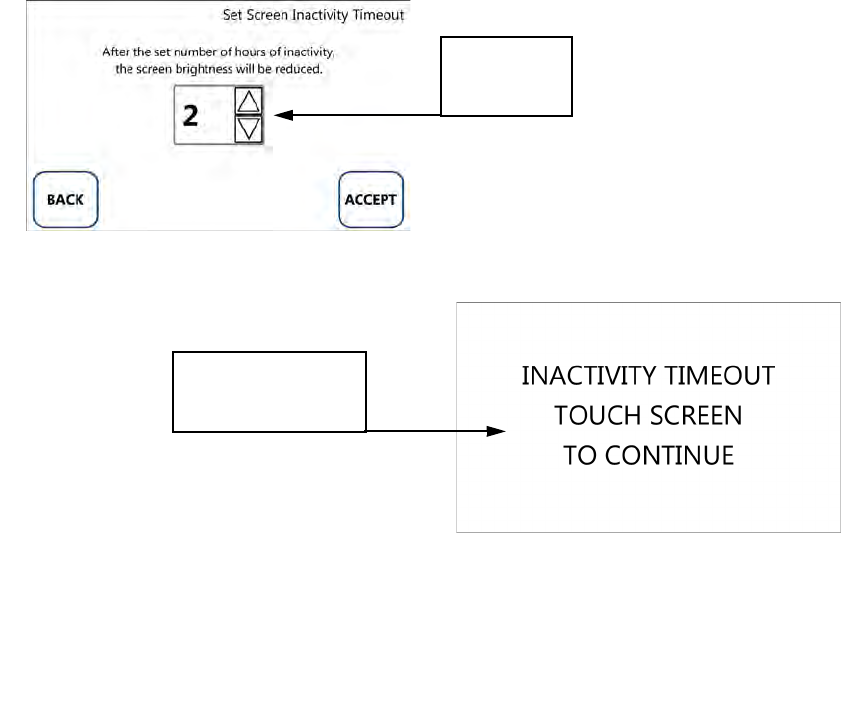
Chapter 5: System Settings - Edit Settings Mode 5-5
•
•
•
•
•
•
Adjust Screen Timeout
The system is set to dim the brightness of the display after a set number of hours of inactivity to prevent screen
burn in. If the system is set for 2 hours, an inactivity screen will appear and the display will be dimmed after
2 hours of no activity. Simply touch anywhere on the screen to restore the brightness back to the set level and
remove the inactivity message.
Press the “SCREEN TIMEOUT” button from the Edit Settings mode screen to set the inactivity timeout of the
display. This will bring up the Set Screen Inactivity Timeout screen where the hours of inactivity can be
adjusted from 1 hour up to 10 hours. Press the up and down arrows to adjust the amount of inactive time that
needs to pass before the display dims. When finished, press the ACCEPT button to retain the new time or press
the CANCEL button to abandon any changes.
The default inactivity timeout will be set to 2 hours.
Figure 5-4 Screen Timeout
Change value
with up and
down arrows.
Press anywhere on
the screen to restore
brightness.
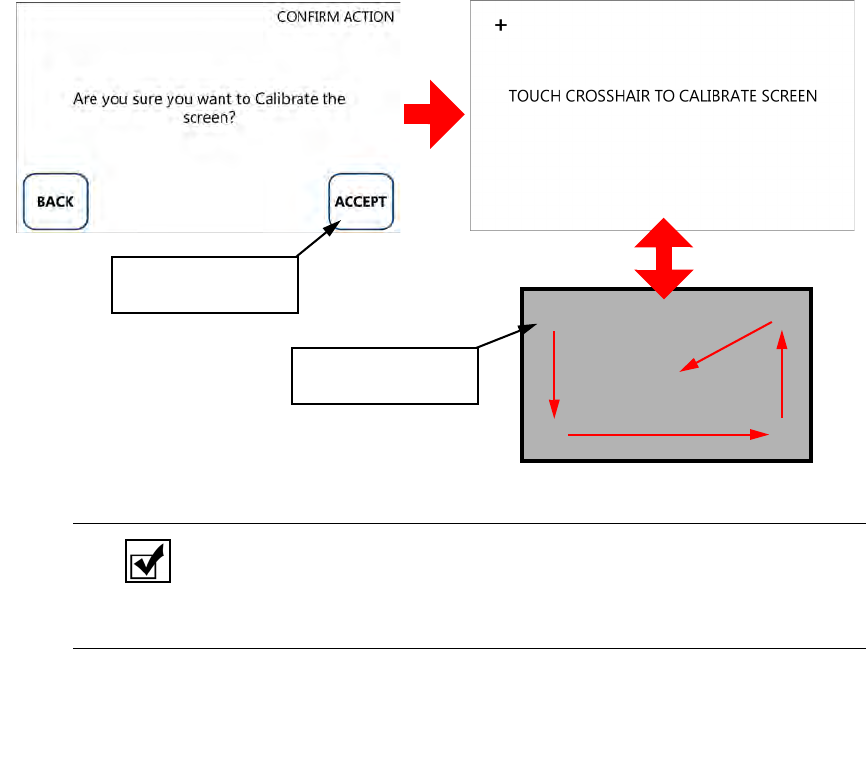
5-6
Chapter 5: System Settings
-
Edit Settings Mode
•
•
•
•
•
•
Calibrate Screen
The SmartSponge Flex uses a resistive touchscreen for interfacing with the system. This allows the screen to
be calibrated for precision. The screen should only be calibrated if buttons become difficult to activate.
Calibrating the screen will realign the point of contact with the system’s reference point.
To calibrate the screen, press the “CALIBRATE SCREEN” button from the Edit Settings screen; a CONFIRM
ACTION screen will follow. To proceed, press the ACCEPT button or press BACK to return to the Edit
Settings screen. After pressing ACCEPT, the screen will prompt you to touch the crosshairs as they appear on
the screen. The crosshairs will move after each touch, it will start in the upper left, move to the lower left, then
lower right, then upper right, and then back to the middle of the screen. Once the five points have been pressed
in a counterclockwise order, the system will return to the Edit Settings mode.
Figure 5-5 Calibrate Screen
Notes
•
It is important to press the crosshairs as precisely as possible to maintain
functionality of the system. If your touch is consistently off from the crosshairs the
system will reference a point not true to the point of contact made to the screen
after calibration is finished.
+
+
++
+
Touch the crosshairs
at each point.
Press ACCEPT to
calibrate the screen.
CROSSHAIR’S PATH
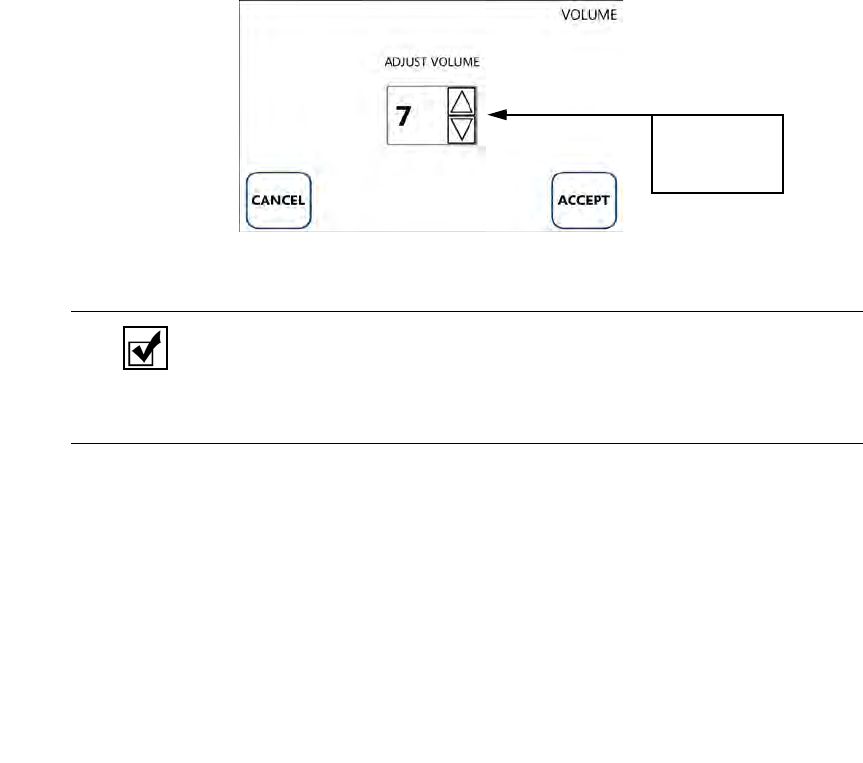
Chapter 5: System Settings - Edit Settings Mode 5-7
•
•
•
•
•
•
Adjust Volume
Press the VOLUME icon from the Edit Settings screen (or anywhere it appears) to adjust the system volume.
This will bring up the Volume screen where the system’s volume can be adjusted from 0 (off) to 10 (loudest).
Press the up arrow to increase the level and the down arrow to decrease it. When finished, press the ACCEPT
button to retain the new level or press the CANCEL button to abandon the change.
The level set on the Volume screen affects all sounds produced by the SmartSponge Flex; this includes system
alerts and warnings.
The default volume level will be set to the value of 7.
Figure 5-6 Volume Screen
Notes
•
The VOLUME icon appears within multiple system modes. Wherever the icon is
present, press it to adjust the volume.
•
If the volume is set too low, system alerts and warnings might become difficult to
notice.
Change value
with up and
down arrows.

5-8
Chapter 5: System Settings
-
Edit Settings Mode
•
•
•
•
•
•

6-1
•
•
•
•
•
•
• • • • • •
Chapter 6: Review Case Data
This chapter explains how to view data for the surgical cases completed by the SmartSponge Flex. The
operation available for reviewing case data is explained on the following pages.
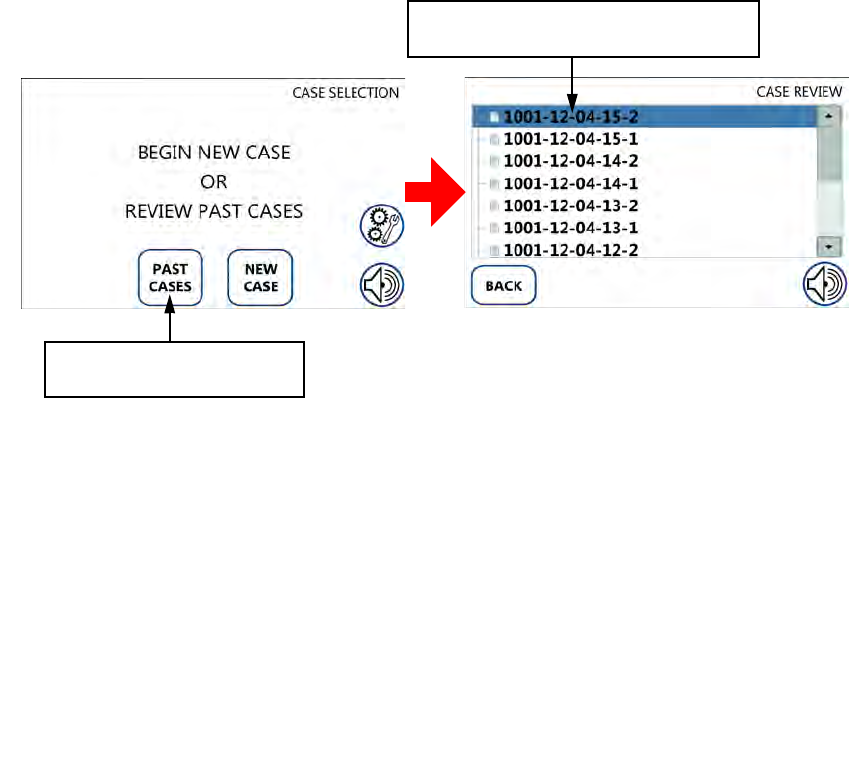
6-2
Chapter 6: Review Case Data
-
•
•
•
•
•
•
Review Case Data on the System
The SmartSponge Flex provides the operator with the ability to view the results of previous surgical cases
directly on the device.
To view data for each case stored on the device, press the PAST CASES button from the Case Selection screen.
This brings up the Case Review screen where all cases stored on the device are presented in a list with the most
recent on top. Press the Case ID for the particular case you would like to view or press the BACK button to
return to the previous screen.
Figure 6-1 Selecting a Case to Review
Press
PAST
CASES
to enter
the CASE REVIEW screen.
Press the CASE ID (1001-12-04-15-2)
to view that case’s data.
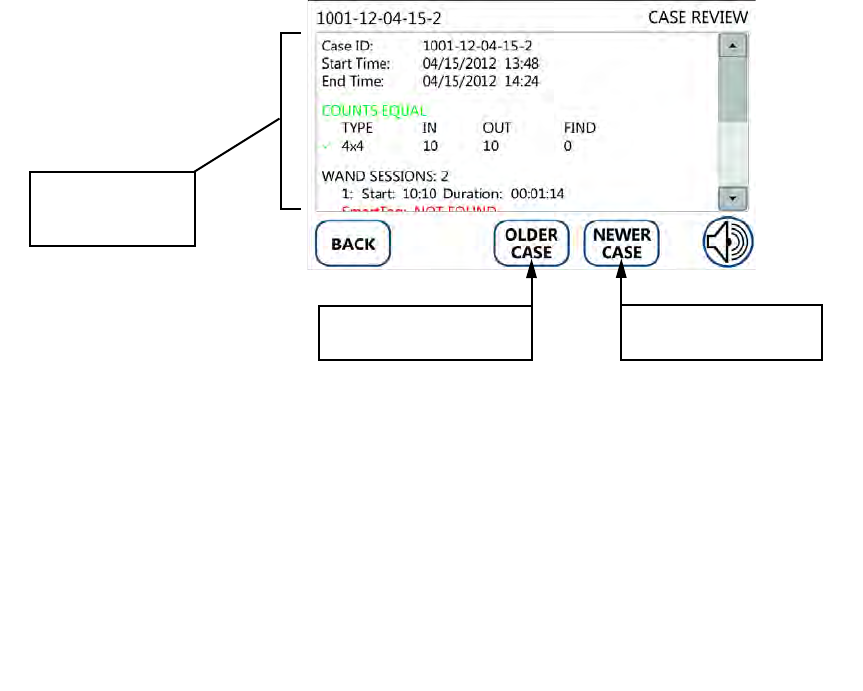
Chapter 6: Review Case Data - 6-3
•
•
•
•
•
•
Once you’ve selected a Case ID to view, the Case Review screen with the selected case’s information will
appear. The information for the case is formatted exactly like it was in the Final Report screen. Use the side
scroll bar to view all the information for the case.
You can also cycle through cases by pressing the NEWER CASE button to view the next newer case or press
the OLDER CASE button to view the next older case. Press the BACK button to return to the Case Review
screen where the Case IDs are vertically listed.
Figure 6-2 Case Review Screen
Press
OLDER CASE
to
view the previous case.
Press
NEWER CASE
to view the next case.
Case Information:
formatted the same
as Final Report.

6-4
Chapter 6: Review Case Data
-
•
•
•
•
•
•
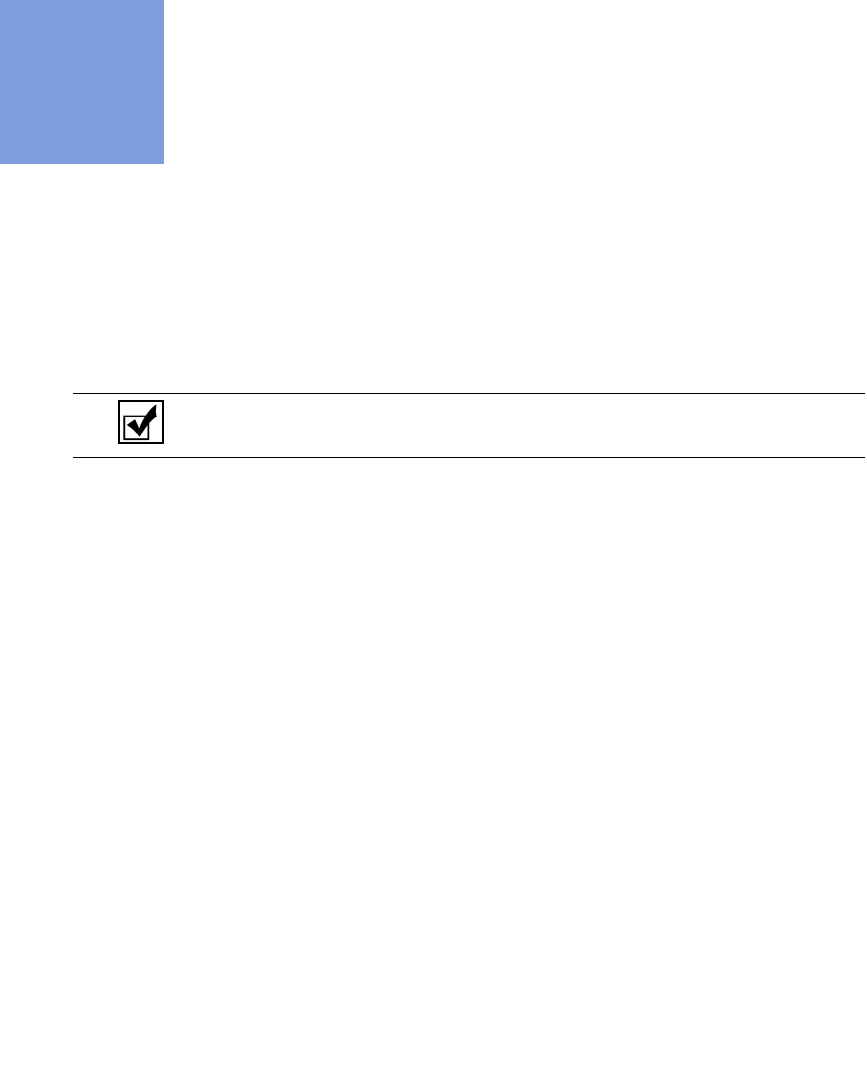
7-1
•
•
•
•
•
•
• • • • • •
Chapter 7: Cleaning and Maintenance
This chapter includes a post-surgery cleaning procedure for the SmartSponge Flex. Also included is
information regarding routine maintenance of the system.
Before cleaning the system or performing maintenance on it, check that:
•
The System is Off
•
The System is unplugged from its power source.
Notes
•
No disassembly is required prior to cleaning.
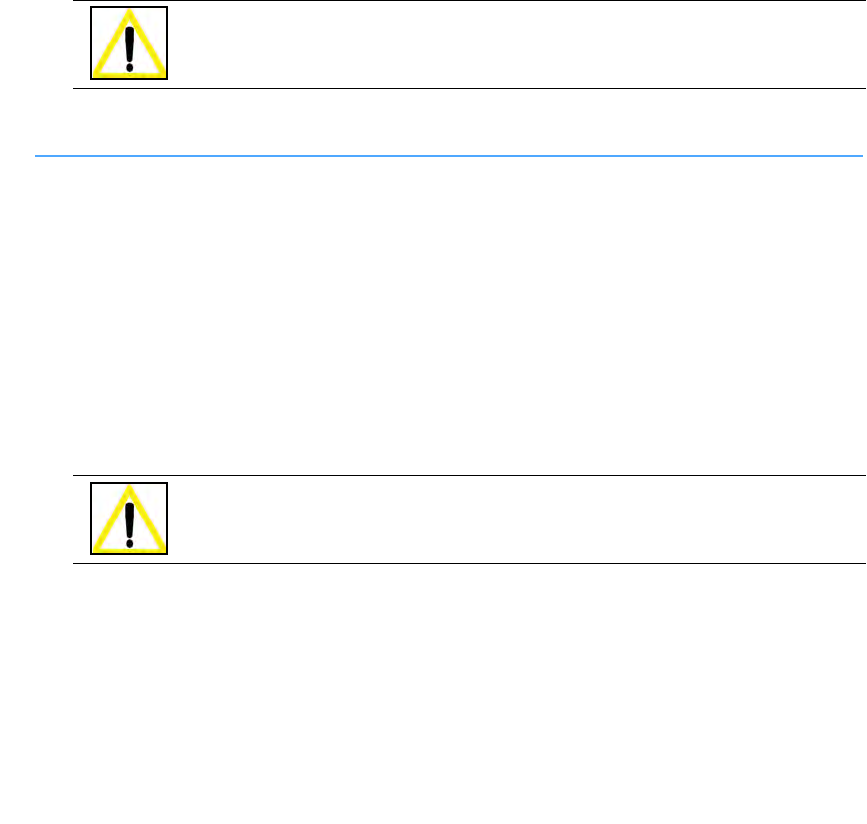
7-2
Chapter 7: Cleaning and Maintenance
-
Cleaning Instructions
•
•
•
•
•
•
Cleaning Instructions
Collect the following supplies for cleaning the SmartSponge Flex:
•
Disposable cloths
•
Rubber gloves
•
Hospital grade disinfectant solution. (Follow the disinfectant manufacturer’s instructions regarding the
duration of contact time for specific biological contaminants.)
Cleaning the System
Step 1 Unplug the power cord from the power entry module.
Step 2 Pre-clean surfaces by removing any contaminants with a damp cloth and wiping them dry.
Step 3 Wipe the entire length of the power cord with disinfectant.
Step 4 Wipe down the entire system; including the display, the In Scanner, all four sides of the Count
Out Basin (inside and outside), the SmartWand, its cable and holder, and all five casters with
disinfectant.
Step 5 After disinfectants dry on the surface or according to manufacturer’s instructions, rinse it with
a water-dampened cloth.
Warning!
The System needs to be unplugged from it’s power source before cleaning of the
device, wand, and cords can take place.
Caution!
Do not immerse the wand or apply cleaning fluids directly to the wand, but apply the
solution with a dampened cloth; otherwise damage to the electronics could occur.

Chapter 7: Cleaning and Maintenance - Maintenance 7-3
•
•
•
•
•
•
Maintenance
ClearCount recommends that routine maintenance be performed on the SmartSponge Flex according to the
following schedule:
Frequency Required Action Responsible Party
Per hospital protocol Follow the cleaning procedure. User
Prior to each use Visually inspect the SmartWand’s cord
and power cord for fraying and signs of
wear. Check for cracks or other damage
to system components. Make sure the
wand antenna is not bent and the wand
housing is not damaged.
User or maintenance personnel
Monthly Check for any damage to the wand
housing, wand antenna, display, the In
Scanner, the Count Out Basin, and the
power switch. Also check for correct
operation of the LEDs on the wand
housing by scanning a SmartTag and
SmartSponge.
Maintenance personnel
Annually Annual check per the service manual. ClearCount Medical Solutions
101 Bellevue Road
Pittsburgh, PA 15229
(888) 931-0787

7-4
Chapter 7: Cleaning and Maintenance
-
Maintenance
•
•
•
•
•
•

8-1
•
•
•
•
•
•
• • • • • •
Chapter 8: Troubleshooting
This chapter describes the alerts, warnings, and system failures that can occur while operating the
SmartSponge Flex.
This chapter is divided into the following sections:
•
System Alerts
•
System Warnings
•
System Failures
•
General troubleshooting
Each section contains a list of the error conditions, possible causes for each condition, and suggested actions
to help resolve the situation.
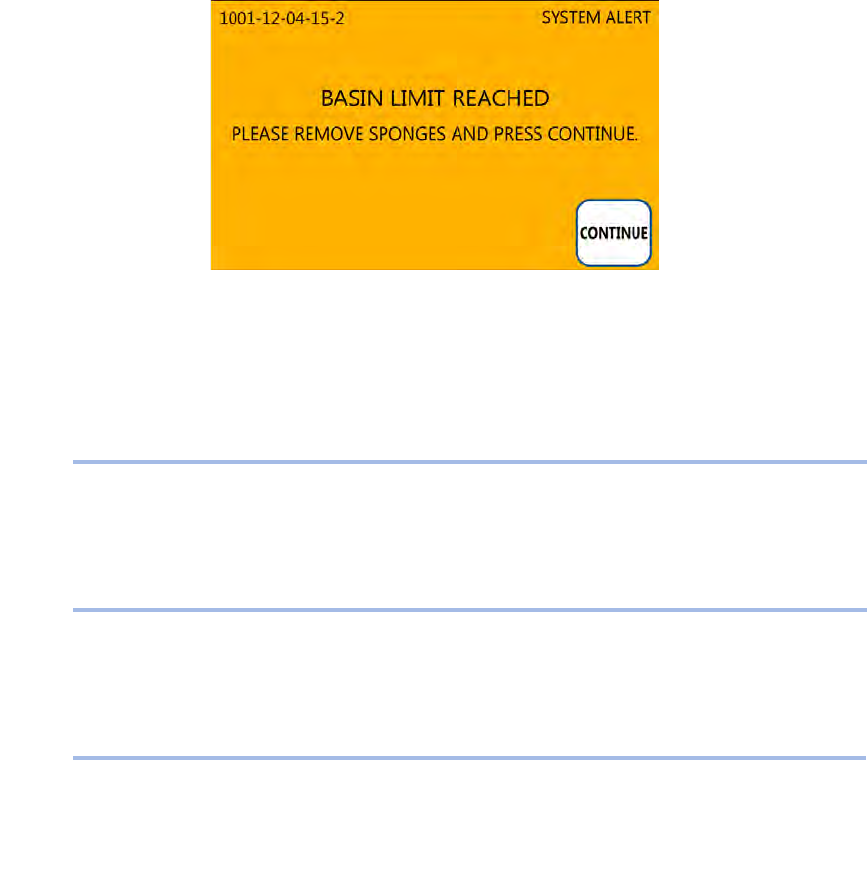
8-2
Chapter 8: Troubleshooting
-
System Alerts
•
•
•
•
•
•
System Alerts
System Alerts are temporary warning messages of which you should be aware to ensure proper operation of
the SmartSponge Flex. Correct the condition causing the alert, press CONTINUE, and the system will resume.
Figure 8-1 Example System Alert Message Screen
Discard Pack
Multiple Packs Detected - Remove and Scan One Pack at a Time
Pack Already Scanned
CAUSE:
The system has detected a problem with the
sponge pack.
ACTION:
Discard the sponge pack and resume scanning with a
new pack.
CAUSE:
The system is unable to scan in multiple packs
at the same time.
ACTION:
Ensure that only one pack of sponges is being placed on
the In Scanner at a time.
CAUSE:
The sponge pack has already been counted.
ACTION:
The sponge pack is ready for use - continue with system
setup or operation.

Chapter 8: Troubleshooting - System Alerts 8-3
•
•
•
•
•
•
Basin Limit Reached
Wand Not Functioning
CAUSE:
There are over
20
sponges in the Count Out
Basin.
ACTION:
Remove sponges or discard the full bag and replace with
a new liner - sponge counts will not change.
Each additional sponge or group of sponges discarded
into the Out Scan after its capacity is already at
20
will
trigger this System Alert.
CAUSE:
The SmartWand is either not connected,
detuned due to its proximity to metal (still in
the wand hanger), or experiencing a hardware
malfunction.
ACTION:
Ensure that the SmartWand is properly plugged into the
system and that it is adequately spaced from metal (this
includes the wand hanger).

8-4
Chapter 8: Troubleshooting
-
System Warnings
•
•
•
•
•
•
System Warnings
System Warnings are serious conditions that have been caused by misuse of the SmartSponge Flex. To correct
a system warning condition, follow the onscreen instructions and press the CONTINUE button to resume
system operation.
Figure 8-2 Example Warning Message Screen
Basin Limit Exceeded
Broken Protocol
CAUSE:
There are
30
or more sponges in the Count Out
Basin.
ACTION:
Remove sponges and separate into groups of no more
than
20
- Press the CONTINUE button and then reinsert
the groups into the Count Out Basin one group at a time
to assure all sponges have been accounted for.
(The system suspends counting while in this warning
screen)
To assure accurate counting, there should never be more
than
20
sponges in the Count Out Basin at a time.
CAUSE:
Sponges that were not scanned in first have
been detected by the Count Out Basin.
ACTION:
Ensure that sponges are first scanned into the case with
the In Scanner and are then deposited into the Count Out
Basin after they are used in surgery.
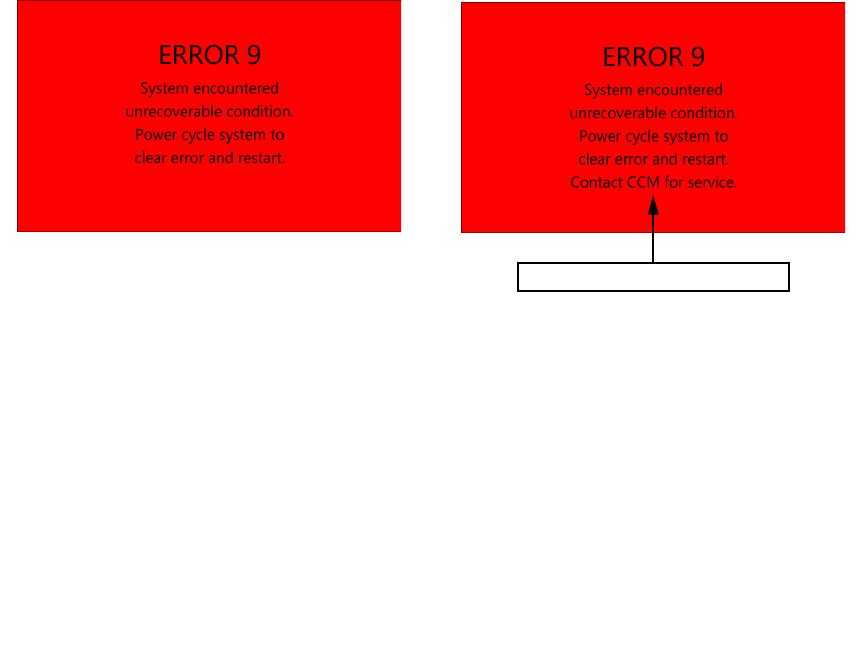
Chapter 8: Troubleshooting - System Failure 8-5
•
•
•
•
•
•
System Failure
A system failure is a serious condition that will cause the SmartSponge Flex to stop working.
If you receive a system failure message:
•
Power cycle the system to clear the error and restart. Do this by flipping the power switch off and
then back on to restart the system. Resume normal operation if the error no longer appears.
•
If you are unable to clear the error and the same error appears two or more times within a five day
period, the message “Contact CCM for service” will appear onscreen.
•
If this happens, contact ClearCount for service and provide accurate information about the
circumstances that may have caused the error and what is presented on the screen.
•
Power down the system.
After a system error that cannot be cleared, the system should diagnosed by service personnel.
Figure 8-3 Example System Failure Screen
For additional information please call ClearCount Customer Service at
1-888-931-0787
Error Screen when first triggered.
Error Screen after two or more of the
same error are triggered within five days.
Note to contact CCM service.

8-6
Chapter 8: Troubleshooting
-
General Troubleshooting
•
•
•
•
•
•
General Troubleshooting
This section contains general troubleshooting information to help you resolve issues that may arise while
operating the SmartSponge Flex.
SmartSponge Flex Will Not Turn On
Wand is Not Detecting a Sponge
CAUSE:
Power cord is not plugged into the
SmartSponge Flex or wall outlet.
ACTION:
Ensure that both ends of the power cord are plugged in.
Power cord is damaged. Call ClearCount Medical Solutions for replacement
cord.
Power is not available at power outlet. Check that the power source is working properly.
SmartSponge Flex failure. Call ClearCount Medical Solutions.
CAUSE:
Operator is moving the wand too quickly.
ACTION:
Scan at a rate no faster than 0.2m/sec (7 inches/sec).
Operator is not following the recommended
scan paths. Complete all recommended scan paths, per the onscreen
instructions.
System has not been placed into wand mode. Place the system into wand mode and scan the patient.
Wand is effected by other equipment. Remove active electro-surgical equipment from the
vicinity of the wand, or wait until ES equipment is no
longer in use.
Wand has been placed closer than 2 inches to
the body of the patient. Hold the wand at least 2 inch away from the patient and
re-scan.
Wand has been held too far from the patient. Hold the wand within 3 inches of patient while
performing a re-scan.

Chapter 8: Troubleshooting - General Troubleshooting 8-7
•
•
•
•
•
•
System Indicates Wand Failure
Wand LED Indicators Fail to Indicate that SmartTag is Present
CAUSE:
Wand has been placed on or near a metal
surface.
ACTION:
Move wand away from metal, and allow 20 seconds for
the wand to adjust.
Wand is experiencing interference from other
surgical equipment. Move the wand away from the interfering equipment, or
wait until the equipment is no longer in use.
Wand cable is disconnected. Connect wand cable.
Wand cable is damaged. Call ClearCount Medical Solutions for a replacement.
Wand has been placed on the Count In Scanner
of the device or over the Out Scan. Move wand away from the system.
Wand electronics have failed. Call ClearCount Medical Solutions for a replacement
wand.
CAUSE:
Wand has not been placed over the SmartTag.
ACTION:
Ensure a SmartTag is present and re-scan the patient.
SmartTag has been moved or was not placed
prior to surgery. Continue without the SmartTag. (unable to verify scan
depth)
Wand cable is damaged. Call ClearCount Medical Solutions for a replacement.
Wand cable is disconnected. Connect cable.
Patient is too large to detect the SmartTag
through the patient. Scan the patient despite not being able to detect the
SmartTag.
The wrong type of SmartTag has been placed
on the OR table. Ensure the correct SmartTag is used on the OR table.
Refer to Chapter 2.
SmartTag has been placed directly on top of
large reusable capacitively-coupled return
electrode pad.
Place the SmartTag lateral to the large reusable
capacitively-coupled return electrode pad.
Wand electronics have failed. Call ClearCount Medical Solutions for a replacement
wand.

8-8
Chapter 8: Troubleshooting
-
General Troubleshooting
•
•
•
•
•
•
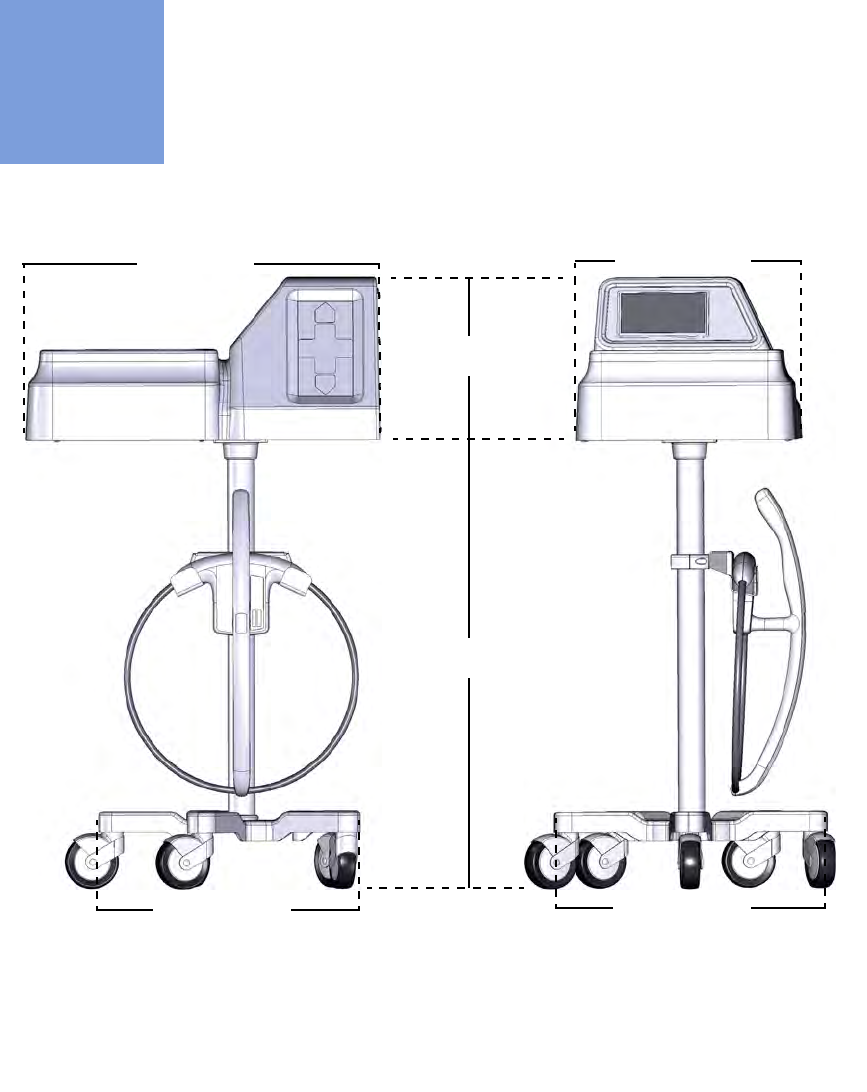
A-1
•
•
•
•
•
•
• • • • • •
Appendix A: Technical Specifications
SmartSponge® Flex System Dimensions
Figure A-1 SmartSponge Flex Model A04 System Dimensions
System Weight - 38 lbs (17.2 kg)
FRONT
SIDE
26” (66 cm) 16” (40.6 cm)
12” (30 cm) device
34” (86 cm) cart
23” (58.5 cm) 23” (58.5 cm)
Cart Weight - 35 lbs (15.8 kg)

A-2 Appendix A: Technical Specifications
-
Power Requirements
•
•
•
•
•
•
Power Requirements
Environmental Conditions
SmartSponge Flex Sponges and Towels
•
All SmartSponge Sponges and Towels are constructed of 100% cotton.
•
ClearCount RFID tags are encapsulated in bio-compatible epoxy.
MRI Information
MR Conditional
Non-clinical testing demonstrated that the ClearCount RFID Tag is MR Conditional. A patient
with a ClearCount RFID tagged item can be scanned safely, immediately after placement under
the following conditions:
Static Magnetic Field
•
Static magnetic field of 3-Tesla or less
•
Maximum spatial gradient magnetic field of 720-Gauss/cm or less
MRI-Related Heating
•
Maximum MR system reported whole-body-averaged specific absorption rate (SAR) of 3-W/kg for 15
minutes of scanning (i.e., per pulse sequence).
In non-clinical testing, the ClearCount RFID tag produced a temperature rise of less than or equal to 3.0
degrees C at a maximum MR system-reported whole body averaged specific absorption rate (SAR) of 3-W/kg
for 15-minutes of MR scanning in a 3-Tesla MR system using a transmit/receive body coil (Excite, Software
G3.0-052B, General Electric Healthcare, Milwaukee, WI).
Artifacts
MR image quality may be compromised if the area of interest is in the exact same area of relatively close to
the position of the ClearCount RFID tag. Therefore, optimization of MR imaging parameters to compensate
for the presence of this implant/device may be necessary.
Attention:
Contact ClearCount Medical Solutions for further information, as needed.
Power supply: 120 - 240 VAC, 50/60 Hz, 60 W
Power consumption: 0.65 Amps at 120 VAC
Outlet requirement: standard, single-phase, grounded three-prong outlet
Power cord length: 20 feet
Internal fuse rating: 3 Amp, fast acting on Neutral (N) and Line (L)
Operating Temperatures:
Ambient temperature: 50°F to 104°F (+10°C to +40°C)
Relative humidity 30 to 75%
Atmospheric pressure 700 to 1060 hPa
Transport and Storage Temperatures:
Ambient temperature: -40°F to 158°F (-40°C to +70°C)
Relative humidity: 10 to 95% noncondensing
Atmospheric pressure: 500 to 1060 hPa

Appendix A: Technical Specifications - EMC Considerations A-3
•
•
•
•
•
•
EMC Considerations
The ClearCount SmartSponge Flex needs special precautions regarding Electromagnetic Compatibility
(EMC), and must be installed and put into service according to the EMC information provided in this manual.
Portable and mobile RF equipment can affect the ClearCount SmartSponge Flex.
Compatibility of cables, transducers, and other accessories: Not applicable.
Guidance and Manufacturer’s Declaration – Emissions
All Equipment and Systems
Guidance and Manufacturer’s Declaration - Emissions
The ClearCount SmartSponge Flex Model A04 is intended for use in the electromagnetic environment
specified below. The customer or user of the ClearCount SmartSponge Flex Model A04 should ensure that it
is used in such an environment.
Emissions Test Compliance Electromagnetic Environment – Guidance
RF Emissions
CISPR 11
Group 2 The ClearCount SmartSponge Flex Model A04 must emit
electromagnetic energy in order to perform its intended
function. Nearby electronic equipment may be affected.
RF Emissions
CISPR 11
Class B The ClearCount SmartSponge Flex Model A04 is suitable
for use in all establishments, including domestic, and those
directly connected to the public low-voltage power supply
network that supplies buildings used for domestic purposes.
Harmonics
IEC 61000-3-2
Class A
Flicker
IEC 61000-3-3
Complies

A-4 Appendix A: Technical Specifications
-
EMC Considerations
•
•
•
•
•
•
Guidance and Manufacturer’s Declaration – Immunity
All Equipment and Systems
Guidance and Manufacturer’s Declaration – Immunity
The ClearCount SmartSponge Flex Model A04 is intended for use in the electromagnetic environment
specified below. The customer or user of the SmartSponge Flex Model A04 should ensure that it is used in
such an environment.
Immunity Test IEC 60601 Test
Level Compliance
Level Electromagnetic Environment –
Guidance
ESD
IEC 61000-4-2
±6kV Contact
±8kV Air
±6kV Contact
±8kV Air
Floors should be wood, concrete or
ceramic tile. If floors are synthetic, the r/h
should be at least 30%.
EFT
IEC 61000-4-4
±2kV Mains
±1kV I/Os
±2kV Mains
No I/Os
Main power quality should be that of a
typical commercial or hospital
environment.
Surge
IEC 61000-4-5
±1kV Differential
±2kV Common
±1kV Differential
±2kV Common
Main power quality should be that of a
typical commercial or hospital
environment.
Voltage Dips/Dropout
IEC 61000-4-11
>95% Dip for 0.5
Cycle >95% Dip for
0.5 Cycle
Main power quality should be that of a
typical commercial or hospital
environment. If the user of the ClearCount
SmartSponge Flex Model A04 requires
continued operation during power mains
interruptions, it is recommended that the
ClearCount SmartSponge Flex Model
A04 be powered from a power source that
has automatic emergency backup.
60% Dip for
5 Cycles
60% Dip for
5 Cycles
30% Dip for
25 Cycles
30% Dip for
25 Cycles
>95% Dip for
5 Seconds
>95% Dip for
5 Seconds
Power Frequency
50/60Hz
Magnetic Field
IEC 61000-4-8
3 A/m 3 A/m Power frequency magnetic fields should
be that of a typical commercial or hospital
environment.
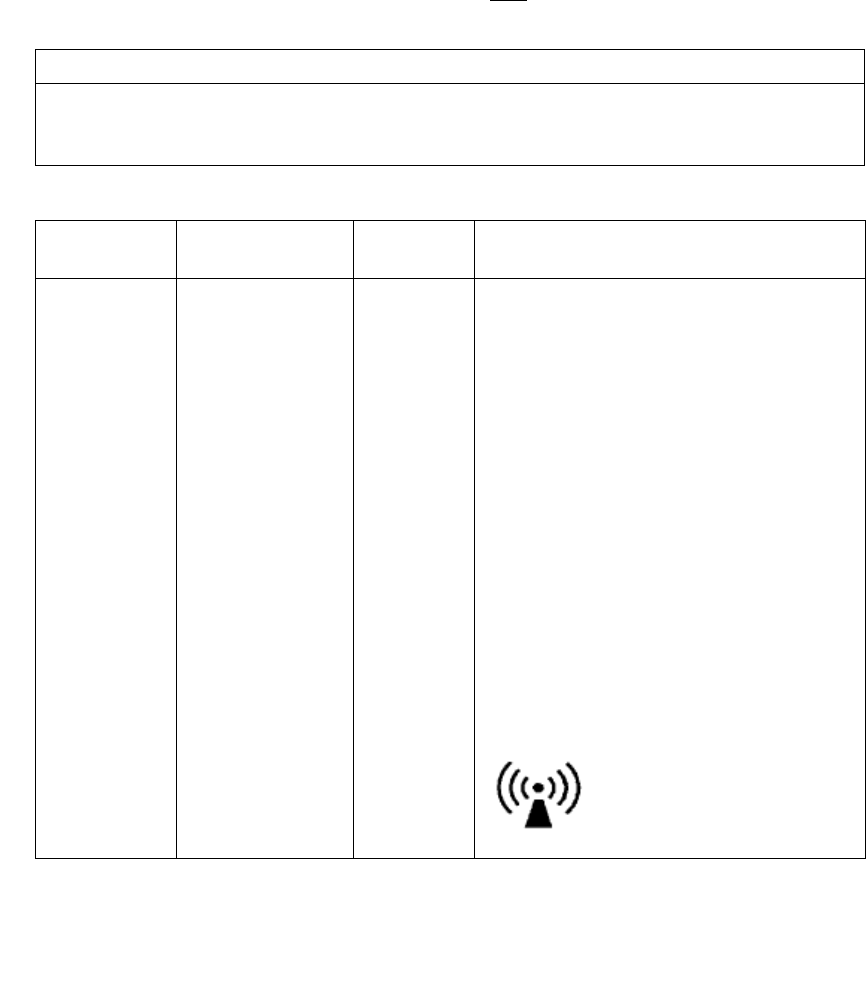
Appendix A: Technical Specifications - EMC Considerations A-5
•
•
•
•
•
•
Guidance and Manufacturer’s Declaration – Emissions
Equipment and Systems that are NOT Life-supporting
Guidance and Manufacturer’s Declaration – Emissions
The ClearCount SmartSponge Flex Model A04 is intended for use in the electromagnetic environment
specified below. The customer or user of the ClearCount SmartSponge Flex Model A04 should ensure that it
is used in such an environment.
Immunity Test IEC 60601 Test
Level Compliance
Level Electromagnetic Environment – Guidance
Conducted RF
IEC 61000-4-6
Radiated RF
IEC 61000-4-3
3 Vrms
150 kHz to 80 MHz
3 V/m
80 MHz to 2.5 GHz
3Vrms
3V/m
Portable and mobile communications equipment
should be separated from the ClearCount
SmartSponge Flex Model A04 by no less than the
distances calculated/listed below:
D=(3.5/3)(Sqrt P)
D=(3.5/3)(Sqrt P)
80 to 800 MHz
D=(7/3)(Sqrt P)
800 MHz to 2.5 GHz
where P is the max power in watts and D is the
recommended separation distance in meters.
Field strengths from fixed RF transmitters, as
determined by an electromagnetic site survey
a
,
should be less than the compliance level in each
frequency range
b
.
Interference may occur in the
vicinity of equipment marked
with the following symbol:
.

A-6 Appendix A: Technical Specifications
-
EMC Considerations
•
•
•
•
•
•
NOTE 1 At 80 MHz and 800 MHz, the higher frequency range applies.
NOTE 2 These guidelines may not apply in all situations. Electromagnetic propagation is affected by
absorption and reflection from structures, objects and people.
Field strengths from fixed transmitters, such as base stations for radio (cellular/cordless) telephones and land
mobile radios, amateur radio, AM and FM radio broadcast and TV broadcast cannot be predicted
theoretically with accuracy. To assess the electromagnetic environment due to fixed RF transmitters, an
electromagnetic site survey should be considered. If the measured field strength in the location in which the
ClearCount SmartSponge Flex Model A04 is used exceeds the applicable RF compliance level above, the
ClearCount SmartSponge Flex Model A04 should be observed to verify normal operation. If abnormal
performance is observed, additional measures may be necessary, such as re-orienting or relocating the
ClearCount SmartSponge Flex Model A04.
Over the frequency range 150 kHz to 80 MHz, field strengths should be less than 3 V/m.
NOTE: This equipment has been tested and found to comply with the limits for a Class A digital device,
pursuant to part 15 of the FCC rules. These limits are designed to provide reasonable protection against
harmful interference when the equipment is operated in a commercial environment. This equipment
generates, uses, and can radiate radio frequency energy and, if not installed and used in accordance with the
instruction manual, may cause harmful interference to radio communications. Operation of this equipment in
a residential area is likely to cause harmful interference in which case the user will be required to correct the
interference at his own expense.

Appendix A: Technical Specifications - EMC Considerations A-7
•
•
•
•
•
•
Recommended Separation Distances between portable and mobile RF Communications equipment and the
ClearCount SmartSponge Flex Model A04
Equipment and Systems that are NOT Life-supporting
The SmartSponge Flex contains a receiver operating at a frequency of 13.56 MHz +/- 7 kHz.
The SmartSponge Flex may be interfered with by other equipment, even if that other equipment complies with
CISPR EMISSION requirements. If abnormal behavior is observed, please refer to the separation distance
chart provided in this appendix.
The SmartSponge Flex contains a transmitter operating at a frequency of 13.56 MHz, using 10% amplitude
shift keying at a modulation frequency of 423.75 kHz, and maximum effective radiated power of 200 mW.
Recommended Separations Distances for the
SmartSponge Flex Model A04
The ClearCount SmartSponge Flex Model A04 is intended for use in the electromagnetic environment in
which radiated disturbances are controlled. The customer or user of the ClearCount SmartSponge Flex Model
A04 can help prevent electromagnetic interference by maintaining a minimum distance between portable and
mobile RF Communications Equipment and the ClearCount SmartSponge Flex Model A04 as recommended
below, according to the maximum output power of the communications equipment.
Max Output Power
(Watts)
Separation (m)
150 kHz to 80MHz
D=(3.5/3)(Sqrt P)
Separation (m)
80 to 800MHz
D=(3.5/3)(Sqrt P)
Separation (m)
800MHz to 2.5GHz
D=(7/3)(Sqrt P)
0.01 .1166 .1166 .2333
0.1 .3689 .3689 .7378
1 1.1666 1.1666 2.3333
10 3.6893 3.6893 7.3786
100 11.6666 11.6666 23.3333
For transmitters rated at a maximum output power not listed above, the recommended separation distance
d
in meters (m) can be determined using the equation applicable to the frequency of the transmitter, where
P
is
the maximum output power rating of the transmitter in watts (W) according to the transmitter manufacturer.
NOTE 1 At 80 MHz and 800 MHz, the separation distance for the higher frequency range applies.
NOTE 2 These guidelines may not apply in all situations. Electromagnetic propagation is affected by
absorption and reflection from structures, objects and people.
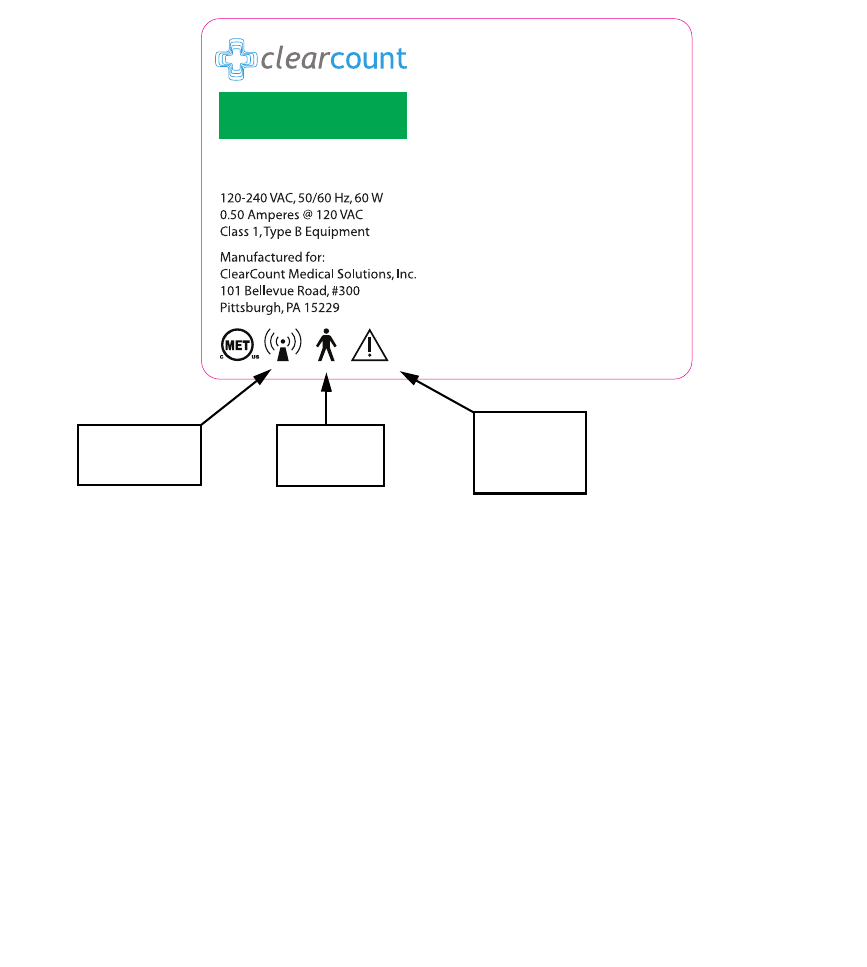
A-8 Appendix A: Technical Specifications
-
Device Label
•
•
•
•
•
•
Device Label
Figure A-2 Device Label
This product and its use are covered by
one or more of the following U.S. Patents:
5,650,596, 5,923,001, 6,998,541, other
patents pending.
FCC ID: WWQCCMS004
This device complies with Part 15 of FCC
rules. Operation is subject to the following
two conditions: 1) this device may not
cause harmful interference and, 2) this
device must accept any interference
received, including interference that may
cause undesired operation.
Changes or modifications not expressly
approved by the party responsible for
compliance could void the user’s authority
to operate the equipment.
The System contains no user replaceable
fuses. Any attempt to service this device
by the user will result in voiding of any and
all warranties.
SmartSponge® Flex
Model A04
Read
instructions
prior to use
Type B
equipment
Non-ionizing
radiation
